Anson Street African Burial Ground Project
For this project, we are conducting bioarchaeological and genetic analyses with 18th century African-descended individuals, and genetic studies with local African American individuals, in an effort to connect Charleston’s historical past with today’s living community and highlight the crucial role of Africans in the cultural and historical development of this city.
The following summary of our project work has been written by Joanna Gilmore, T.G. Schurr, Raquel Fleskes, La’Sheia Oubré, and Ade Offuniyin.
Historical, Archaeological & Osteological Research 2013-17
In February 2013, thirty-seven graves were uncovered during the construction at the Gaillard Center in Charleston, on the corner of George and Anson Streets.
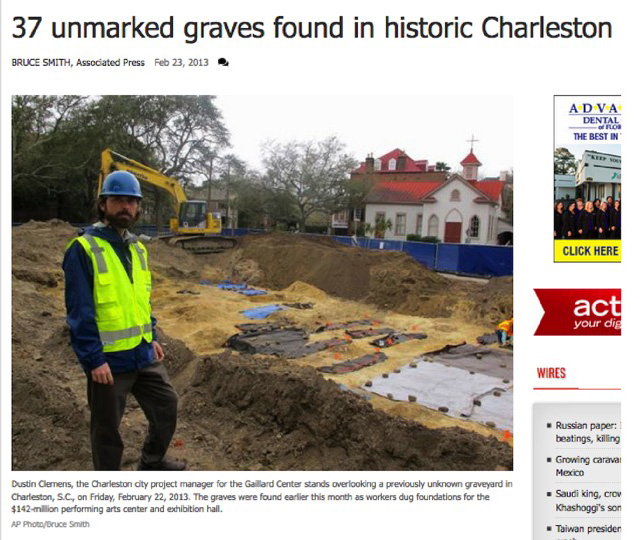
Article from the 23 February 2013 issue of The Post & Courier about the Anson Street Burial Excavation in Charleston
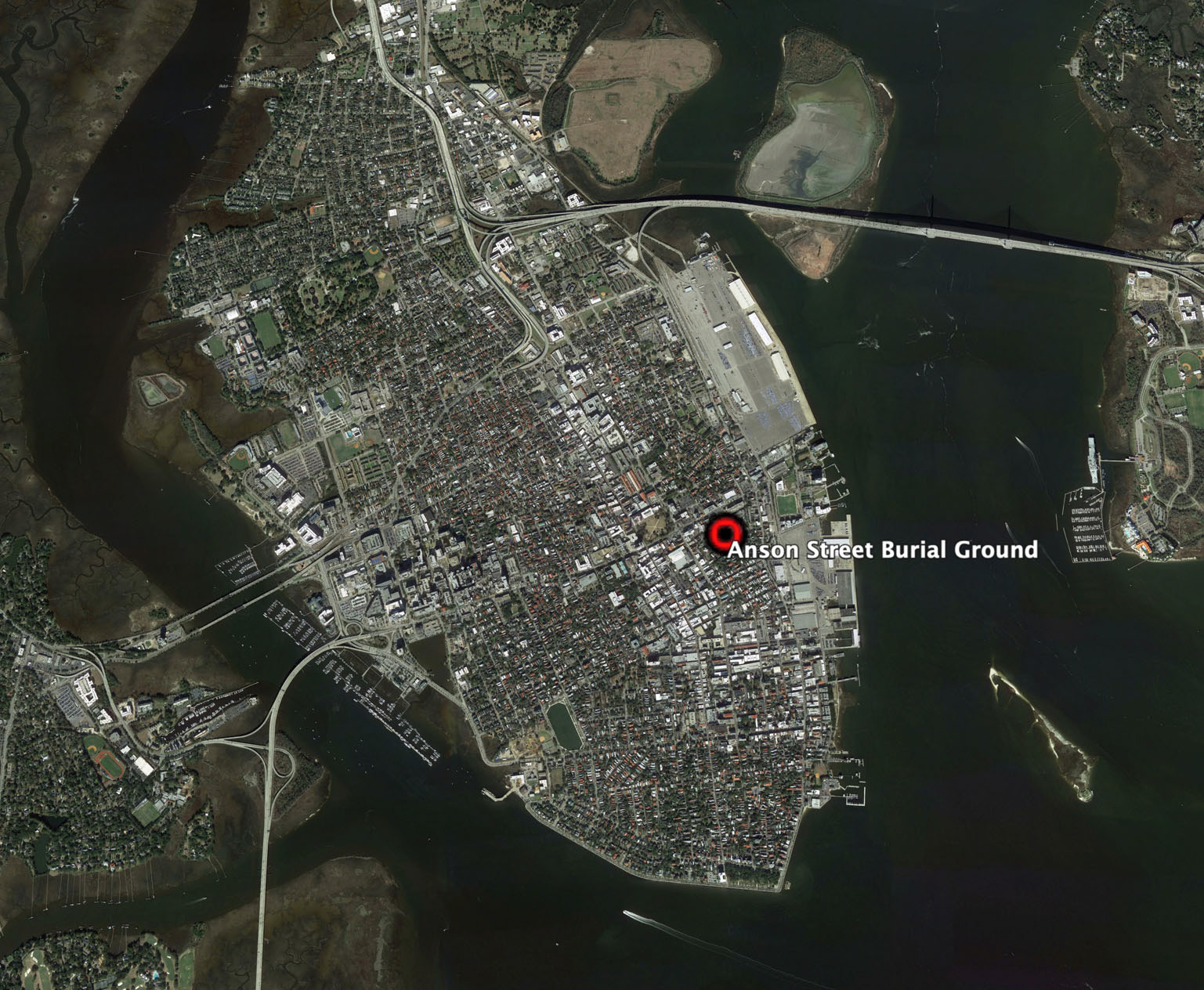
Map of the Anson Street African Burial Ground on the peninsula of Charleston, SC (USA). Image produced using Google Earth Pro by Grant Mishoe.
Through the 18th century, the land bounded by modern Calhoun, Anson and Laurens Streets passed between a number of owners, although no evidence of a marked burying ground or cemetery has been found (Poplin 2013). Archival and archaeological evidence of 19th century refuse pits and debris indicates that the burials pre-date the subdivision and residential development of this area around 1800 (Poplin 2013).
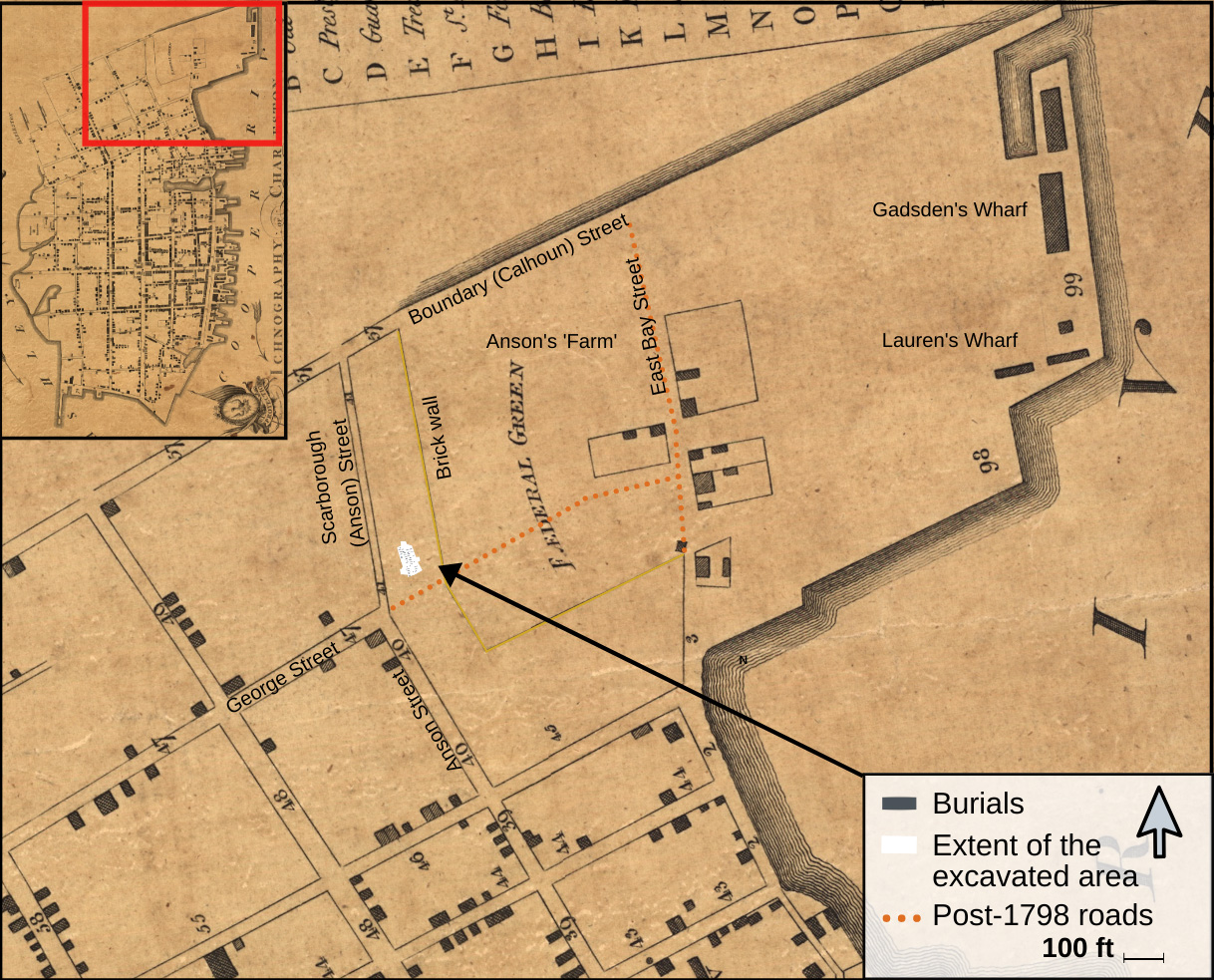
Location of the Anson Street African Burial Ground in Historical Plat Maps through Time. The small map in the upper left corner displays an 1790 map, with contemporary street names and labels. The large map displays an 1790 map, with contemporary street names and labels. The white colored area identifies the Anson Street burial ground. This map was obtained from the Library of Congress (Petrie et al., 1790) with assistance from Brockington and Associates, Inc., N. Butler, and J. Gilmore to identify the burial ground.
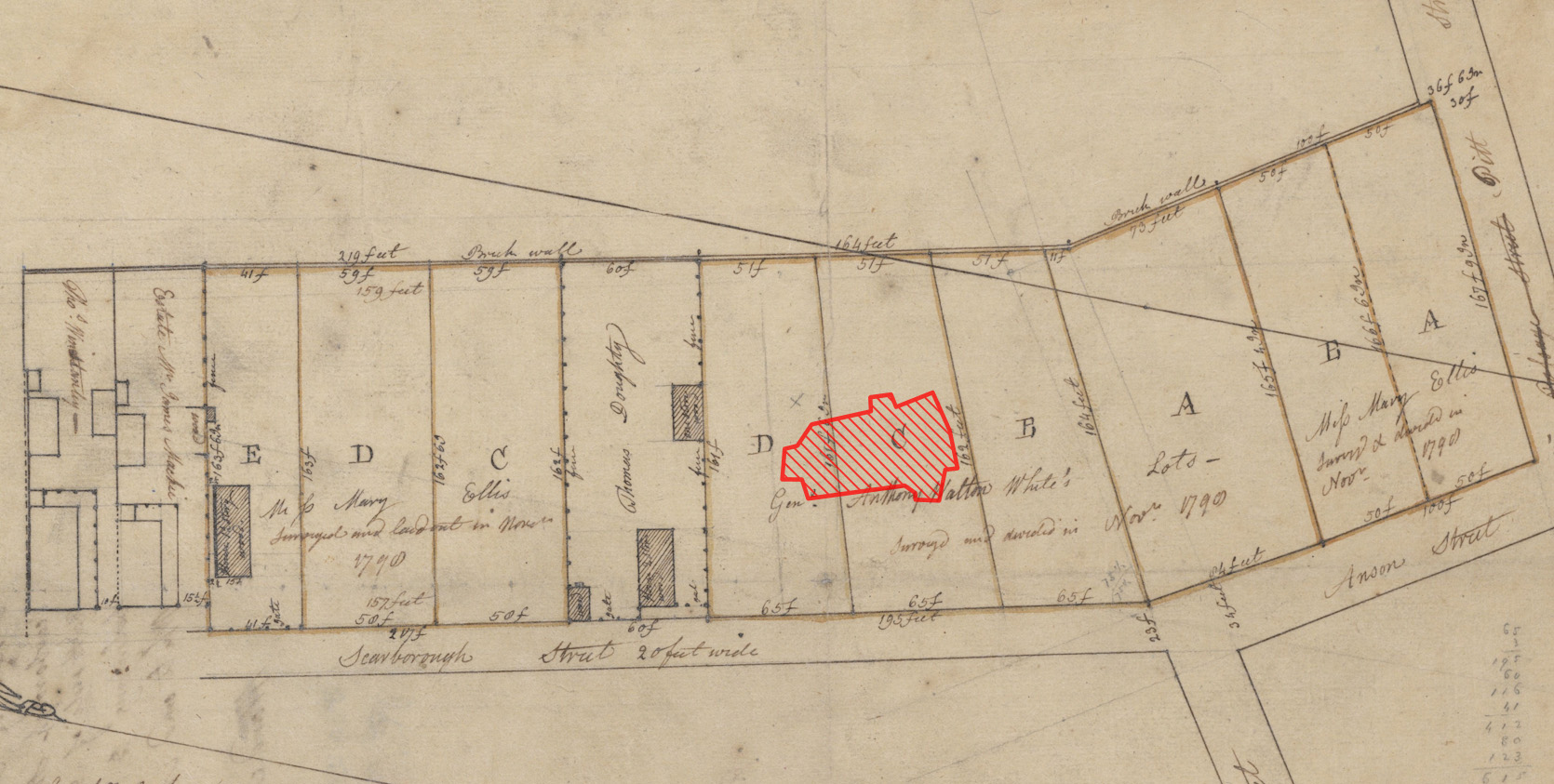
A Plat Map from A.D. 1795 Showing the Development of the Neighborhood of Ansonborough. The shaded red area marks the Anson Street burial ground uncovered during excavations at the Gaillard Center, which is shown in white in the preceding map. This map was accessed from the Charleston County Register of Deeds by G. Mishoe.

A plat map from A.D. 1798 Showing the Subdivision of Lots Bordering Scarborough, or Anson Street. The red lines outline the area shown in the previous plat map for Ansonborough in which the burial ground is marked. This map was accessed from the Charleston County Register of Deeds by G. Mishoe.
The features of the burials revealed important details about the individuals interred in them. The orientation of the burials and spacing of the burials (in roughly four equally-spaced rows) (see map below), evidence of clothes (represented by buttons), beads, and burial shrouds (visible as copper stains on numerous skulls) suggested that the individuals were part of a community that took care of the deceased, and that burials occurred over an extended period of time (rather than as a result of an epidemic or other catastrophic event) (Poplin 2013).
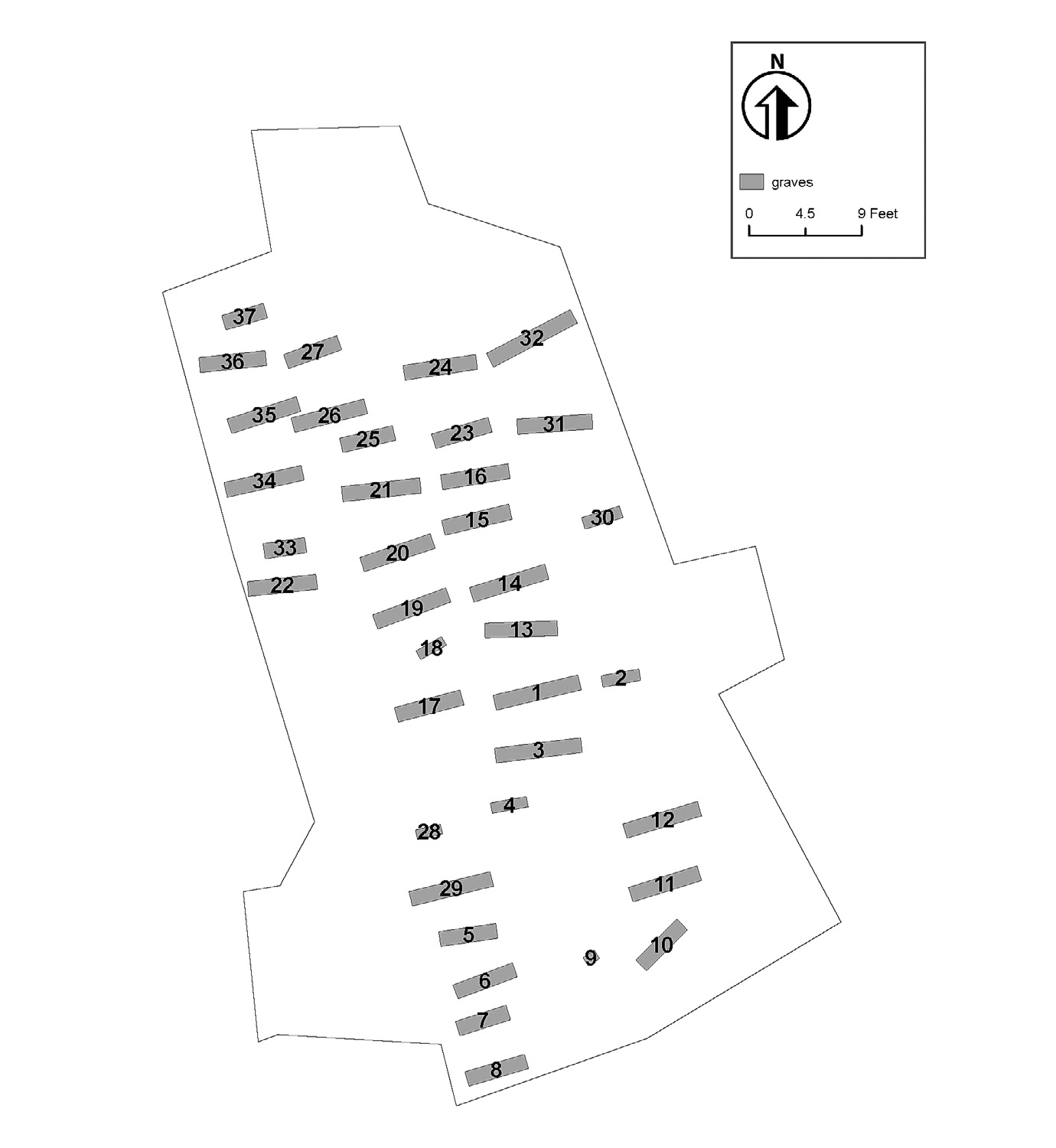
Plot Map of the Anson Street Excavated Burial Area. The numbers on the graves correspond to individual IDs. Image provided by Brockington & Associates, Inc.
A George III copper halfpenny minted in 1773 found in association with burial 37, two other coins minted sometime between 1670 and 1795, buttons dating to between 1730 and 1820, and a gunflint used in trade guns prior to 1790 found in association with the burials, supported a mid- to late-18th century date for their interment (Poplin 2013).
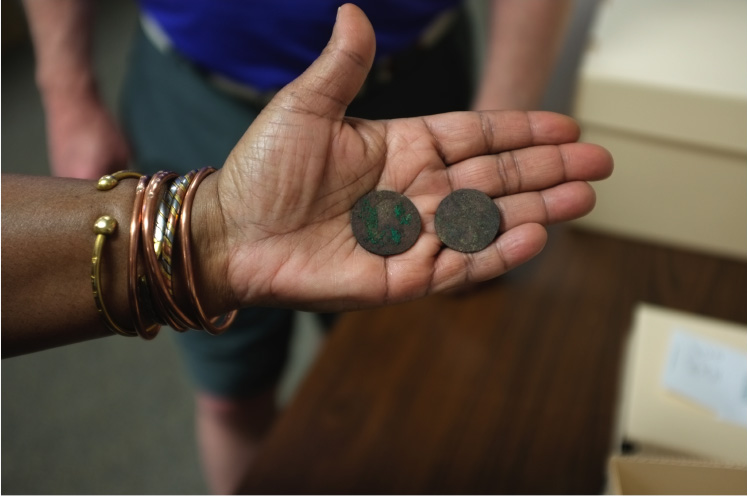
LaSheia Oubré holding two coins that had been placed over the eyes of the Ancestor Welela. Photo credit: Raquel Fleskes.
Once disinterred from the burial site, the skeletal remains underwent osteoarchaeological analyses and were then stored in wooden ‘coffins’ in a climate-controlled City Government facility in West Ashley (Abel 2013).
The preservation of the human remains was varied, especially post-cranially, where the cortical surfaces of the bone had been damaged by exposure to damp, acidic soils in the burial environment (Abel 2013). Thirty-six of the burials were identified as human, and the other one as a faunal assemblage that may have been a refuse pit (Abel 2013). Thirty-three of the individuals were identified to have African ancestry, using measurements of specific morphological and metric characteristics of the skull.
Strontium and oxygen isotope analysis was conducted in 2013-14, using dental enamel and bone samples from thirty-five individuals (Juarez 2014). Thirteen of these samples had dental enamel 87Sr/86Sr levels above Charleston range, indicating that they were born elsewhere, but nine of these individuals had bone sample levels that fell within the Charleston range, suggesting that they had lived in Charleston for over ten years (Juarez 2014). Of these thirteen individuals, nine had tooth enamel 87Sr/86Sr levels within the range for West Africa (Juarez 2014).

Strontium and oxygen isotope values for the Anson Street Ancestors (Juarez 2014).
Two individuals were found to have filed or modified teeth. Modified or decorated teeth are found in various populations in sub-Saharan Africa (Citations). Scholars suggest that modification may have been practiced for aesthetic reasons, rites-of-passage or to mark group affiliation (Schroeder et al. 2014).
Using skeletal and dental evidence, the ages and sexes of many of these individuals was estimated. The age estimates for thirty-three of the individuals indicated that were 2 infants, 5 children (6 months to 15 years), 2 young adults, 8 adults, 9 mid-adults and 7 older adults uncovered in the excavation (Abel 2013). It was possible to identify the sex of twenty-seven individuals, these were 16 males and 11 females (Abel 2013). The remains of three individuals were too fragmented to estimate age or sex.
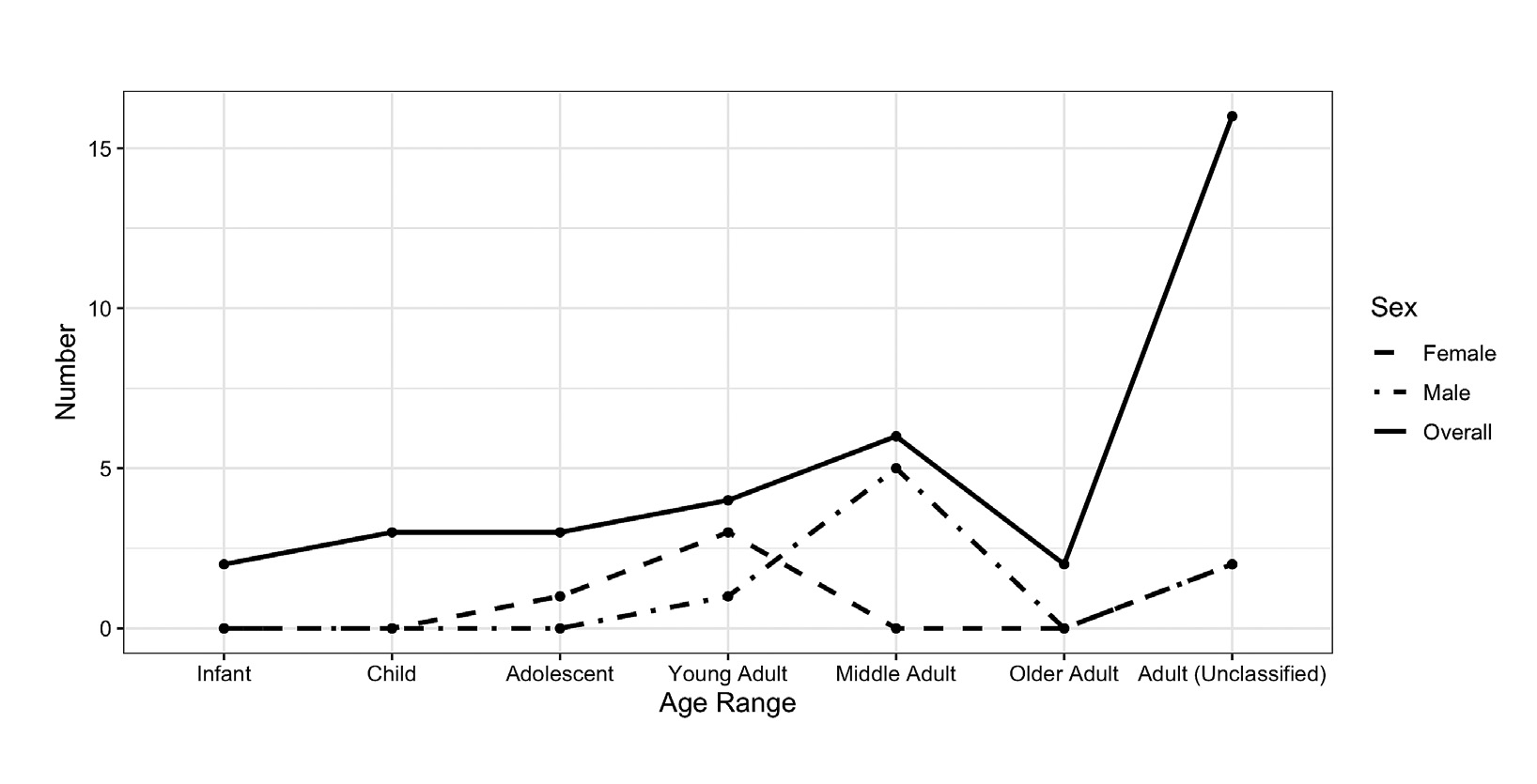
Graph of the distribution of estimated osteological age by sex in the Anson Street sample. Age ranges in years are classified as follows: Infant (0–3), Child (3–12), Adolescent (12–20), Young Adult (20–35), Middle Adult (35–50), and Older Adult (50+). The solid line represents the total number of individuals (n = 36), the dot-dash line representing the sub-set of females (n = 8), and the dashed line representing the sub-set of males (n = 6), as estimated by osteological sex assessment.
In August 2017, Brockington and Associates completed an archaeological survey to assess whether the location intended for the reinterment contained further burials. Their survey demonstrated that this was unlikely, hence, was a suitable place for the reburial (Poplin, pers. comm., Aug 2017).
In May 2017, Mayor John Tecklenburg requested that Dr. Ade Ofunniyin of the Gullah Society meet with him and his staff members to discuss possibilities for the reinterment of the thirty-six individuals of African-descent, whose remains were uncovered in 2013 on the Charleston Gaillard Performing Arts Center property. In 2012, Dr. Offuniyin had founded the Gullah Society as a non-profit organization whose mission was to preserve, promote, and perpetuate Gullah Geechee culture and traditions. Accordingly, the organization worked to provide Gullah Geechee people with skills in identifying and preserving sites, historical data, artifacts, and objects associated with Gullah Geechee people and culture and raise awareness of African descendant burial grounds, identity and history.
The initial meeting was followed by further meetings that included representatives of the City, Gullah Society staff and other parties. Those parties included the City of Charleston, represented by Attorney Susan Herdina, Peter Hedegor, Senior Construction Project Manager, Mike Whack, Special Assistant for Quality of Life and Community Outreach, Rick Jerue, Senior Advisor to the Mayor, and Vanessa Turner Maybank, Clerk of the Council; the Reverend Willie Hill from St. John’s Reformed Episcopal Church; and the Gullah Society, represented by Dr. Ade Ofunniyin, Executive Director, and Joanna Gilmore, Director of Research and Interpretation.
Further details
Ancient and Modern DNA Research 2018-20
Overview of Genetic Research Efforts
The appropriate ethical treatment of human remains uncovered at Anson Street was of paramount importance to the Charleston community. The remains are especially significant because they were found in a location that was not marked as a burial ground and the majority of the individuals buried were of African-descent, buried in the latter part of the 18th century (Poplin 2013). Many burial sites in Charleston, especially those of African-descendant individuals, have been forgotten or buried as the city has grown.
During the excavation of the African Burial Ground in New York City, which had been missing from modern maps, many in the African-American community felt that the descendants should decide what happens to the individuals buried on this sacred ground (Mack and Blakey 2004). Due to the lack of early records relating to enslaved Africans, and the unmarked nature of the cemetery and burials, it remains difficult to uncover the identity of the individuals buried there or in Charleston.
Together, the City and the Gullah Society sought to sensitively ensure that the identities and lives of these individuals were explored as fully as possible by analyzing ancient DNA from these samples in order to increase our understanding of their ancestry and whether they were related to each other. Through our education and events program, we involved communities in the memorialization and celebration of the lives of the individuals buried on this site. Our engagement initiatives increased access for all ages to the archaeological, historical and genetic research, and encouraged participation in the design of a memorial for the reinterment site.
African and African descendant burial sites can be found all over the Charleston peninsula. According to Dr. Nicholas Butler, Historian for the Charleston County Public Library, “up until World War II, it was not uncommon for churches and city officials to say, ‘this burial ground is full so we’re going to build on top of it’” (Butler, pers. comm, 2017). The African burials found at the Gaillard Center provided an opportunity for the City of Charleston to acknowledge the contributions that Africans and their descendants have made, and continue to make, to its culture and history.
The data resulting from the ancient DNA (aDNA) analysis provide insights into origins of Africans involved in the trans-Atlantic slave trade, and potential identify kinship relations among the buried individuals. This study of the genetic diversity of mid- to late-18th century African and African descended individuals living in Charleston represents the first analysis of its kind for this time period and location.
The English settled and established a plantation economy using the forced labor of enslaved Africans in Carolina from 1670. In the early 18th century, Africans were brought directly to Charles Town from West and Central Africa, with numbers growing from 300 annually in 1710 to more than 3000 by 1770 (Battle 2013). An estimated 40% of African lives trafficked into the United States came through Charleston’s port during the trans-Atlantic slave trade, often from the western coast of Africa (Pollitzer 1999).
According to Battle (2013: page #), “by the end of the colonial period, African arrivals in Charleston primarily came from Angola (40 percent), Senegambia (19.5 percent), the Windward Coast (16.3 percent), and the Gold Coast (13.3 percent), as well as the Bight of Benin and the Bight of Biafra in smaller percentages. Scholars have found that, in contrast to the Chesapeake, Lowcountry planters often differentiated among the many West and Central African cultures, and deliberately sought out slaves of particular ethnicities or from particular regions.”
The origins and relationships of these individuals often remain difficult to explore, as documentary records typically erase individual African identities through the process of enslavement (Schwarz 2010). Genome-wide analysis of aDNA has been effectively used to provide elucidate geographic origins and biological kinship of archaeological individuals (Fleskes et al. 2019; Schreoder et al. 2015) and African descended populations (Salas et al. 2004; Bryc et al. 2015). Thus, we chose to use these methods to analyze the ancestry and possible kinship of the Anson Street individuals.
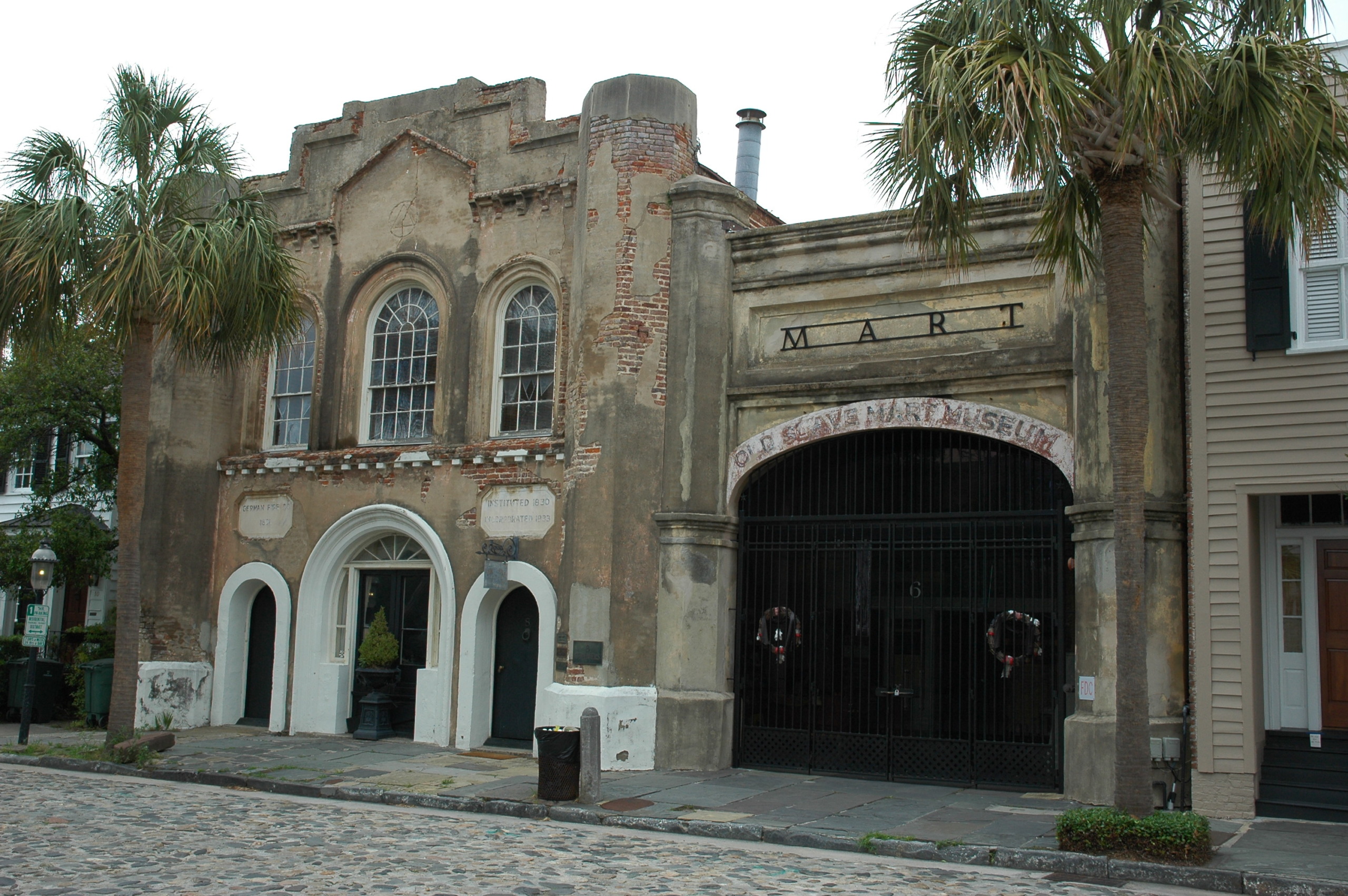
The Old Slave Market Museum in Downtown Charleston, SC. Photo credit: T.G. Schurr
DNA Research with Charleston Populations
With the support of the National Geographic Society, we were able to focus on two aspects of DNA research associated with the Anson Street individuals. First, in May 2018, Raquel Fleskes, a PhD candidate, and her advisor, Dr. T.G. Schurr, an anthropological geneticist, both at the University of Pennsylvania, collected bone and tooth samples from 35 individuals at Brockington and Associates lab in Mount Pleasant.
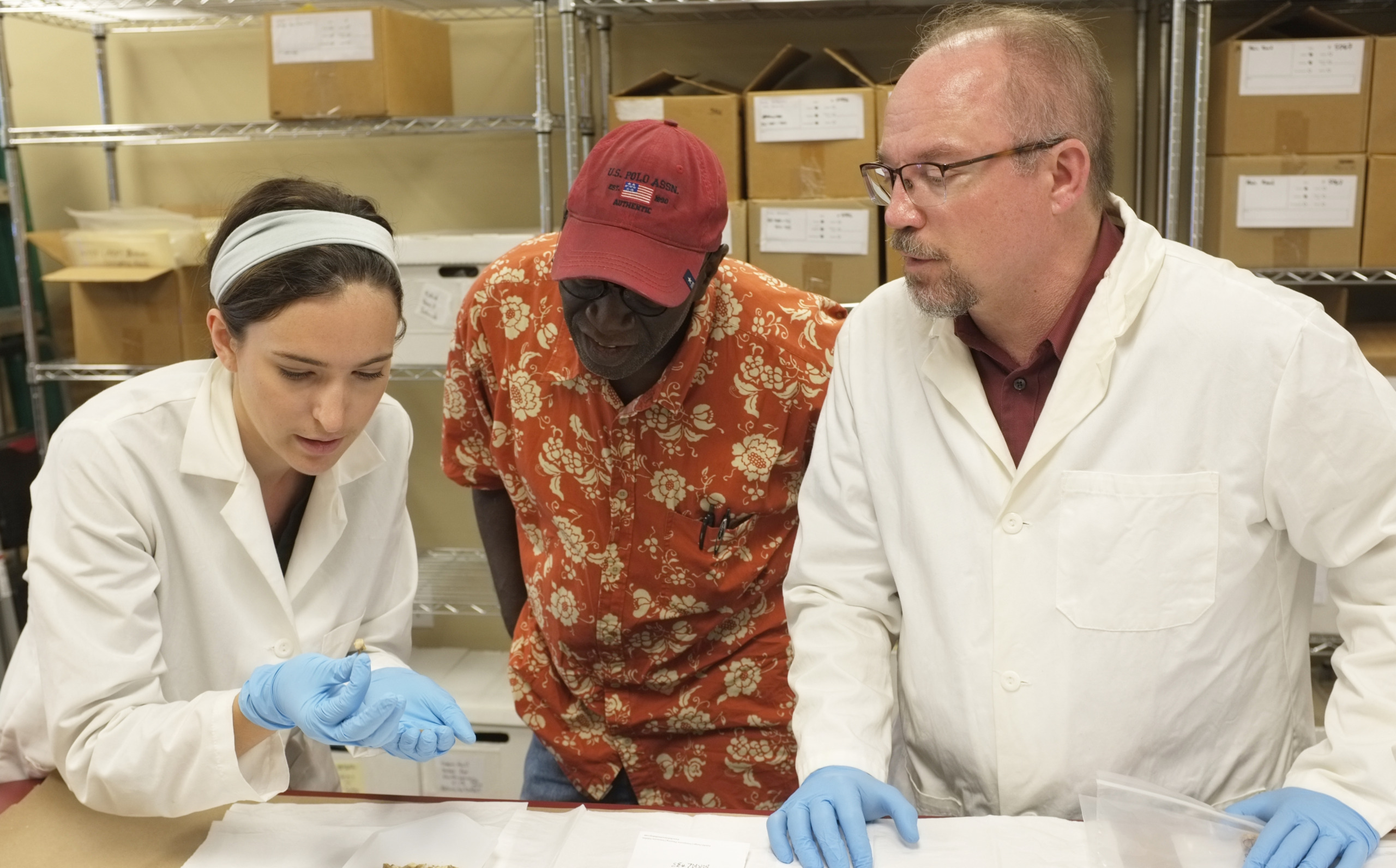
Evaluating the Remains of the Anson Street Ancestors. The remains of the Ancestors were stored at Brockington and Associates, Inc., a cultural resources management organization based in Mt. Pleasant, SC, which had undertaken the original disinterment of these individuals in 2013. Shown from left to right are Raquel Fleskes, Ade Ofunniyin and Theodore Schurr. Photo credit: J. Gilmore
The bone and tooth samples from 35 individuals were taken by Ms. Fleskes to the Ancient DNA Lab at the University of Tennessee-Knoxville (UTK), which is directed by Dr. Graciela Cabana. Ms. Fleskes extracted, amplified and sequenced the mitochondrial DNAs (mtDNAs) of these individuals, and completed the library preparations required for genomic sequencing between October 2018 and September 2019.
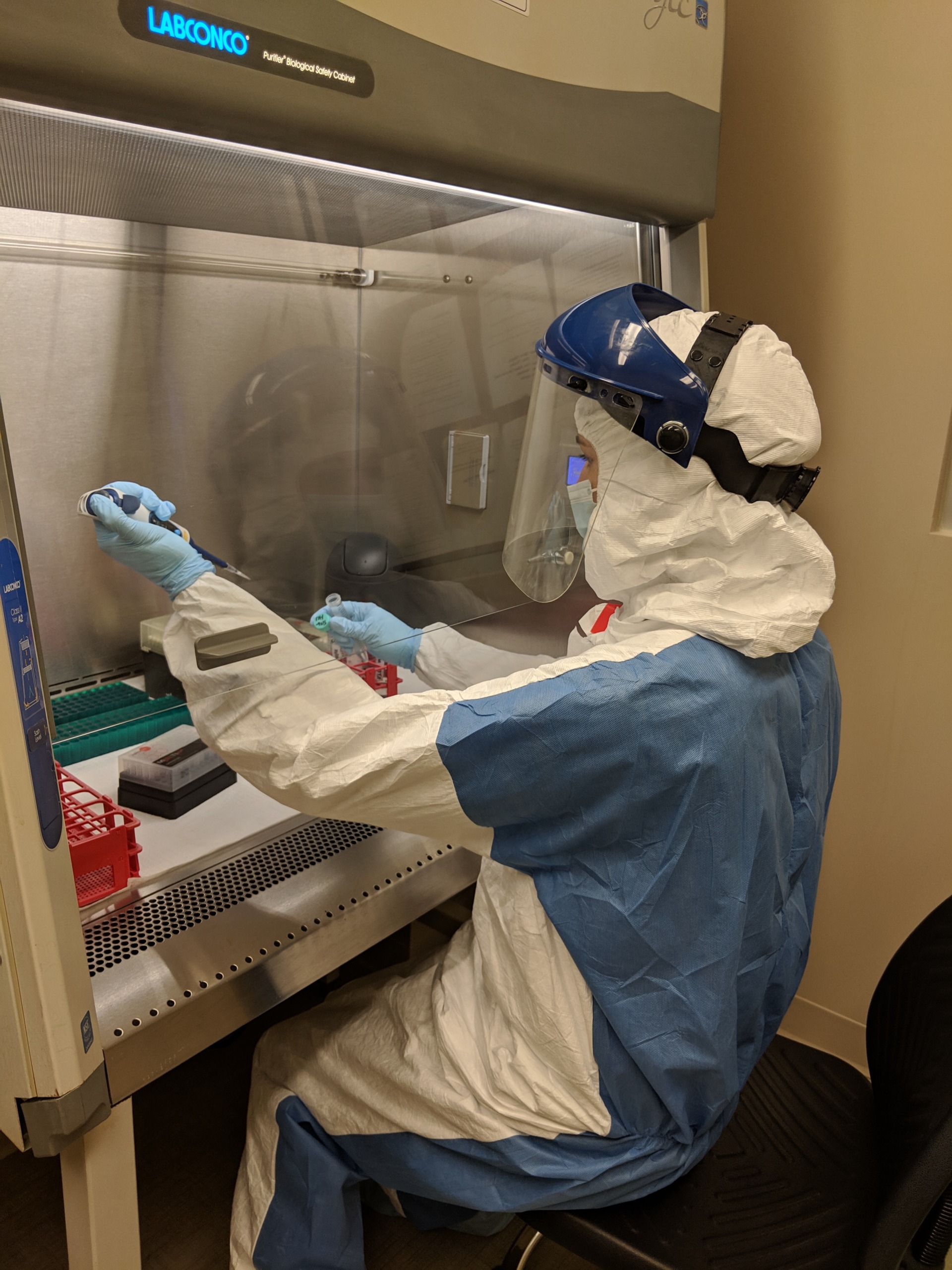
Ancient DNA Analysis of Anson Street Ancestors. Raquel Fleskes extracting ancient DNA from the skeletal elements and teeth of the Anson Street Ancestors. Photo Credit: T.G. Schurr
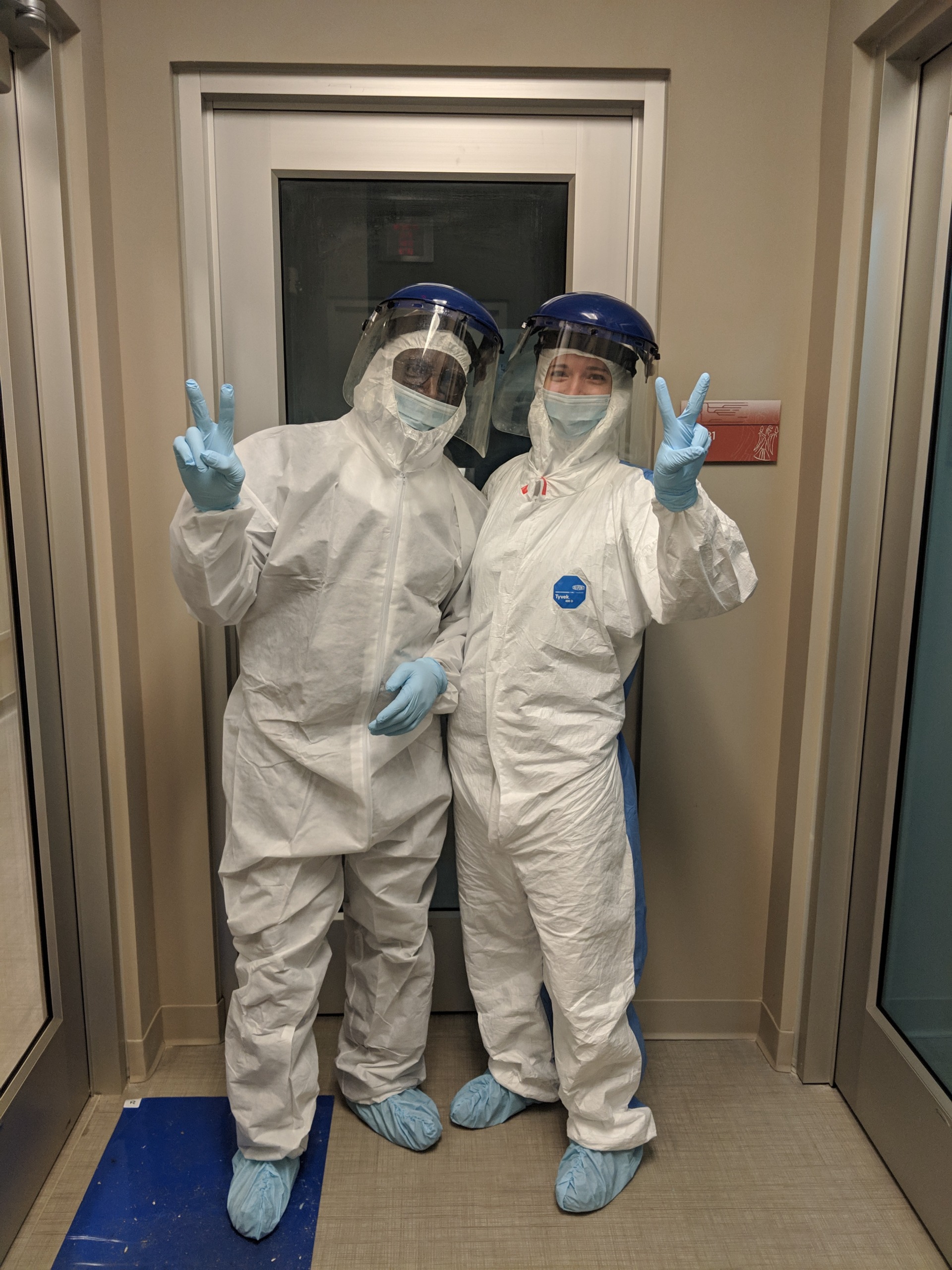
Ancient DNA Analysis of Anson Street Ancestors. During the genetic analysis of the Ancestors, Dr. Ade Ofunniyin visited the Ancient DNA Lab at UTK to learn more about the methods of conducting ancient DNA research. He is shown here in full PPE with Raquel Fleskes. Photo Credit: T.G. Schurr
In addition to the aDNA analysis, we enrolled 78 African-Americans individuals in Charleston in DNA ancestry testing between May and September 2018. Through this work, we helped local community members learn about their genetic ancestry and DNA research more broadly. The modern DNA study provided an initial appraisal of genetic diversity in contemporary African Americans from Charleston that could be compared with that based on aDNA data obtained from the Anson Street individuals.
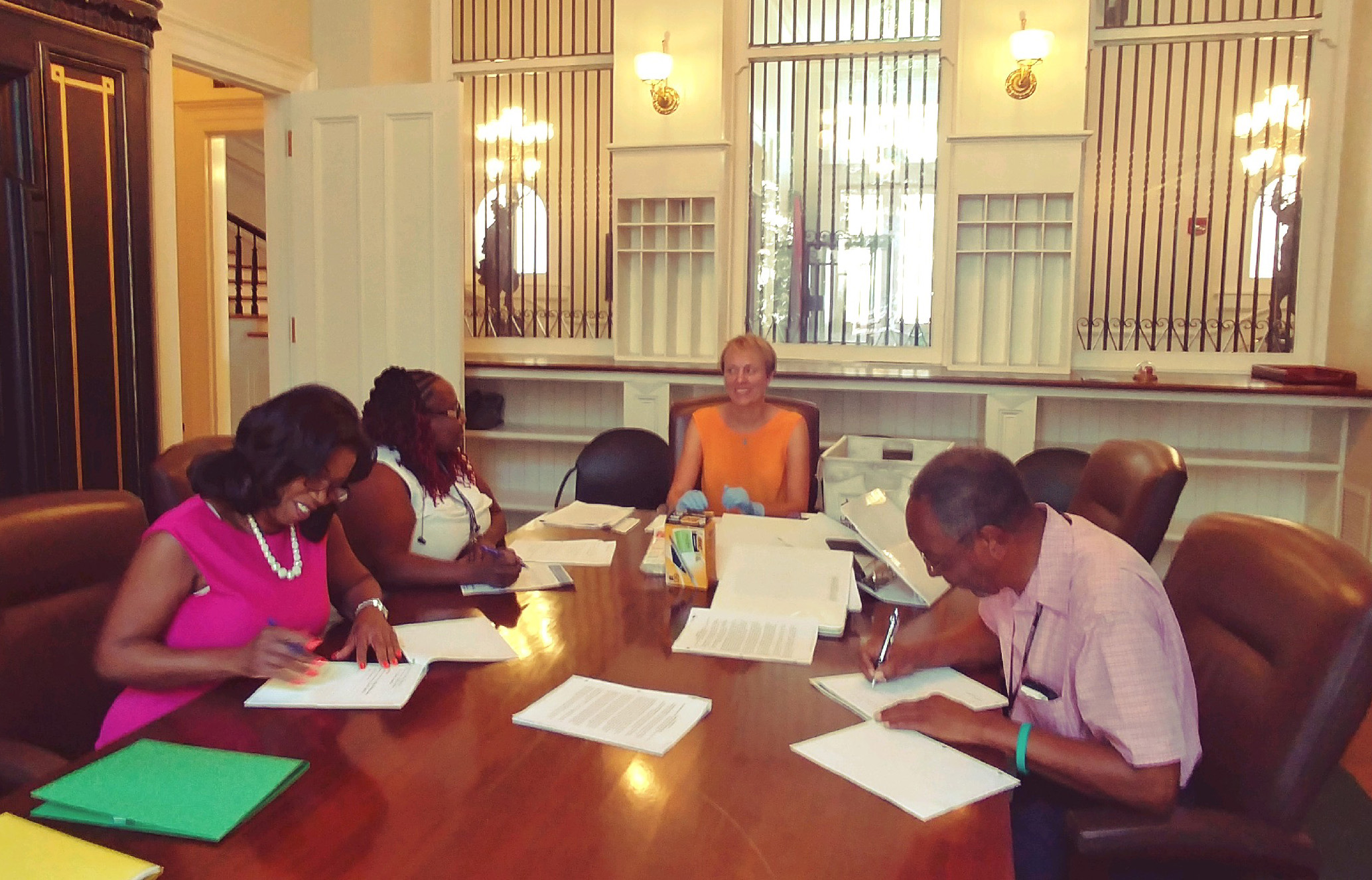
Studying DNA Diversity in Contemporary African Americans from Charleston. Joanna Gilmore is consenting several individuals for the modern DNA analysis at the College of Charleston. Photo Credit: Ade Ofunniyin
We conducted the analysis of mtDNA sequence and Y-STR diversity in the Laboratory of Molecular Anthropology at Penn (LMAP), and SNP genotyped the genomic DNA samples with the GenoChip 2.0 at Family Tree DNA. Full genome sequencing of ancient DNA from the Ancestor Street Ancestors was later undertaken at the High Throughout Sequencing Center at the University of Pennsylvania.
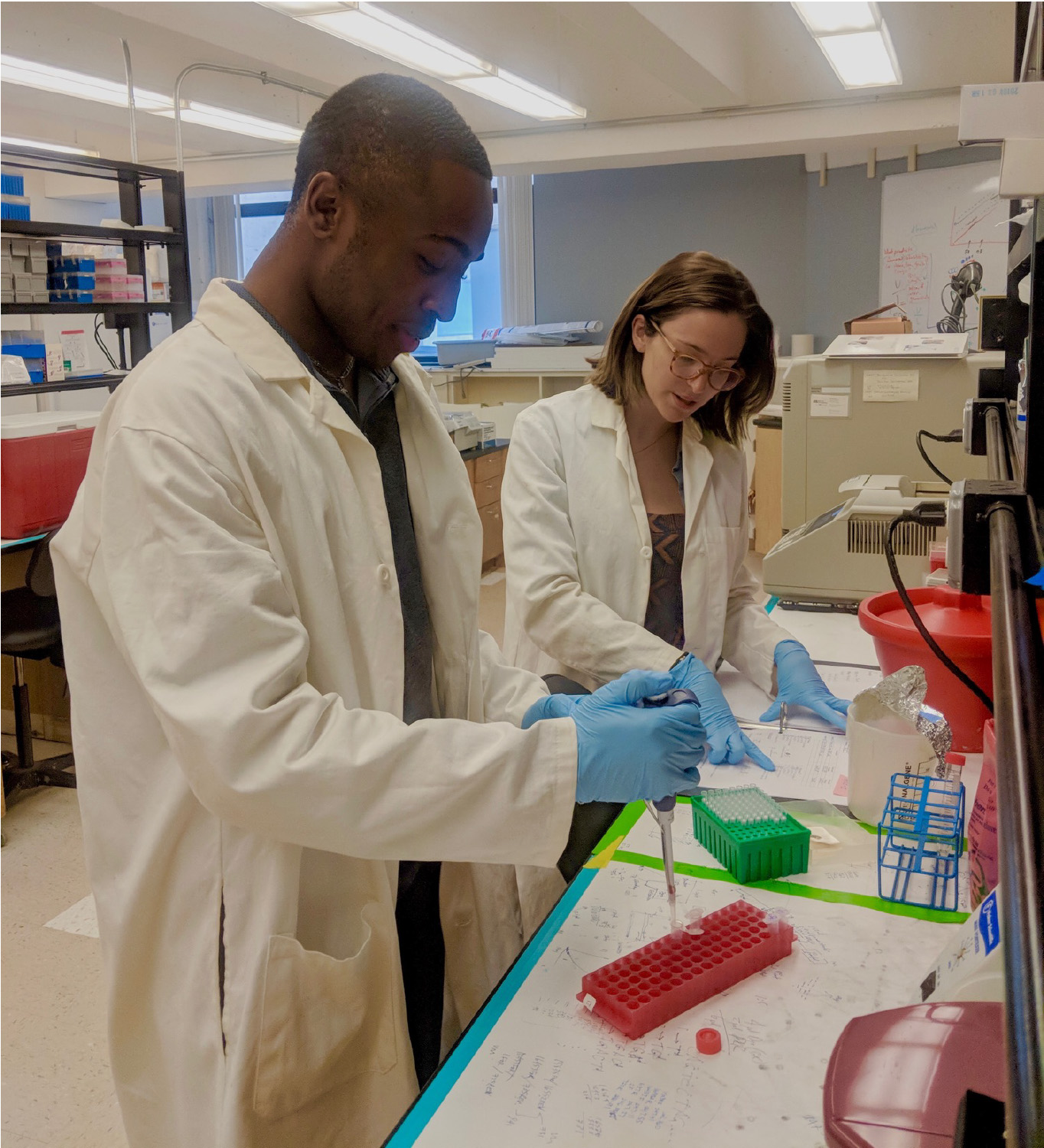
Modern DNA Analysis at the University of Pennsylvania. In this photo, Adeyemi Oduwole, an undergraduate from the College of Charleston, completed an internship characterizing mtDNA variation in African American participants under the guidance of Raquel Fleskes. Photo Credit: Raquel Fleskes
In February 2019, the Gullah Society team held the Egungun Tunji: Ancestors Rise Again!” community event in the Cannon Street Arts Center. During this time, the DNA test results for African American participants in the modern DNA study were provided to them, and Theodore Schurr summarized the general trends in the modern DNA results for these 78 participants. In addition, Rodney Leon, the architect of the New York Burial Ground memorial, discussed his experiences creating the memorial site, and answered questions about ways in which the Anson Street Ancestors might be similarly honored in the future, since creating a permanent memorial for them is the last step in honoring them.
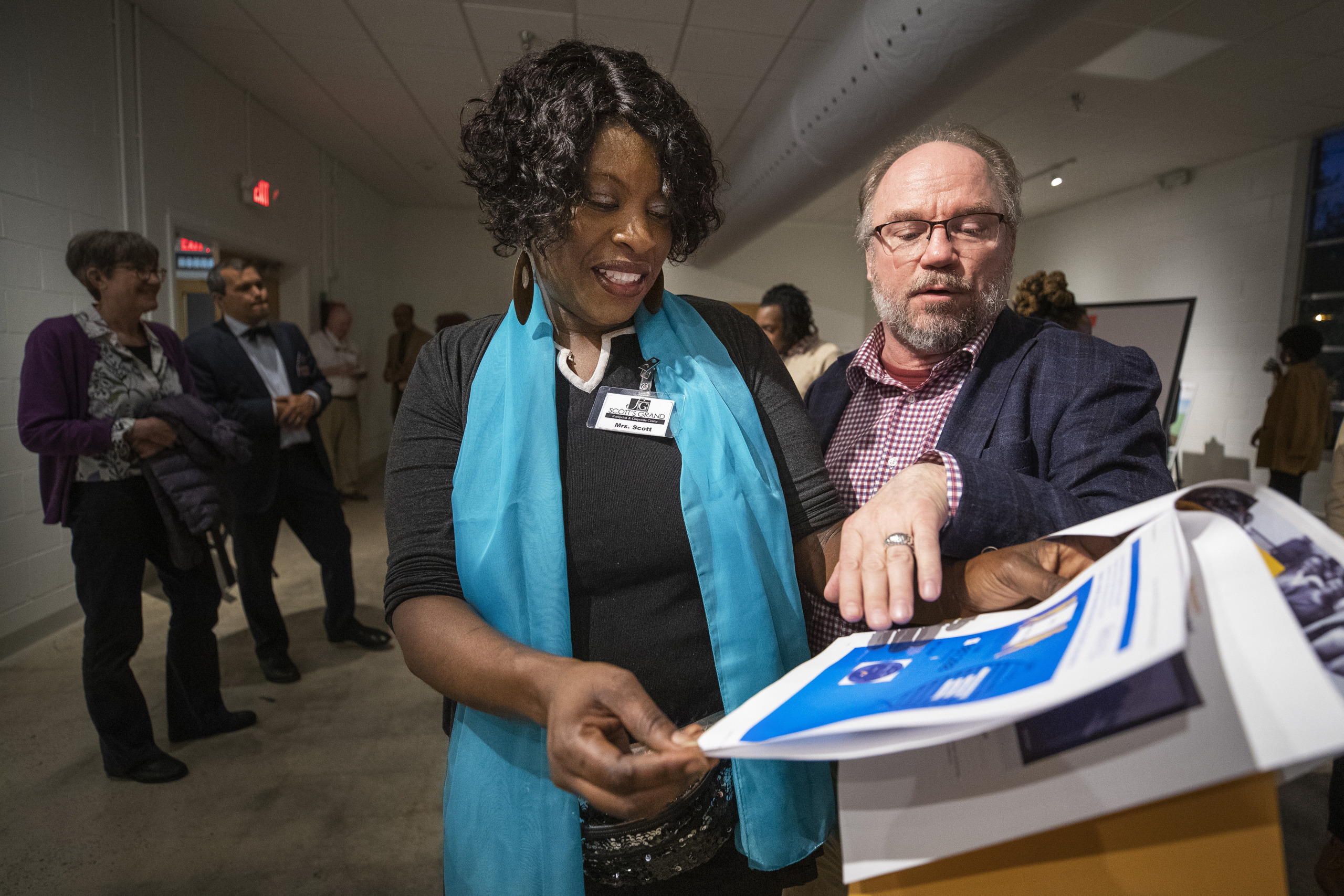
Returning DNA Test Results to Charlestonian Participants. Theodore Schurr explains DNA test results to Regina Scott, one of the participants involved in the research project. Photo credit: Lauren Petracca/Post & Courier
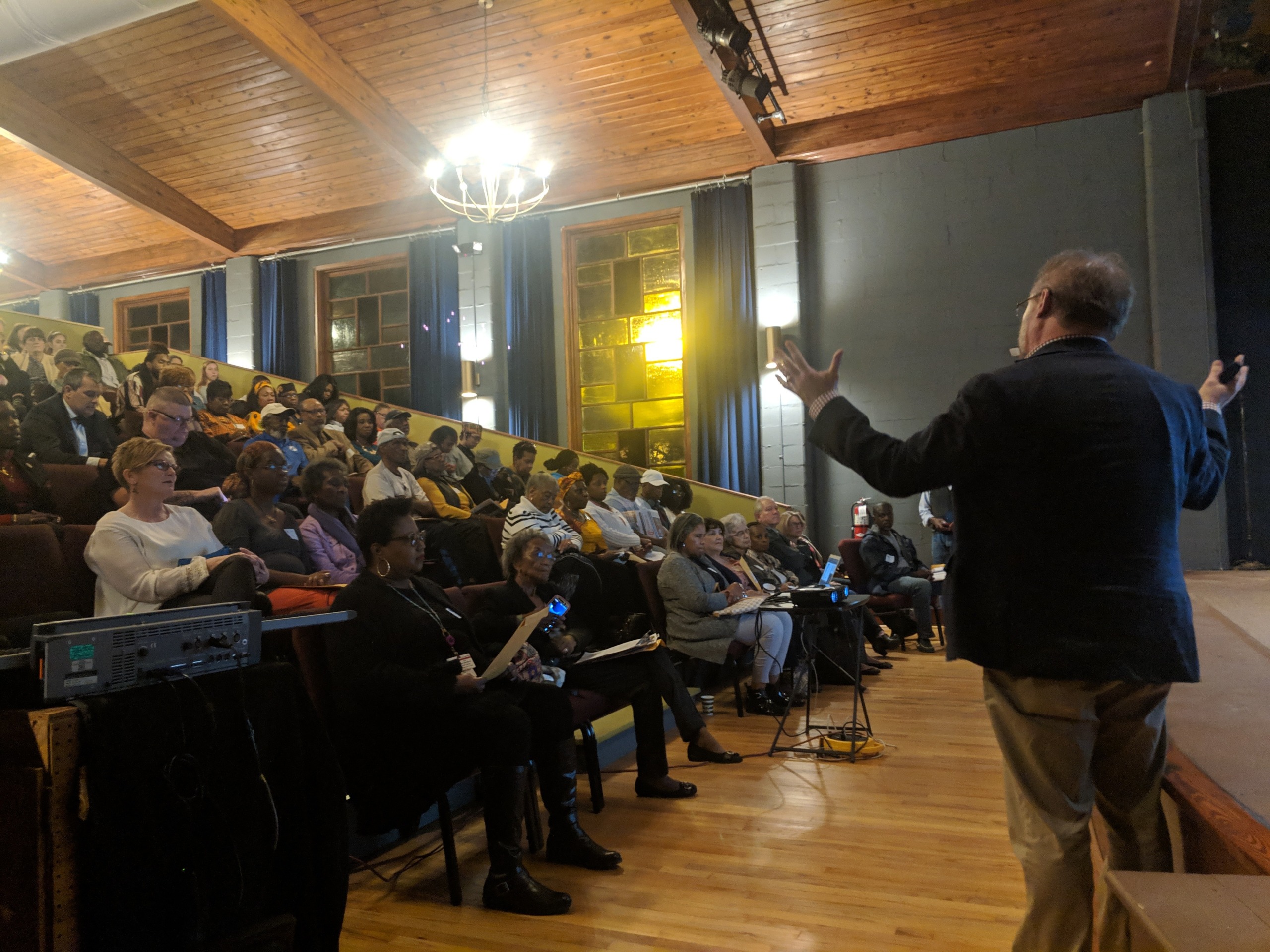
Presentation of Modern DNA Results to Charleston Community. Theodore Schurr summarized the modern DNA data from African American participants to the Charleston community. Photo Credit: Raquel Fleskes
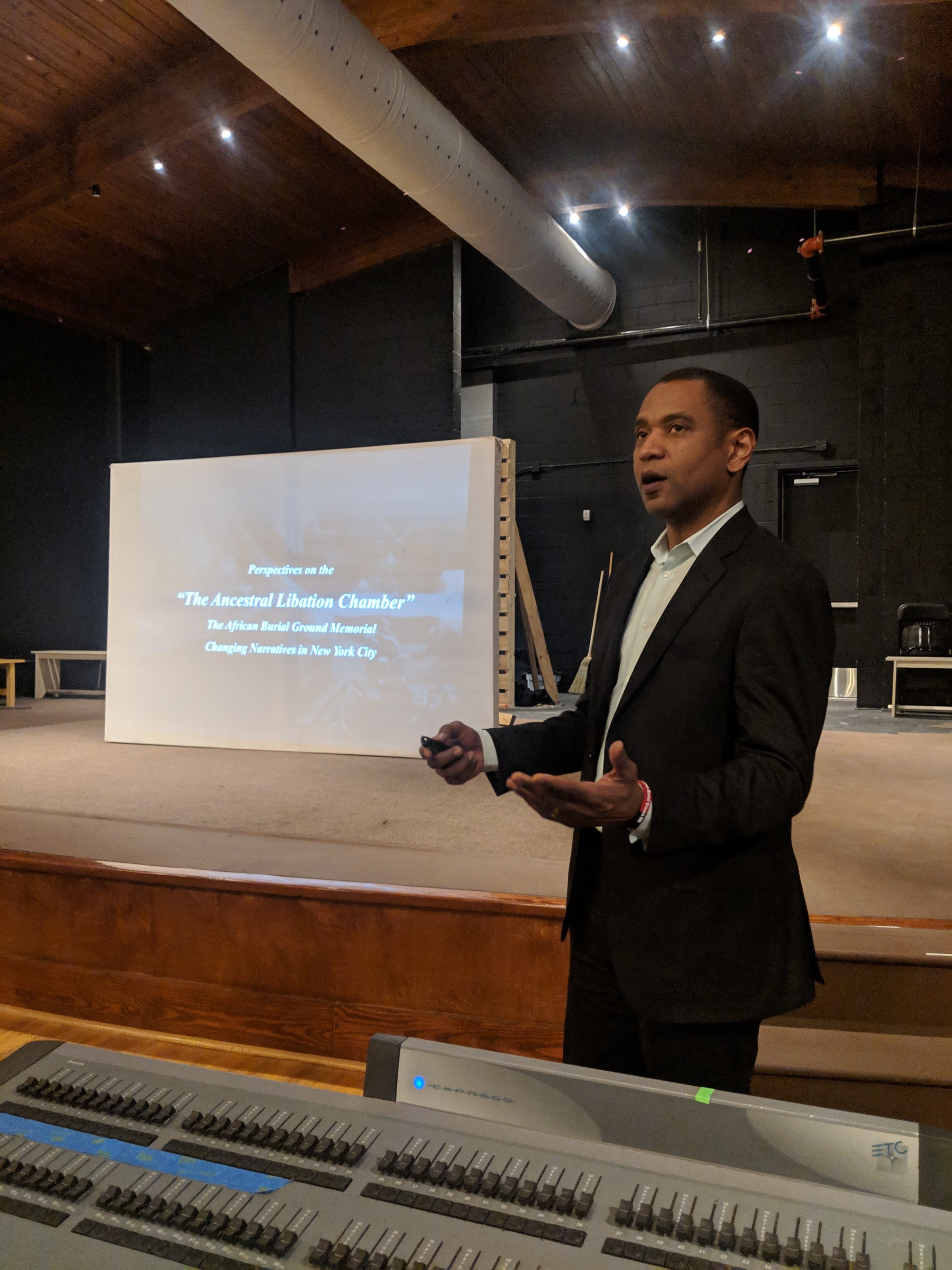
Rodney Leon Discussion of Memorializing the Ancestors. Rodney Leon, the architect of the New York Burial Ground memorial, discussed his experiences creating the memorial site. Photo Credit: Raquel Fleskes
Public Education Outreach
In addition to publicly discussing the results of our research to the Charleston community, we visited middle and high schools in the Charleston area to present our work to students in sciences classes there. Coordinated by La’Sheia Oubré, we gave presentations in the X Middle School and North Charleston High School in 2018-19 that focused on the archaeology, genetics and history of the Anson Street Ancestors, based on work completed at the time.
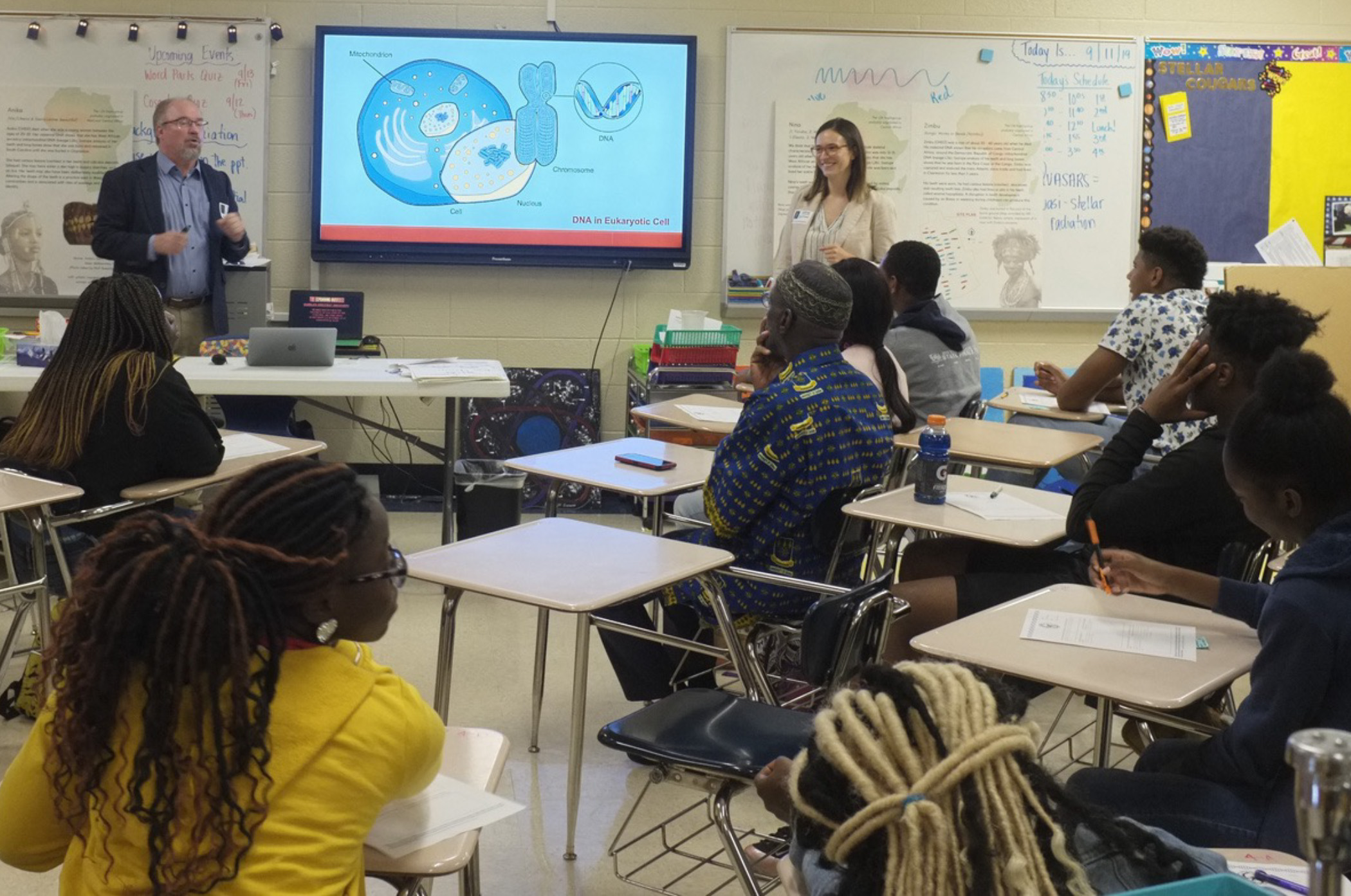
Teaching Science Students about the Anson Street Ancestors in North Charleston High School. Theodore Schurr and Raquel Fleskes discuss the DNA evidence for the ancestry of the Ancestors. Photo Credit: Joanna Gilmore.
Reinterment Ceremony and Acknowledgment of the Ancestors
Using the feedback that we received throughout our Community Conversations, we developed a series of events to mark the reinterment of the ancestors in May 2019. The first of these events was a Naming Ceremony, which was held on 27 April 2019 at McLeod Plantation Historic Site (see below). During this event, the thirty-six individuals were given names during a traditional Yoruba naming ceremony. On 3 May 2019, Dr. Theodore Schurr and Ms. Raquel Fleskes presented a summary of the ancient DNA data for the Anson Street Ancestors at the Gaillard Center. Finally, on 4 May 2019, we held a reinterment ceremony at the Anson Street location of the original disinterment of the Ancestors in 2013 which culminated in their reburial at this site.
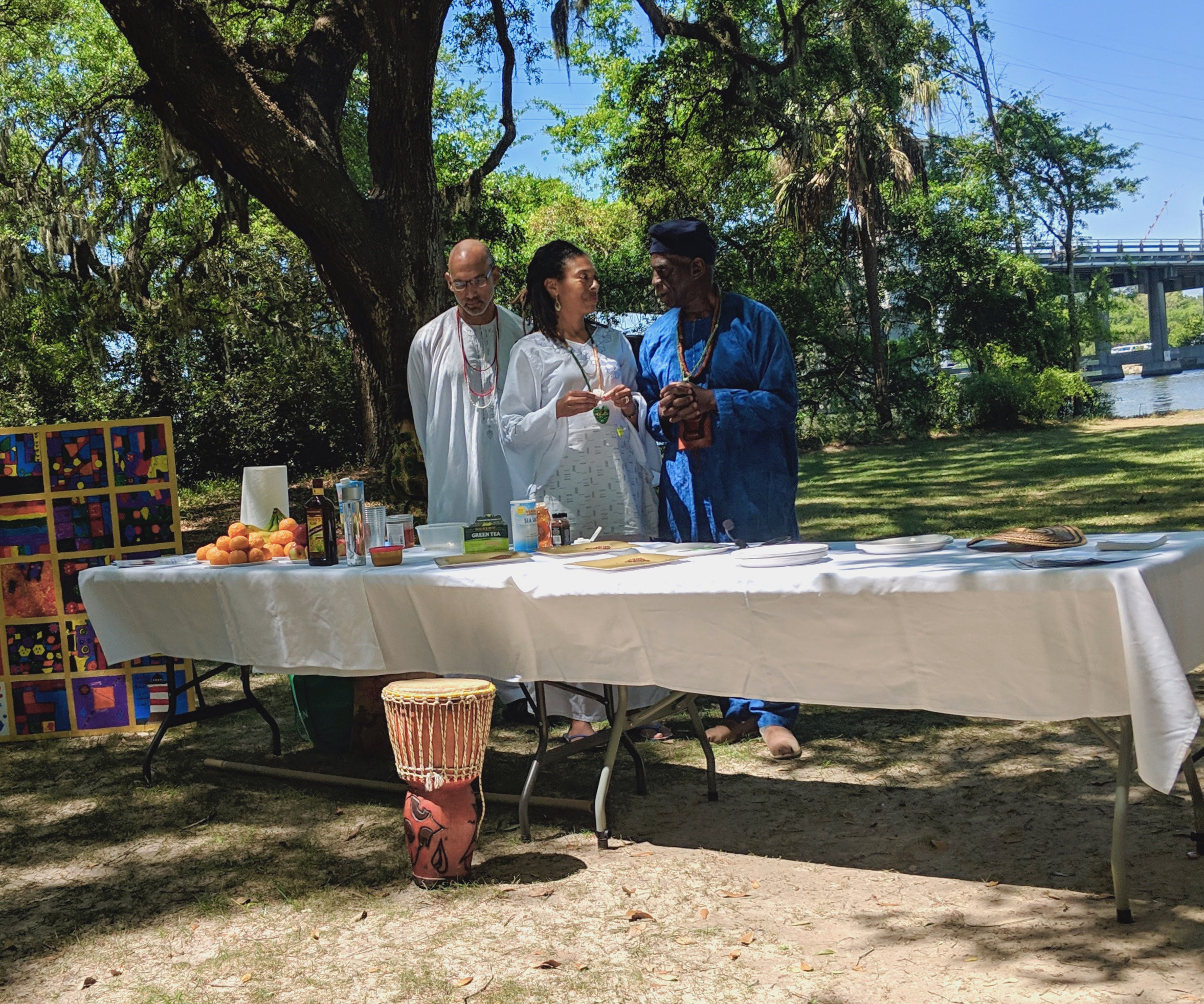
Renaming Ceremony at McLeod Plantation on James Island, SC. Yoruba priests, Drs. Natalie Washington-Weik, Terrance Weik, and Ade Ofunniyin, conducted the Naming Ceremony of the Ancestors. Photo Credit: Raquel Fleskes
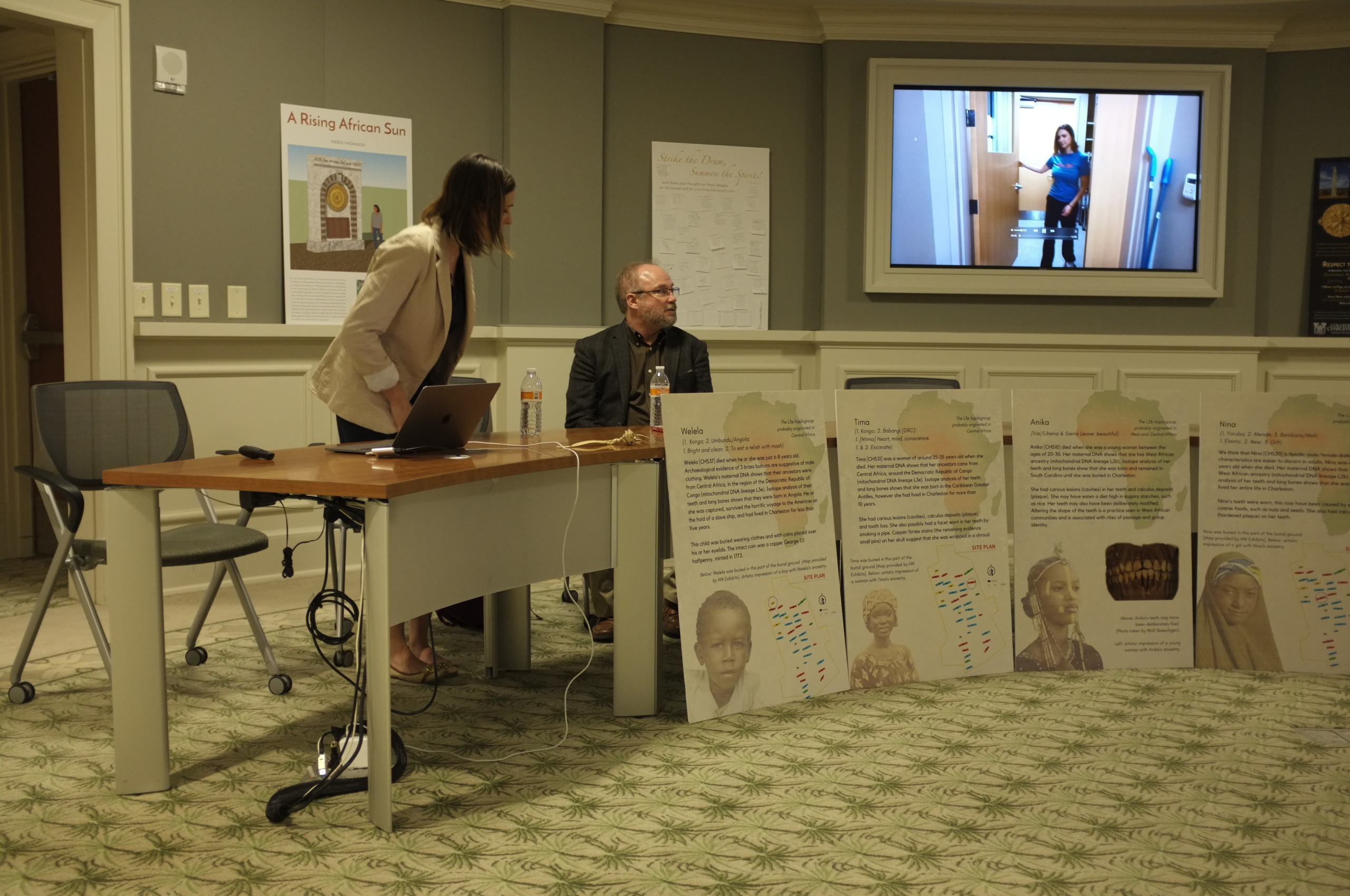
Presentation on Results of DNA Analysis of the Anson Street Ancestors. On Thursday, 3 May 2019, Raquel Fleskes and Theodore Schurr, presented the DNA data for the Anson Street individuals at the Gaillard Center. The panels leaning against the desks presented life histories of the Ancestors based on the archaeological, genetic and osteological information available for them. They were assembled by Joanna Gilmore. The video being shown in the background was produced by Raquel Fleskes using a Go-Pro camera. Photo Credit: Joanna Gilmore
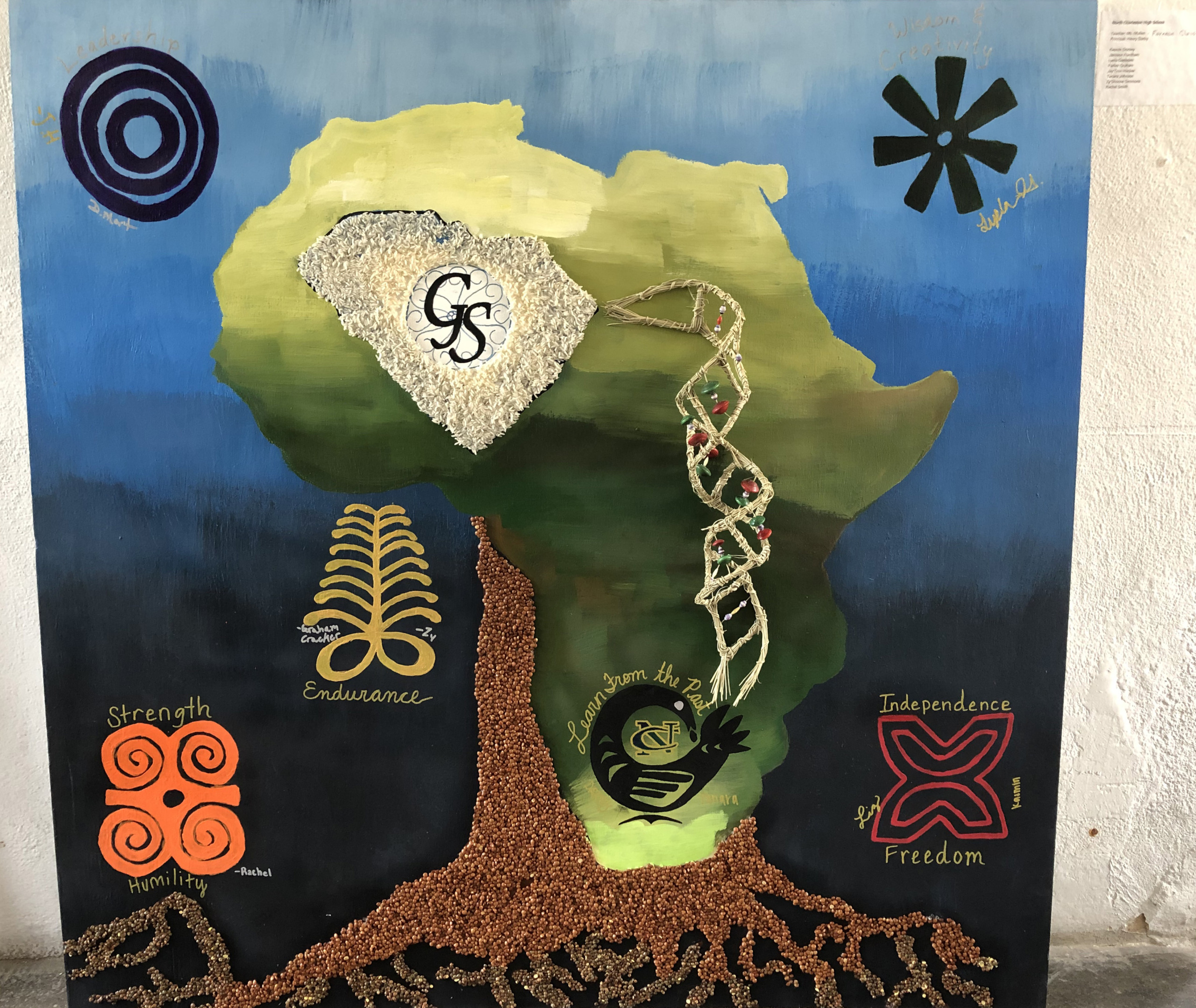
Art Exhibitions to Honor the Anson Street Ancestors. An exhibition of artwork created via the arts engagement program and school visits was displayed at the Civic Design Center on Calhoun Street near the Gaillard Center from 2-12 May 2019. The piece shown here was created by XXXXX. Photo Credit: T.G. Schurr
The last event was the reinterment itself. Discuss planning and logistics for the reinterment ceremony here – the need to coordinate the storage and transfer of human remains between Brockington and the funeral home, city approval process to bury them at Anson and George Streets. Issue with having the burial pit dug – getting funeral home and city people to do the work. Coordinating involvement of multiple religious organizations and political groups to make ceremony inclusive and representative. Involvement of local community members in whole process. Complexities of whole process.
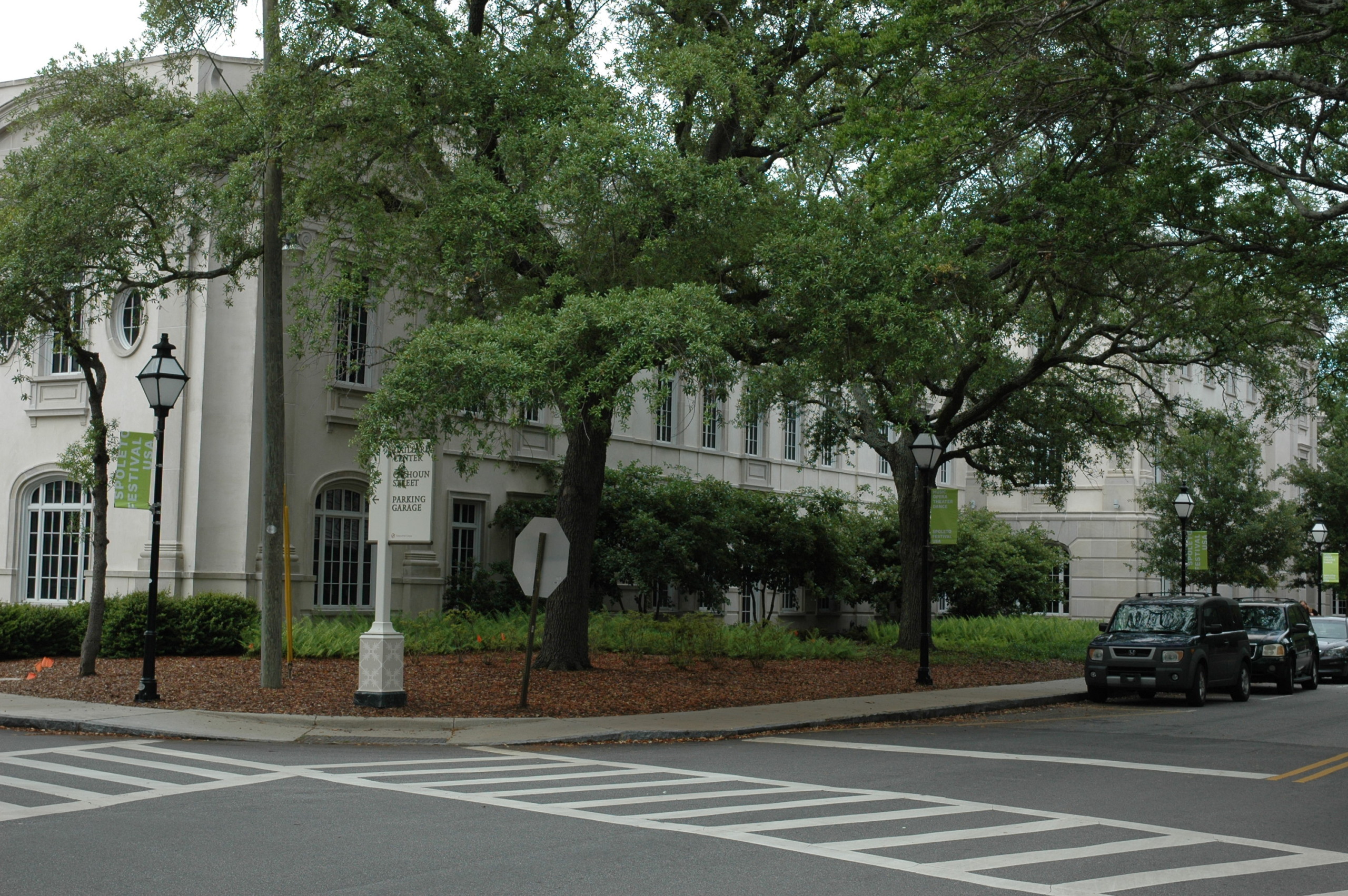
Location of the Reburial Site. The Ancestors were reburied at the corner of George and Anson Streets, very close to the location where they were disinterred during the expansion of the Gaillard Center in 2013. Photo Credit: T.G. Schurr.
The boxes containing the remains of six of the Ancestors were wrapped in indigo cloth donated by XXX organizations to honor them. The indigo represents X, Y and Z. These individuals included two men, two women and two children. The wrapped boxes were later placed in a horse drawn hearse and taken to the burial site for reinterment with the other 30 Ancestors.
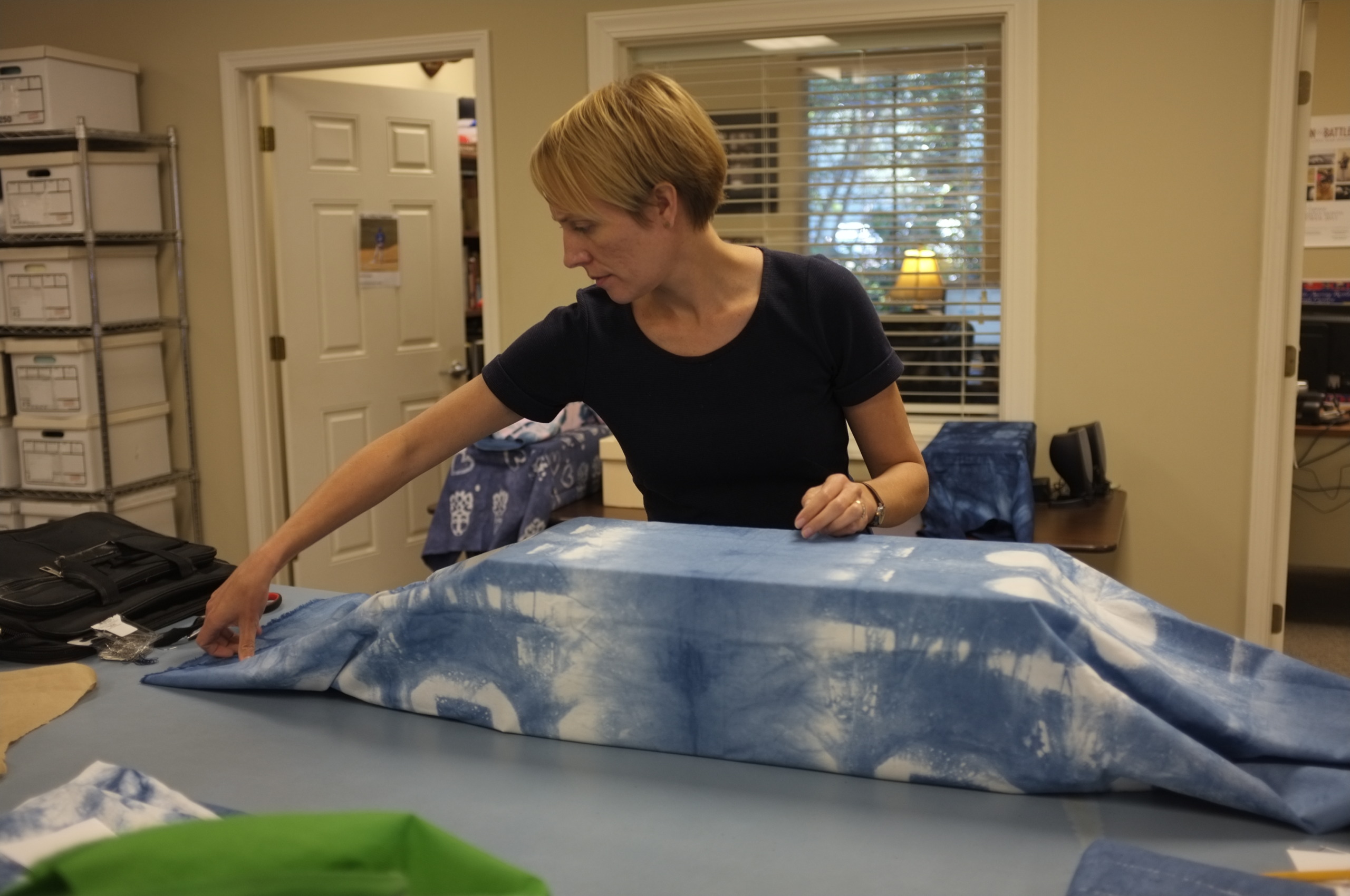
Wrapping the Ancestors in Indigo Cloth. Joanna Gilmore is shown here wrapping the box for an adult at Brockington & Associates, Inc. Photo Credit: Raquel Fleskes
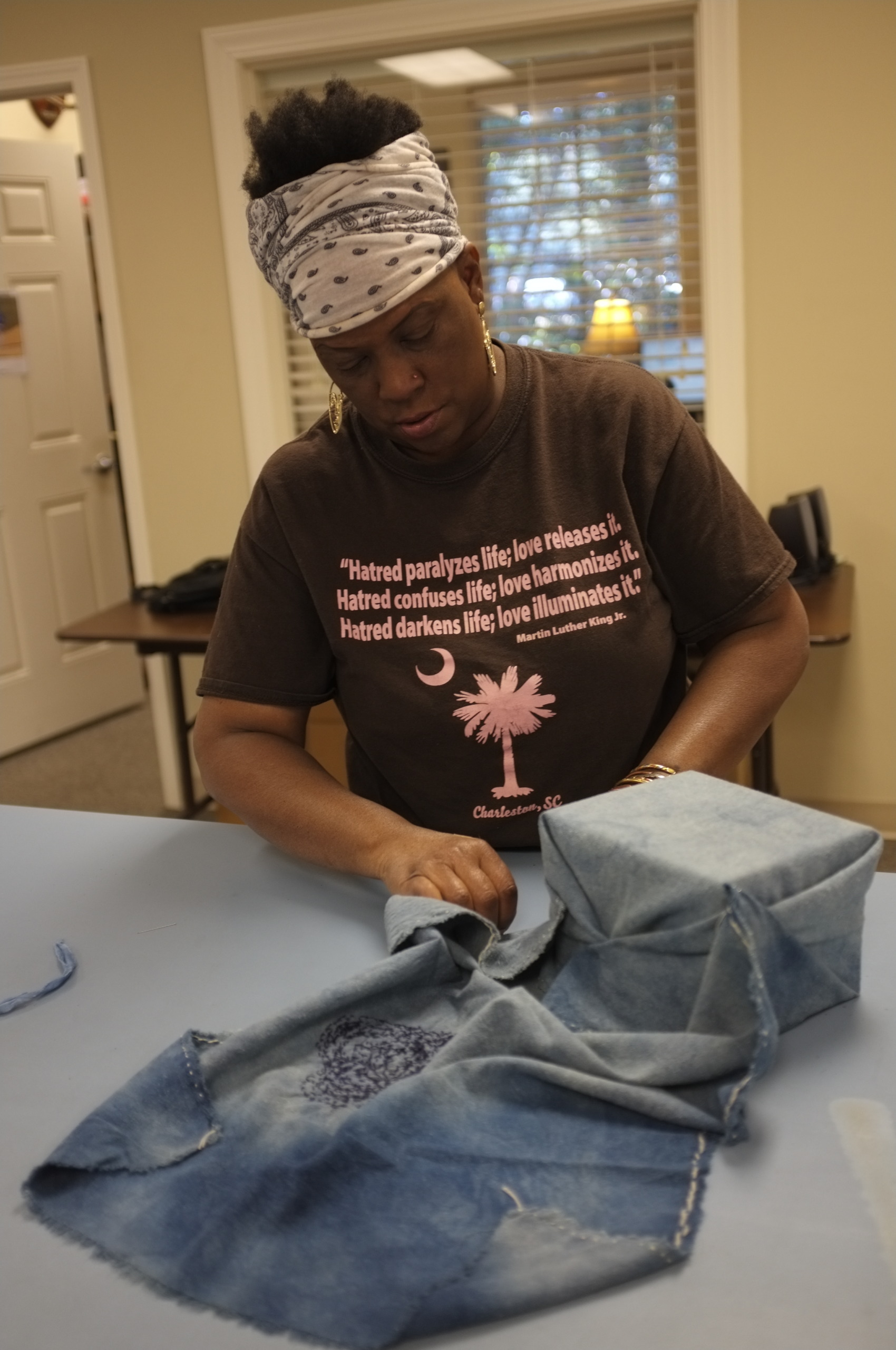
Wrapping the Ancestors in Indigo Cloth. La’Sheia Oubré is shown here wrapping the box for a child in indigo at Brockington & Associates, Inc. Photo Credit: Raquel Fleskes
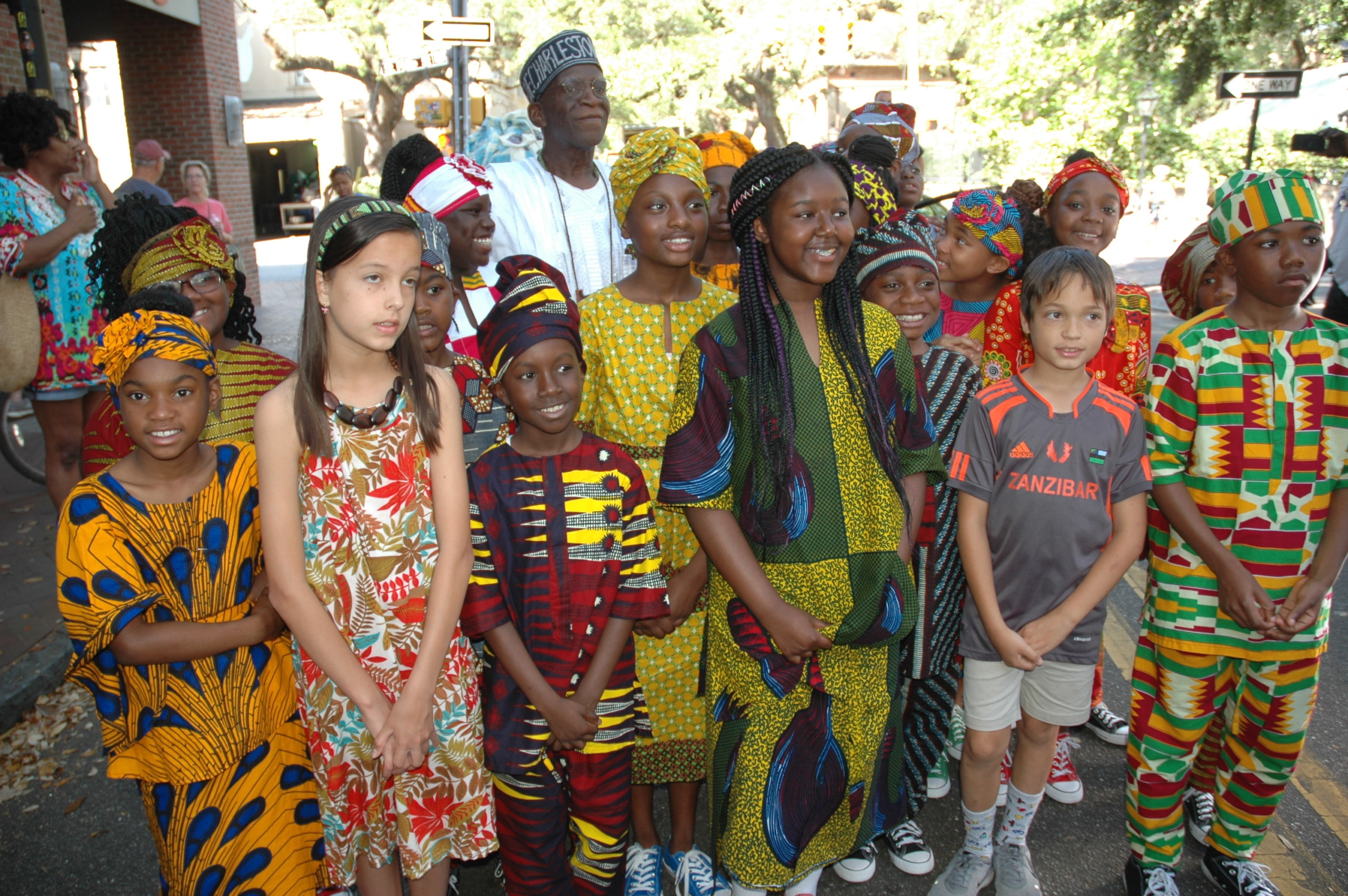
Gathering of Children to Walk in the Procession. Many children participated in the event, with some wearing African regalia. Dr. Ade Ofunniyin stands behind them. Photo Credit: T.G. Schurr.
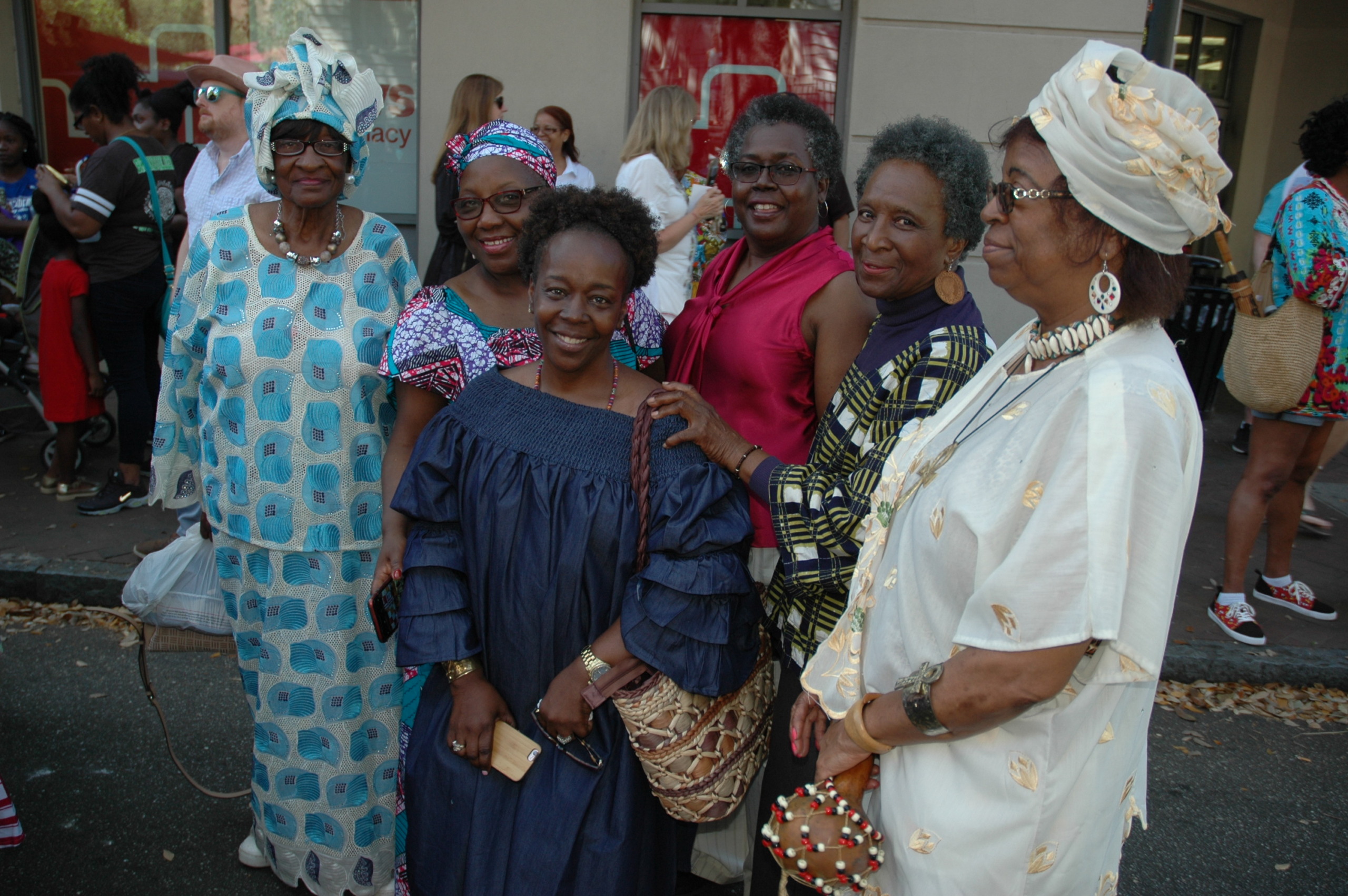
Local Charlestonians Preparing to Walk in the Procession. Numerous members of the local African American communities helped to celebrate the lives of the Anson Street Ancestors. Photo Credit: T.G. Schurr.
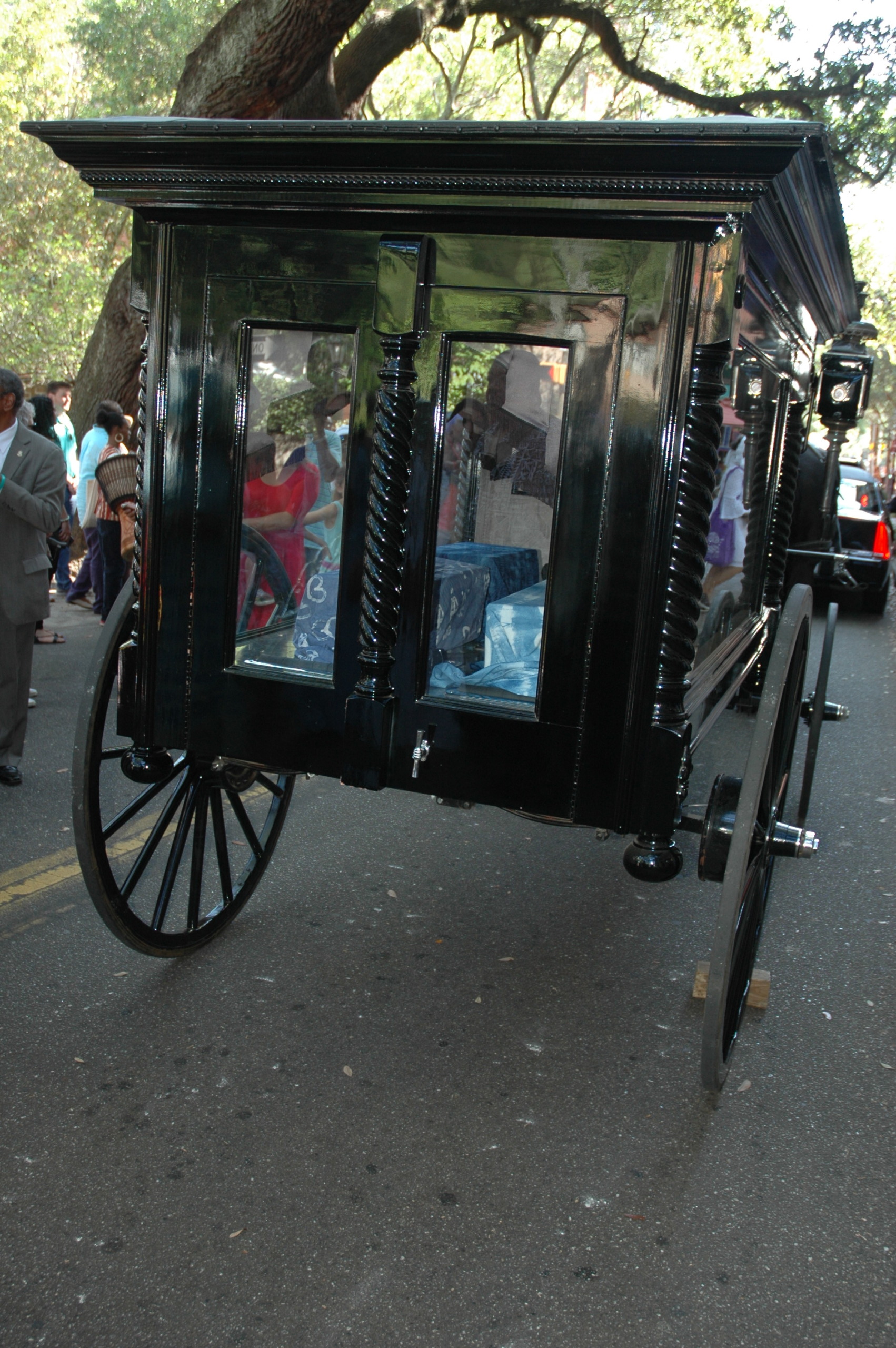
Horse Drawn Hearse Bearing the Ancestors. Specially constructed boxes containing the remains of six Ancestors were wrapped in indigo and placed in the hearse, which took them from the College of Charleston to the reburial site at the corner of Anson and George Streets. Photo Credit: T.G. Schurr.
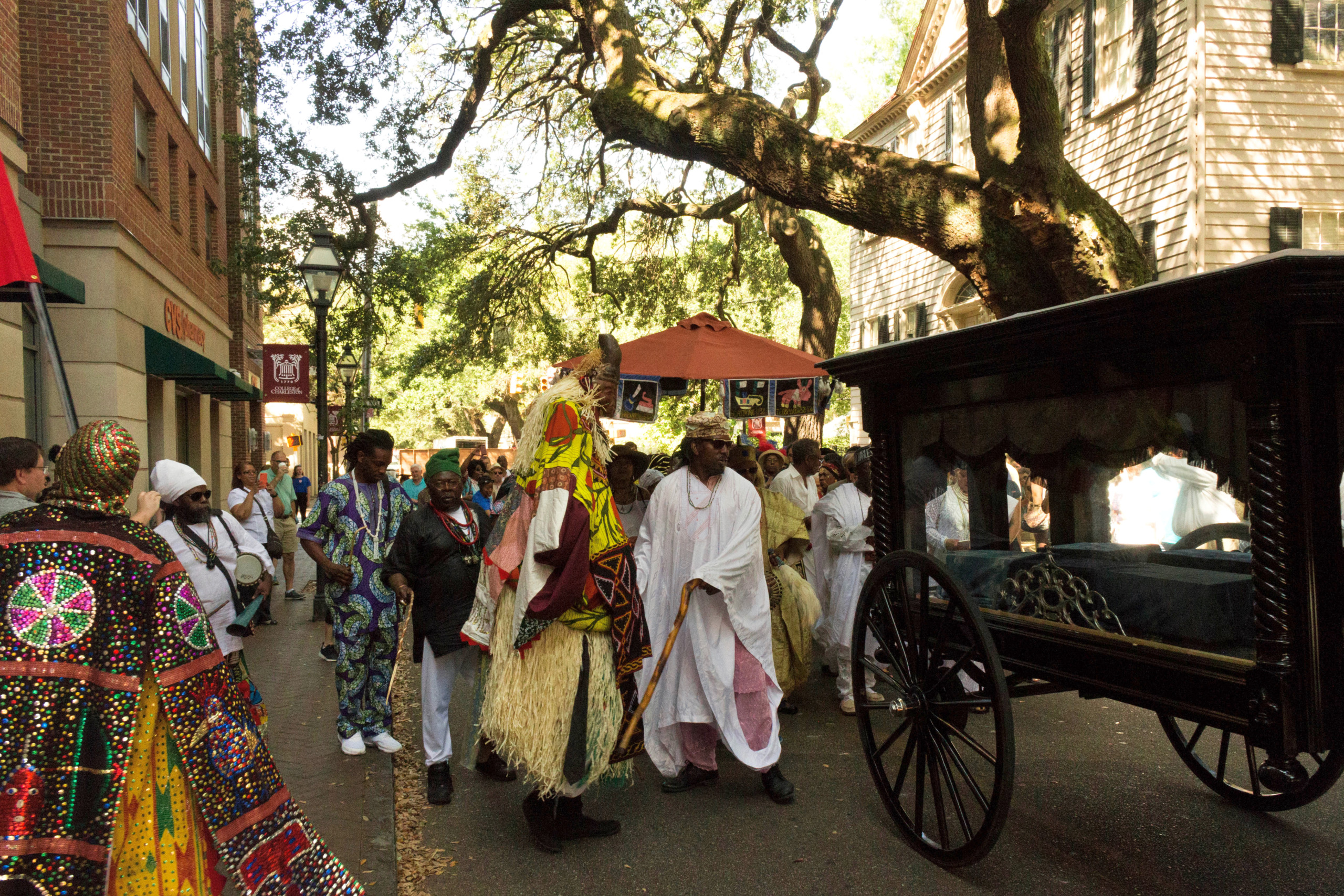
Procession of Ancestors to Their Original Resting Place. Individuals enclosed in reinforced boxes wrapped in indgo cloth were placed in a horse-drawn hearse and taken to the site, accompanied by an Egungun Masquerade, spiritual leaders, and members of the community. Photo Credit: B. M. Ghersi.
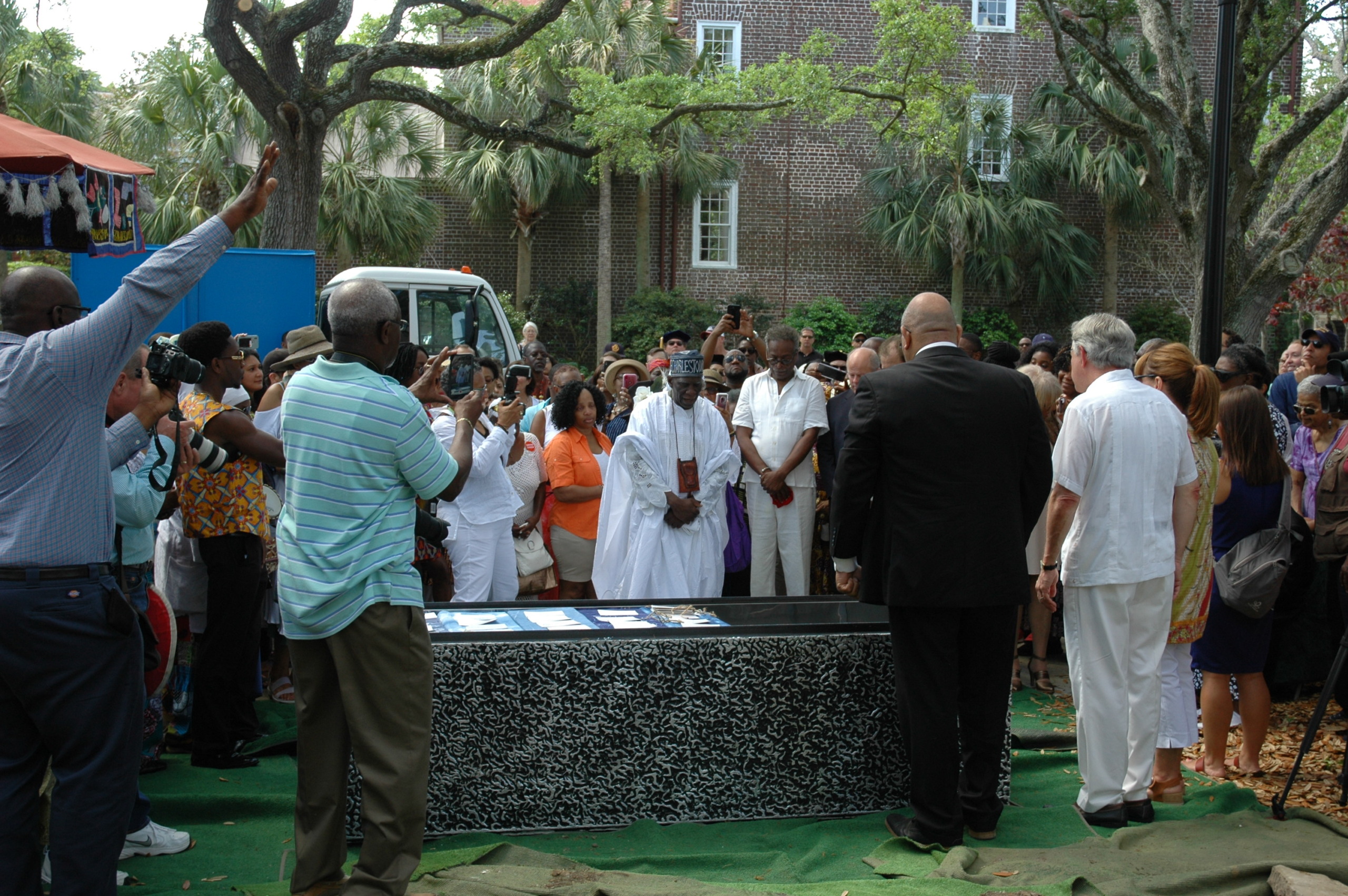
Reinterment Ceremony – 4 May 2022. The reinterment ceremony was led by Dr. Ade Ofunniyin (in center wearing white). He was accompanied by Mayor John Tecklenburg and his wife Sandy (in white on right), spiritual leaders from various faith communities, members of the City Council, and numerous members of the community. Photo Credit: T.G. Schurr
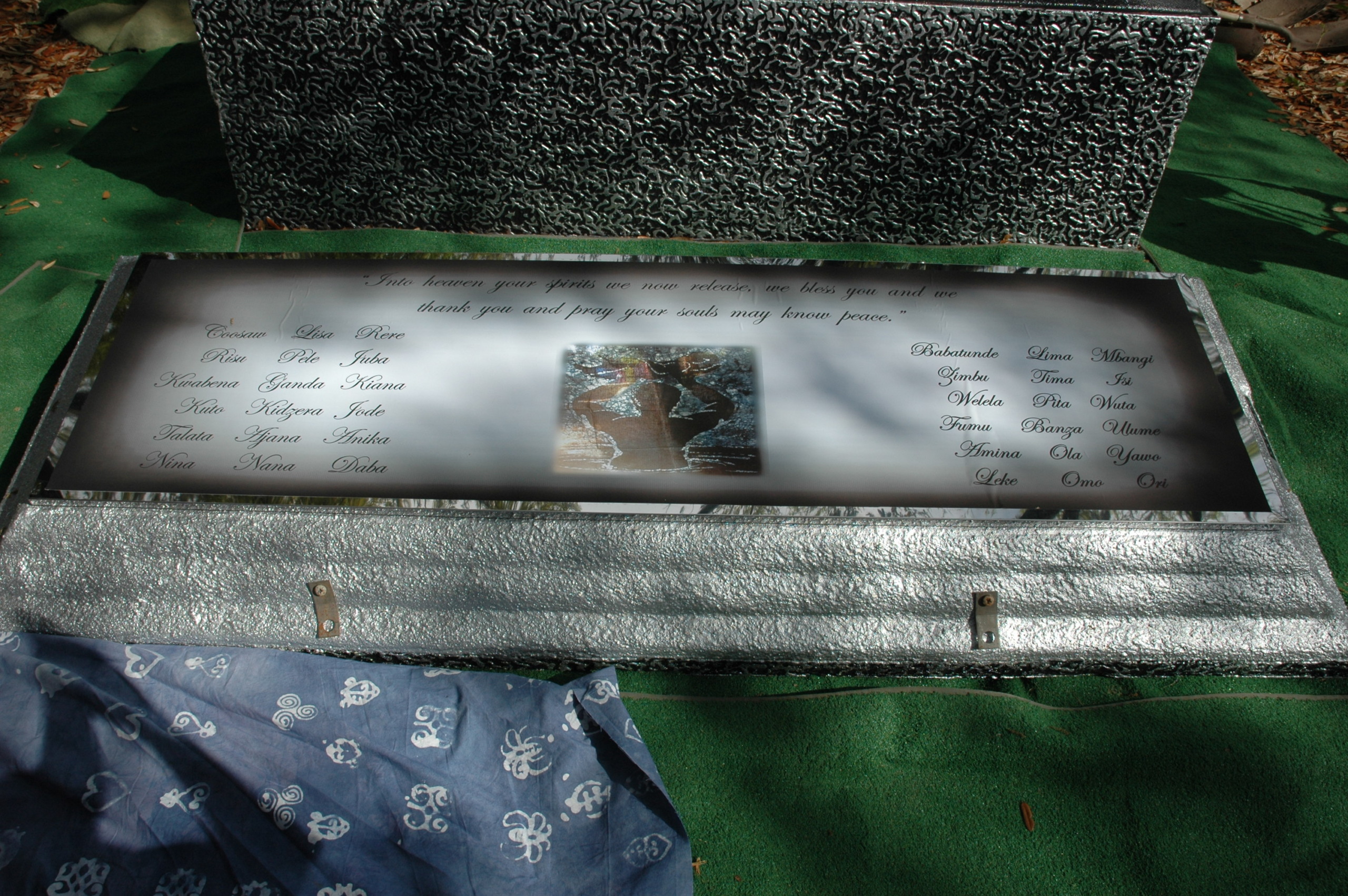
Lid of the Burial Vault for the Ancestors. The names ascribed to the 36 Ancestors through the naming ceremony were inscribed on the lid of the burial vault in which their remains were reinterred. Photo Credit: T.G. Schurr
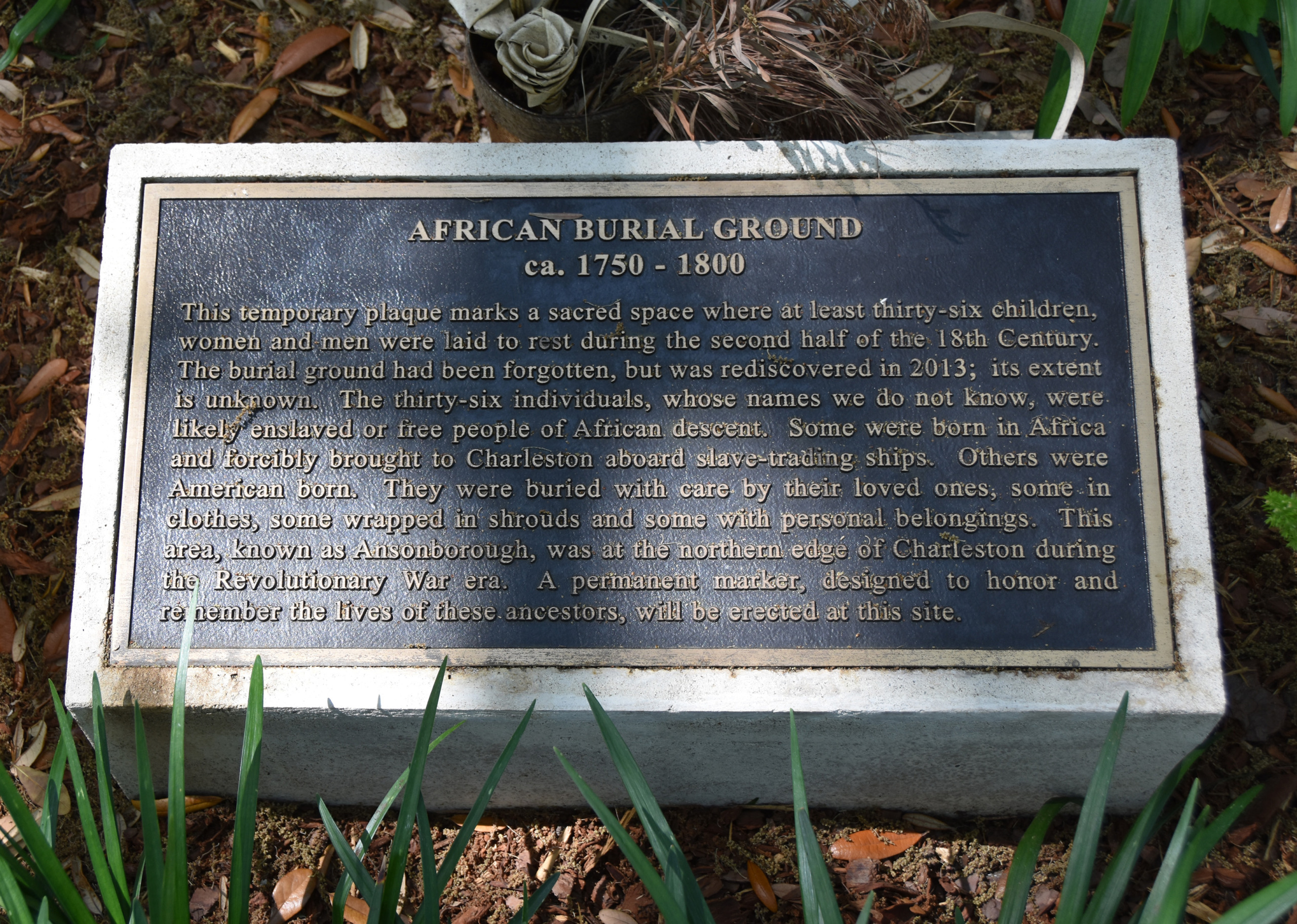
Temporary Memorial for the Ancestors. This plaque marks the location of the reburial of the 36 Anson Street Ancestors and the place where a permanent memorial honoring them will be installed in the next 2-3 years. Photo Credit: Emannu’el Branch.
Post-Reburial Period (May 2019 – April 2022)
During this period of time, which included the main phase of the COVID pandemic, we continued to undertake work related to our mission to preserve, promote, and perpetuate Gullah Geechee culture and traditions, including working with communities to preserve sacred African and African descendant burial sites.
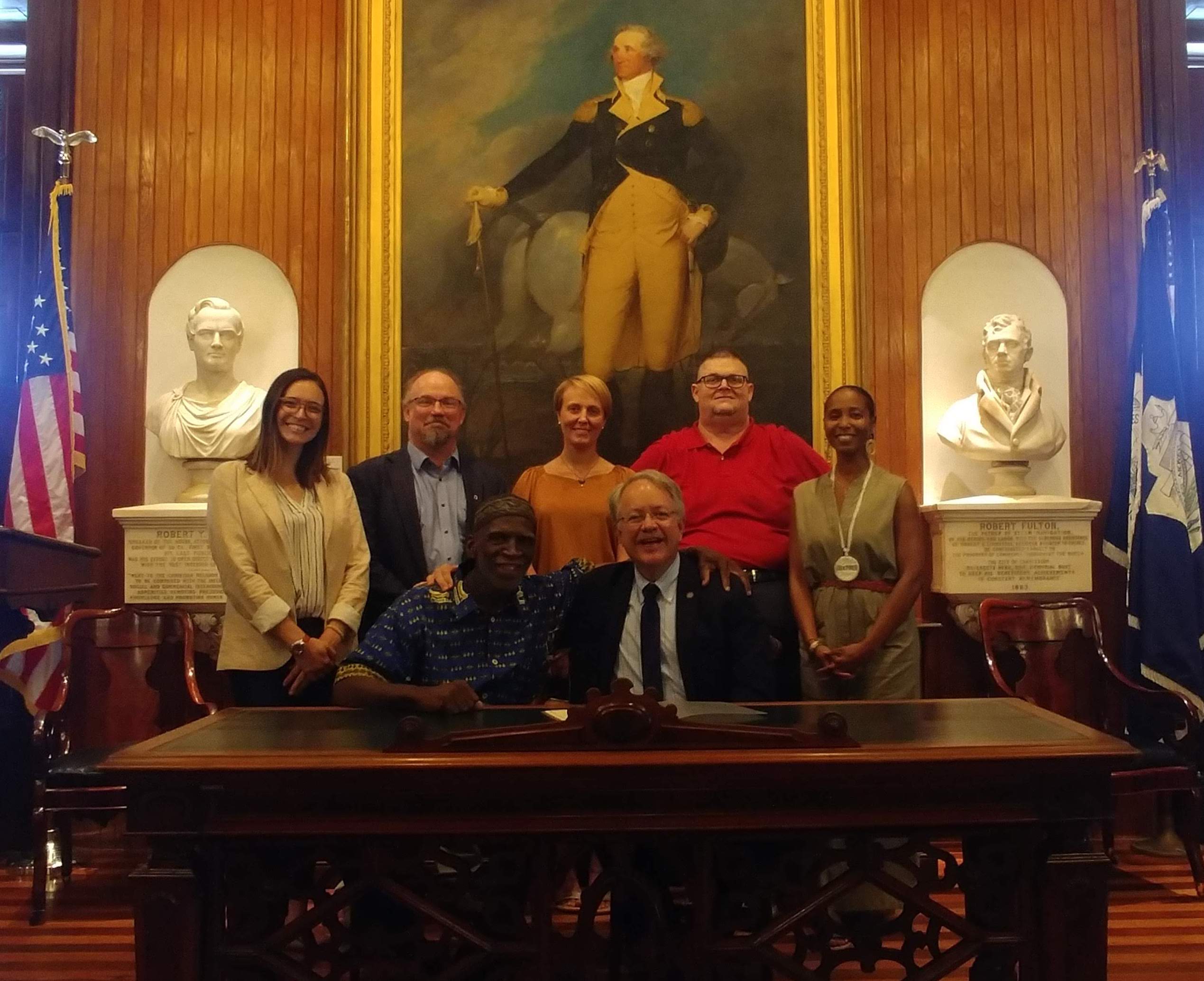
Gullah Society Team Meets with Mayor Tecklenburg in City Hall. The Gullah Society team met with Mayor John Tecklenburg in September 2019 to discuss various matters, including a memorial for the Anson Street Ancestors and support for the preservation of African American burial grounds in Charleston. Front (L-to-R): Dr. Ade Ofunniyin, Mayor John Tecklenburg; Back (L-to-R): Raquel Fleskes, Dr. T.G. Schurr, Joanna Gilmore, Grant Mishoe, Wibi Ashley. Photo Credit: City of Charleston staff member.
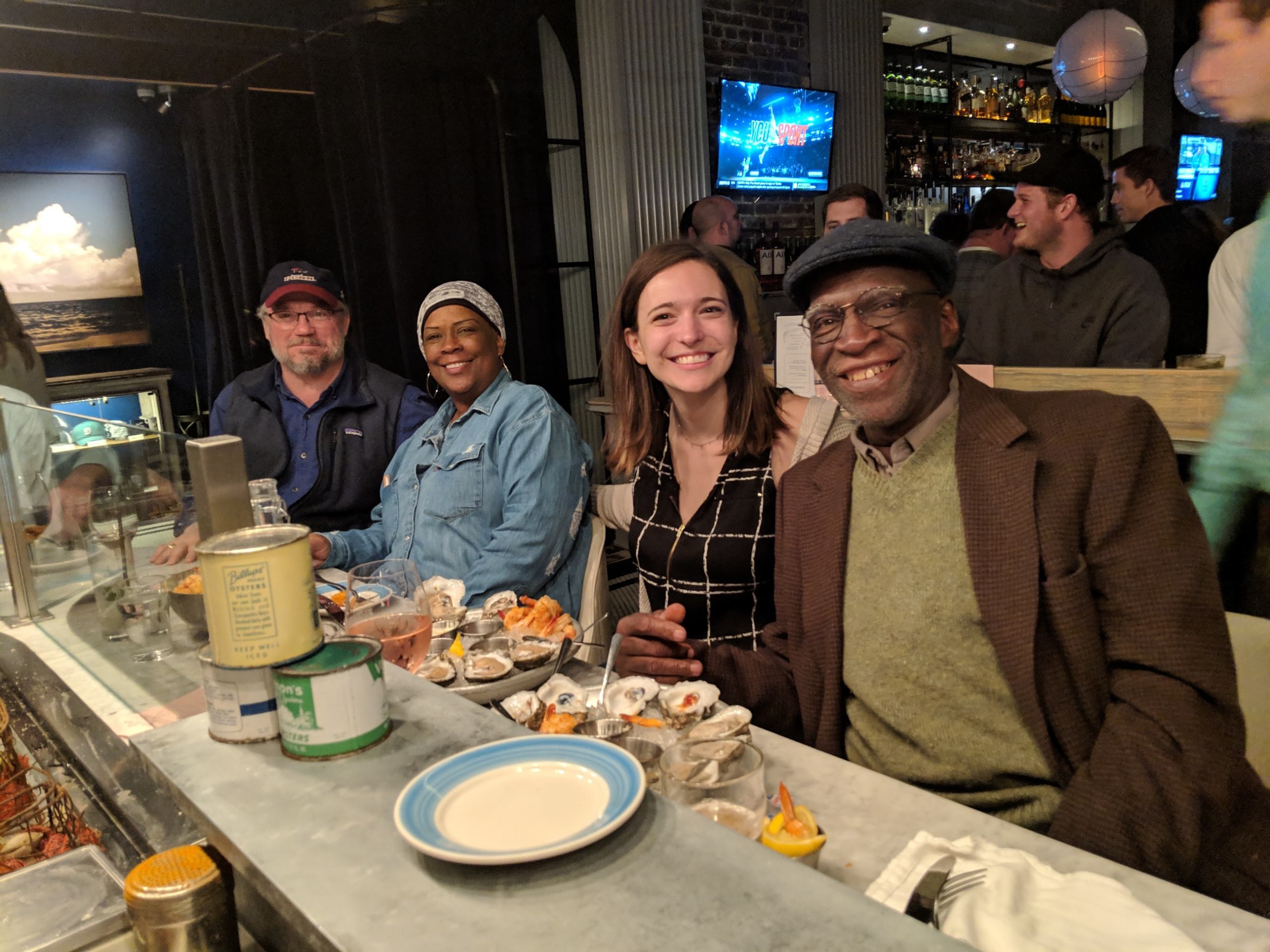
Dinner at The Darling Oyster Bar. After project events and meetings, the Gullah Society team would often reconvene for food and drinks at a local restaurant, such as the Darling Oyster Bar on King Street. We especially enjoyed those serving fresh seafood from the local area. From left to right: T.G. Schurr, La’Sheia Oubré, Raquel Fleskes, and Ade Ofunniyin.
88 Smith Street Property
Through his archival research, Gullah Society Genealogist and Historical Researcher, Grant Mishoe uncovered the location and history of two burial grounds for African descended persons and the real estate transactions involving the 88 Smith Street property since the early 19th century. The property is located south of Calhoun Street, within the Charleston Historic District, which is inscribed in the National Register of Historic Places. The property is one of several adjacent properties that encompass known burial grounds for African descended persons. The back portion of the property was purchased in 1816 by the Trustees of the Circular Congregational Church as a burial ground for “all persons of colour who are attached to or worship with the Independent or Congregational Churches situated in Meeting Street and Archdale Streets.”
From 30 July 1819 to 19 June 1865, a total of 1038 individuals were buried in the Ephrath Burial Ground. Of these, 675 were enslaved people and the remaining 363 were “Free Persons of Color.” By the time of the last burial on 28 February 1934, a total of 1954 interments occurred during a span of 115 years. The front section of the 88 Smith Street property was purchased by the Trustees of the Trinity Methodist Episcopal Church in 1818. From this date until 1872, a total of 1653 people were buried in this cemetery. Together, the cemeteries contain the remains of generations of neighborhood families that number nearly 3600 individuals. After 1934, no further interments were made, and the land became a private residence.
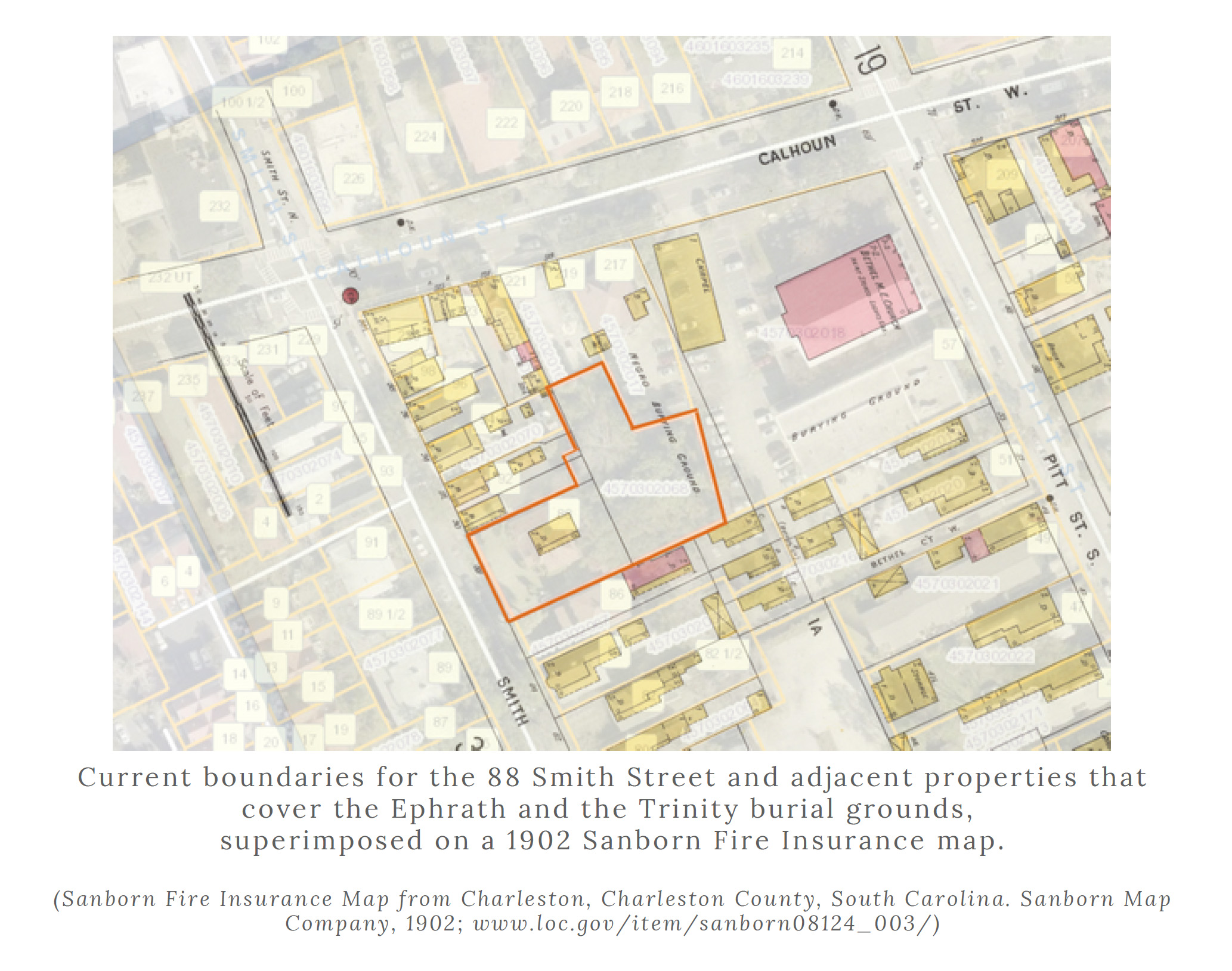
Schematic Map Showing the Position of the 88 Smith Street Property in Downtown Charleston
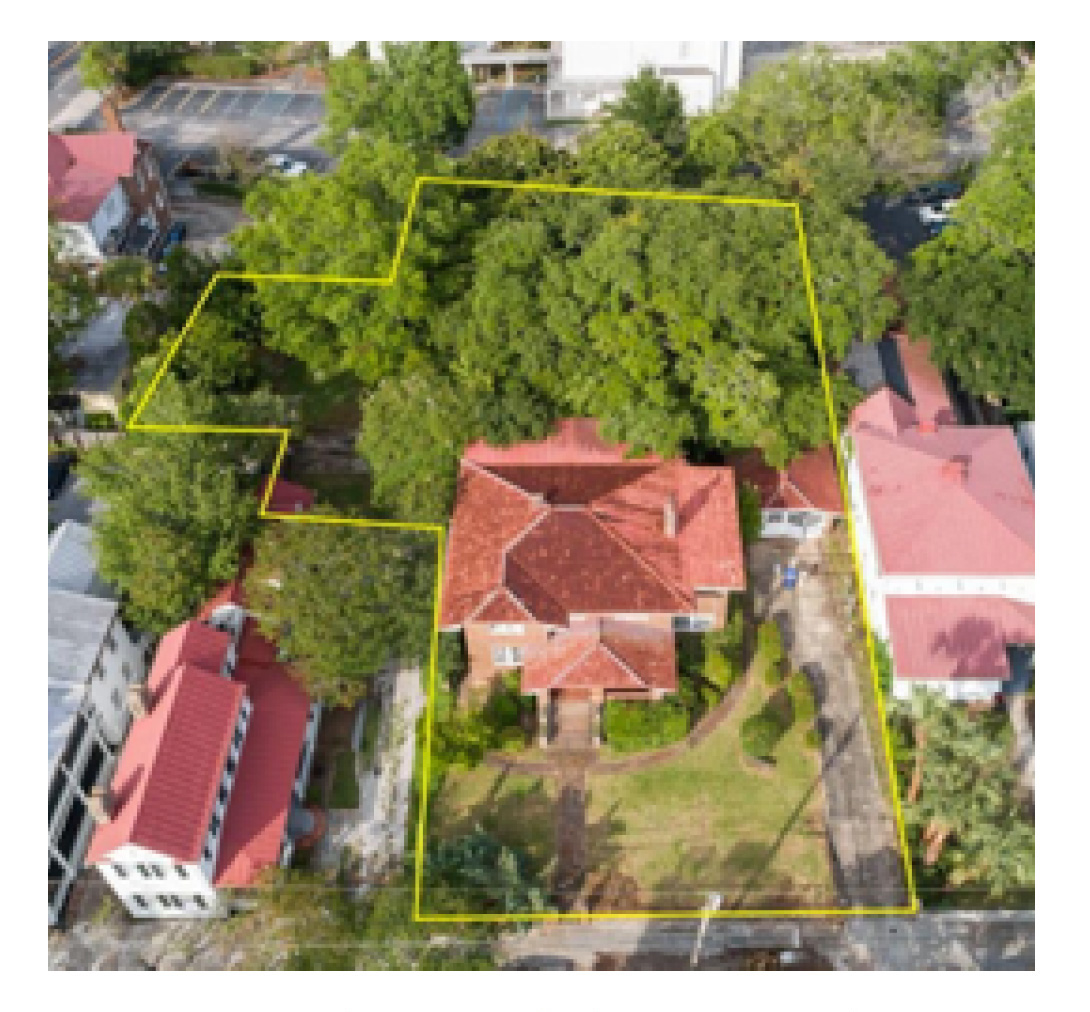
Aerial View of the 88 Smith Street Property
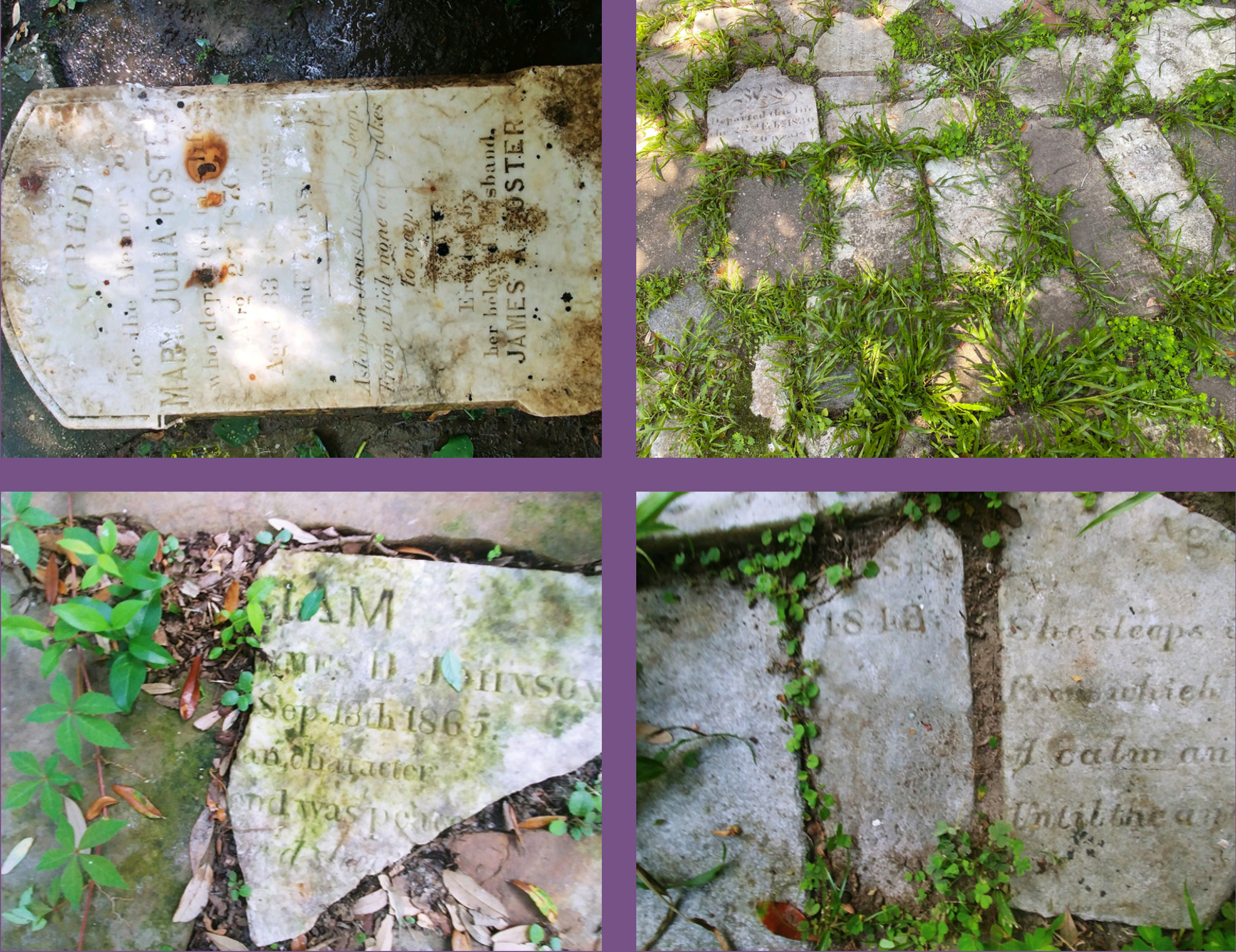
Headstones from Graves in the Ephrath Burial Ground Used for Pavers, Sidewalks and Other Purposes at 88 Smith Street
The Gullah Society became interested in purchasing the 88 Smith Street property after learning it covered much of the two African American burial grounds. The potential purchase of this property presented a rare opportunity to preserve and honor the sacred burial ground for more than 3600 people of African descent. In North America, there are few examples of burial grounds that contain the specifically-documented burials of enslaved and free people of African descent from antebellum times through the early 20th century. Restoring, preserving and interpreting this sacred site would therefore have been a nationally significant accomplishment.
A successful project at this property would honor the lives of the deceased, add depth to understanding of Charleston and U.S. history, and inspire people for the future. The documentary record associated with the individuals buried at Ephrath and Trinity Methodist Episcopal burial grounds also contains over one hundred years of this community’s spiritual and cultural heritage. Further historical research is enriching our understanding the people interred at these burial grounds and has resulted in contact being made with their descendants. For this reason, the Gullah Society team felt that the protecting the property as a cemetery and cultural site would contribute significantly to honoring past Charleston residents, and educating all Americans.
Unfortunately, due to logistical and financial issues and the declining health of Dr. Ade Ofunniyin, the Gullah Society was unable to complete the purchase of the property, and it was sold to a private owner.
Passing of Ade Ofunniyin
On 7 October 2020, Dr. Ade Ofunniyin passed away after medical complications related to cancer and joined the Ancestors whose lives he had done so much to honor and respect. We were deeply affected by Ade’s death given his centrality to Gullah Society activities and his friendship with all of us. This loss felt especially acute in light of the fact that our first major paper describing research with the Ancestors’ remains had been accepted for publication on the day before his death.
An obituary for Dr. Ofunniyin that nicely summarizes his life appeared in the Charleston P0st & Courier on 8 October 2020: https://www.postandcourier.com/news/obituaries/ade-ofunniyin-founder-of-the-gullah-society-dies-at-67/article_6456bd22-096f-11eb-aa0c-877ba40c80a4.html
A memorial service was held for Dr. Ofunniyin in Charleston on 24 October 2020.
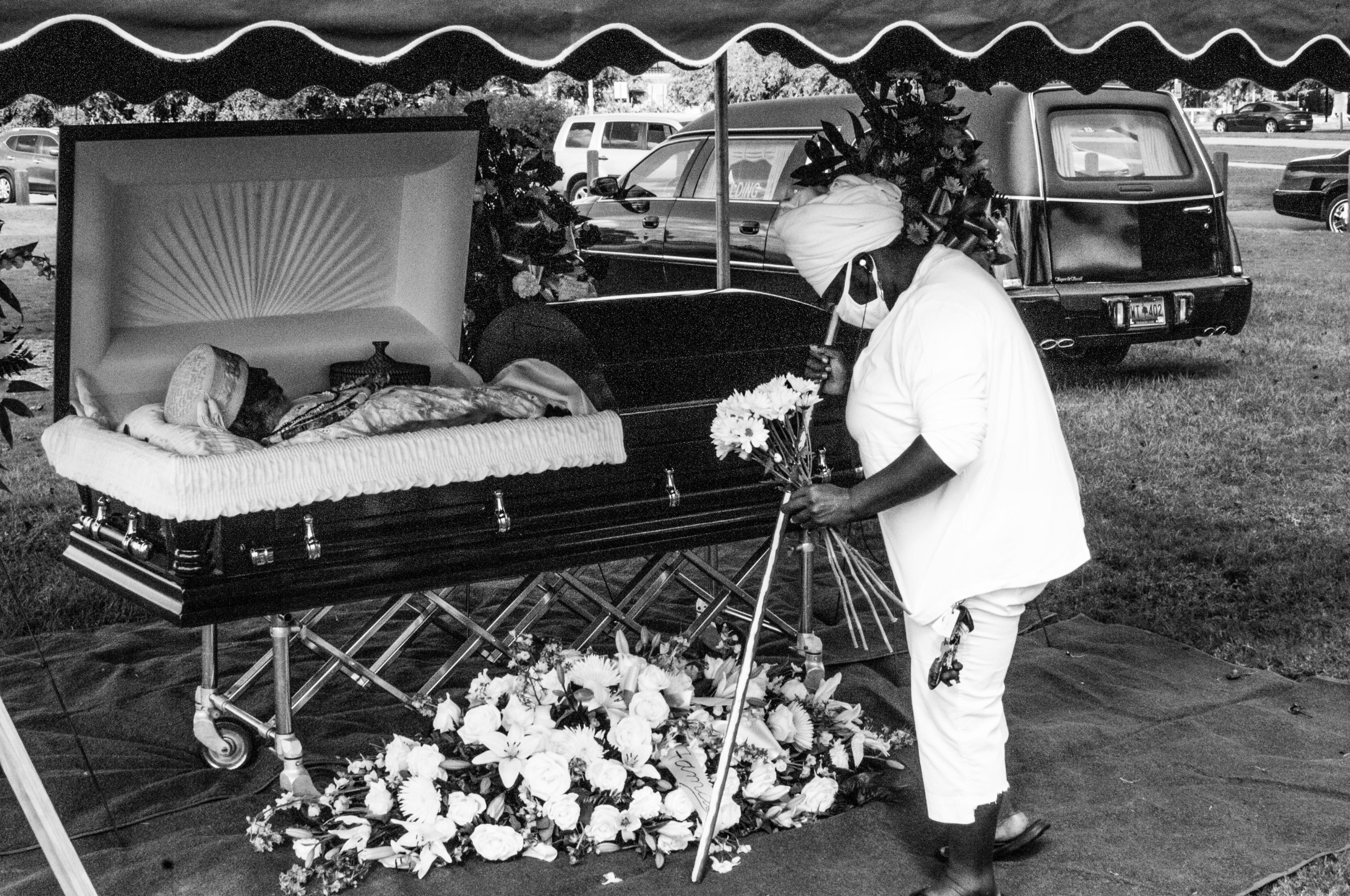
Memorial Service for Dr. Ade Ofunniyin. In this photo, Dr. Ofunniyin is dressed in his Yoruba priest regalia as he rests inside the casket. Photo Credit: Debra Nobles McDaniel.
Anson Street African Burial Ground (ASABG) Project
In the wake of Dr. Ofunniyin’s passing, the Gullah Society went through many months of self-assessment as executive board members reviewed the financial and logistical details related to the organization’s operation. After this extended evaluation, the executive board decided to dissolve the Gullah Society as a 503.1c organization. It also shifted the African American Cemetery Fund that was set up to support research and preservation of African American burial grounds to the Preservation Society.
In light of these decisions and given their ongoing commitment to the organization’s mission, the remaining members of the Gullah Society – Joanna Gilmore, La’Sheia Oubré, Raquel Fleskes, and Theodore Schurr – reconstituted themselves as the Anson Street African Burial Ground (ASABG) Project team in the fall of 2020. They have continued to work on projects first initiated by the Gullah Society, including the scientific research on the lives of the Anson Street Ancestors, and also worked with other organizations and individuals to develop a design for the permanent memorial to the Ancestors.
To follow the work of the ASABG Project team, please go to the project website, which is continuously updated: Link
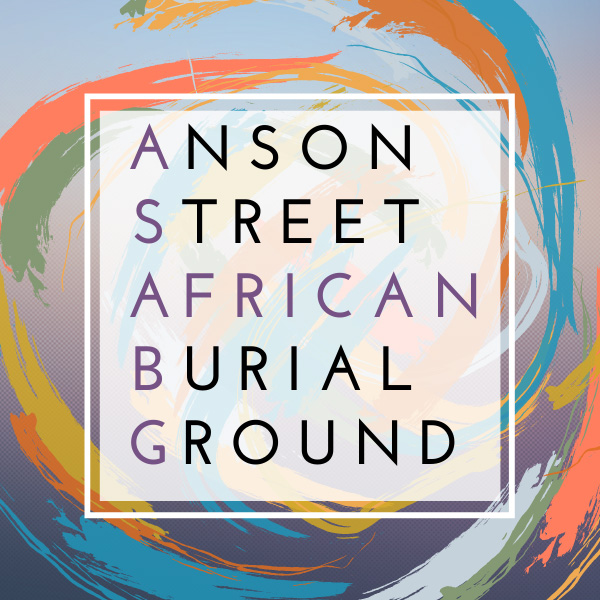
Genomic DNA Analysis of the Ancestors
Following the reburial of the Ancestors, we focused our attention on the genomic analysis of the DNA samples from the Ancestors to gain further insights into their ancestry and origins.
Dental Calculus Analysis
As part of the extended bioarchaeological analysis of the Anson Street Ancestors, in January 2022, the ASABG team initiated a study of microbiome diversity in dental calculus in a subset of these archaeological individuals in collaboration with Dr. Cecil Lewis, Co-Director of the Laboratory of Molecular Anthropology and Microbiome Research (LMAMR) at the University of Oklahoma, and his team. Members of the LMAMR team involved in the project include Chris Abin, Laboratory Manager; Sarah Johnson, PhD student in Anthropology; and Dr. Tanvi Honap, Research Assistant Professor.
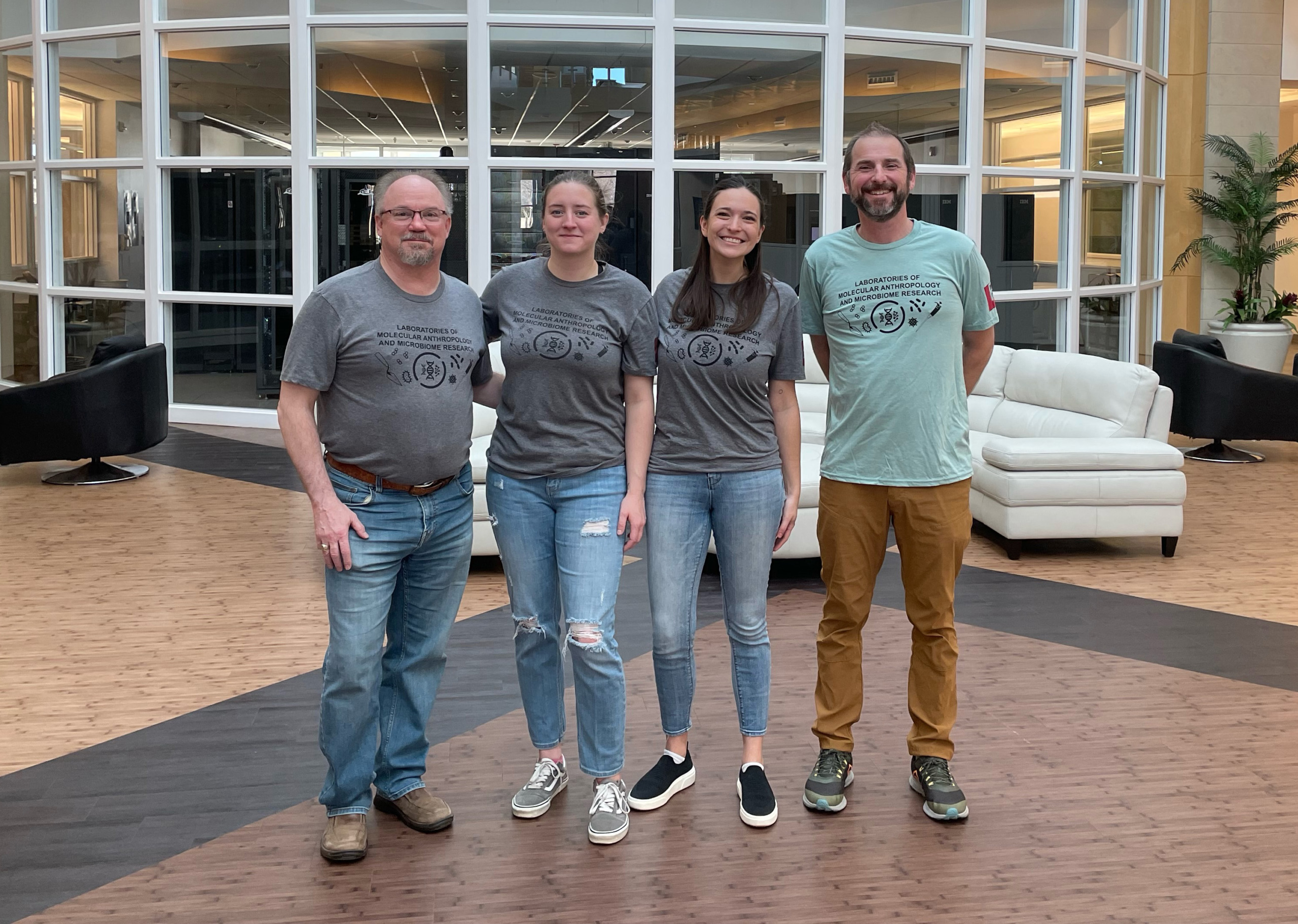
Penn-LMAMR Collaborators. Team meeting in the lobby of the Stephenson Research & Technology Center, University of Oklahoma: From left to right: Dr. Theodore Schurr, Sarah Johnson, Dr. Raquel Fleskes, and Dr. Cecil Lewis. Photo Credit: Cecil Lewis.
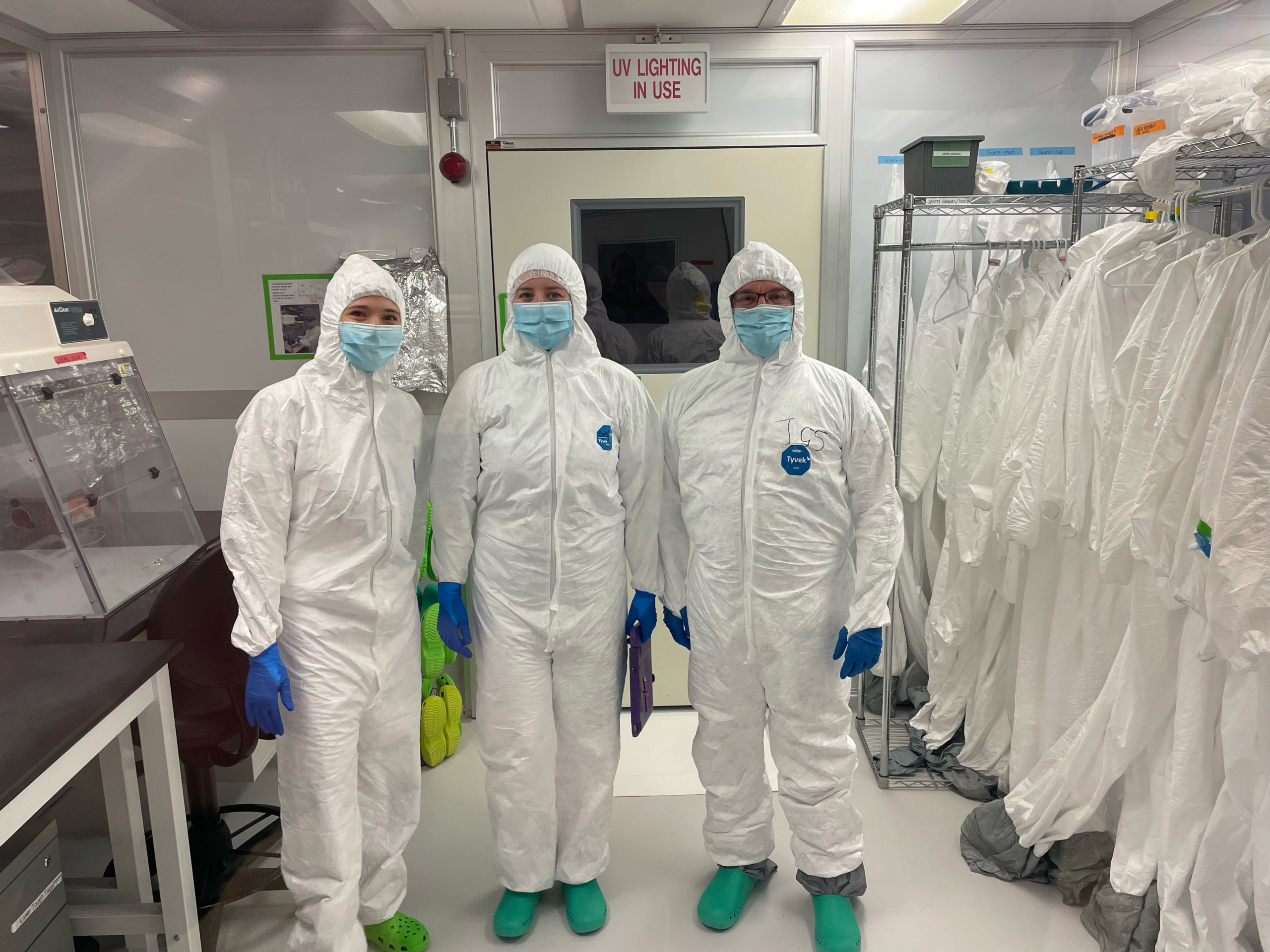
Working in the LMAMR Ancient DNA Laboratories. Shown in full personal protective equipment are (left to right) Dr. Raquel Fleskes, Sarah Johnson and Dr. Theodore Schurr. Photo Credit: Cecil Lewis.
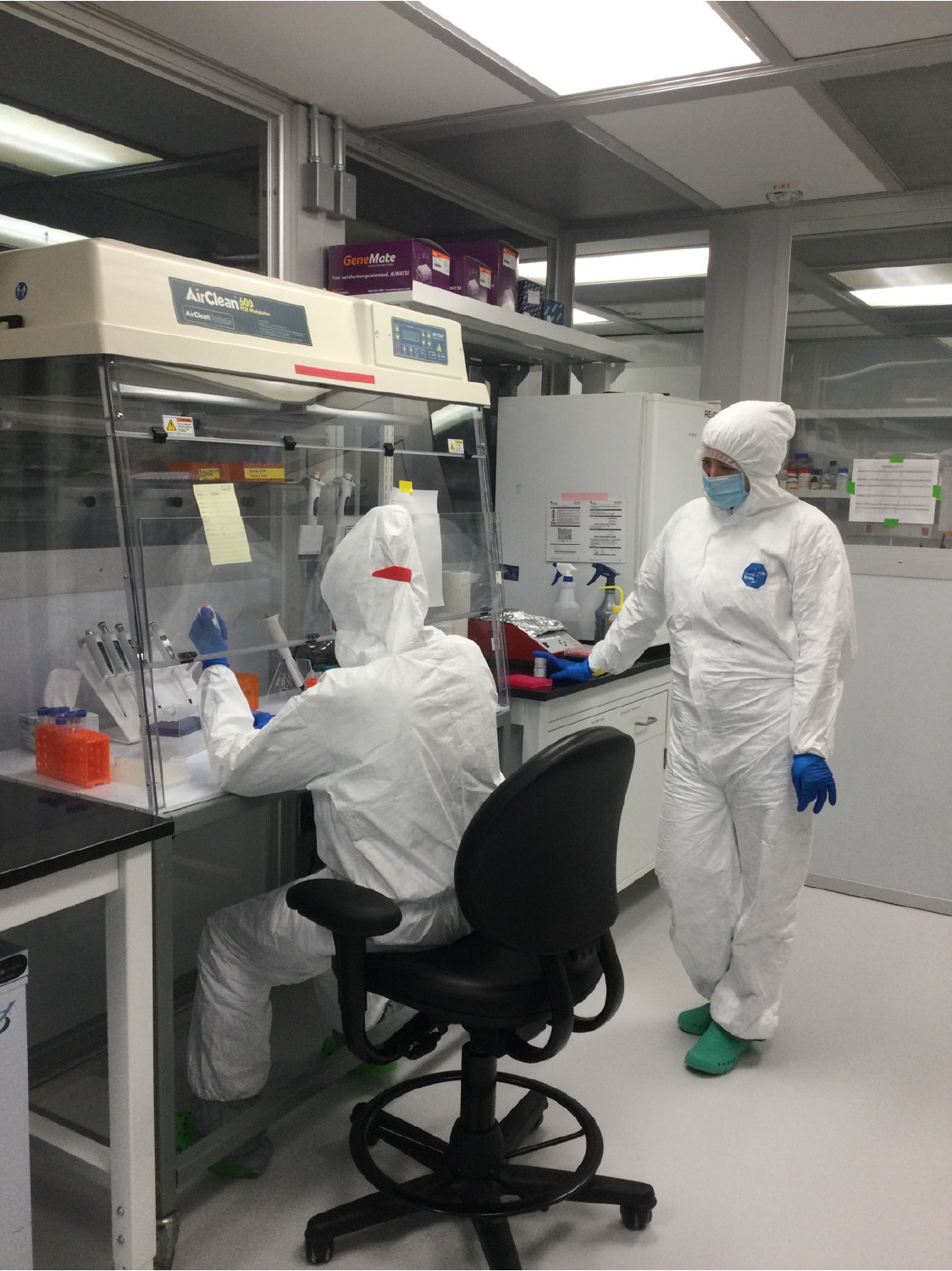
Training in Dental Calculus Analysis. Sarah Johnson (right) is guiding the training of Dr. Raquel Fleskes in dental calculus extraction methods. Photo Credit: T.G. Schurr
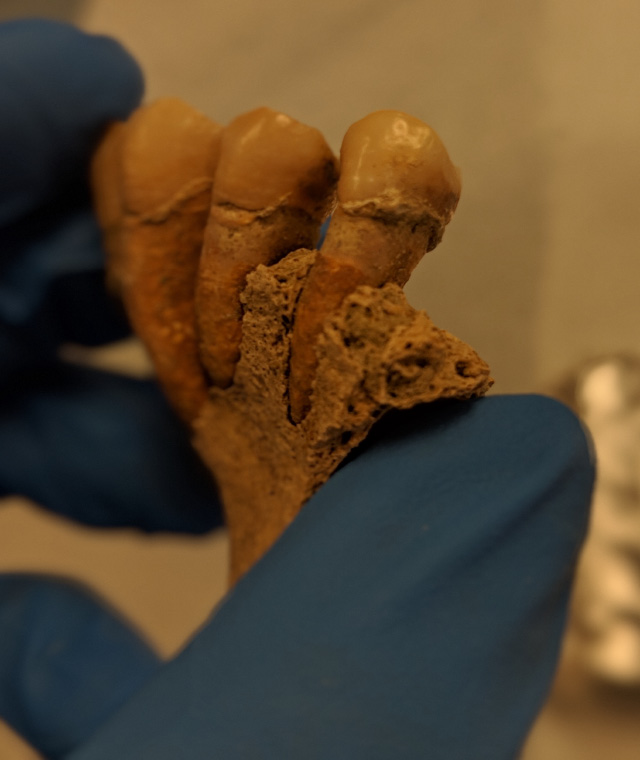
Dental Plaque on a Tooth of an Anson Street Ancestor. Photo Credit: T.G. Schurr
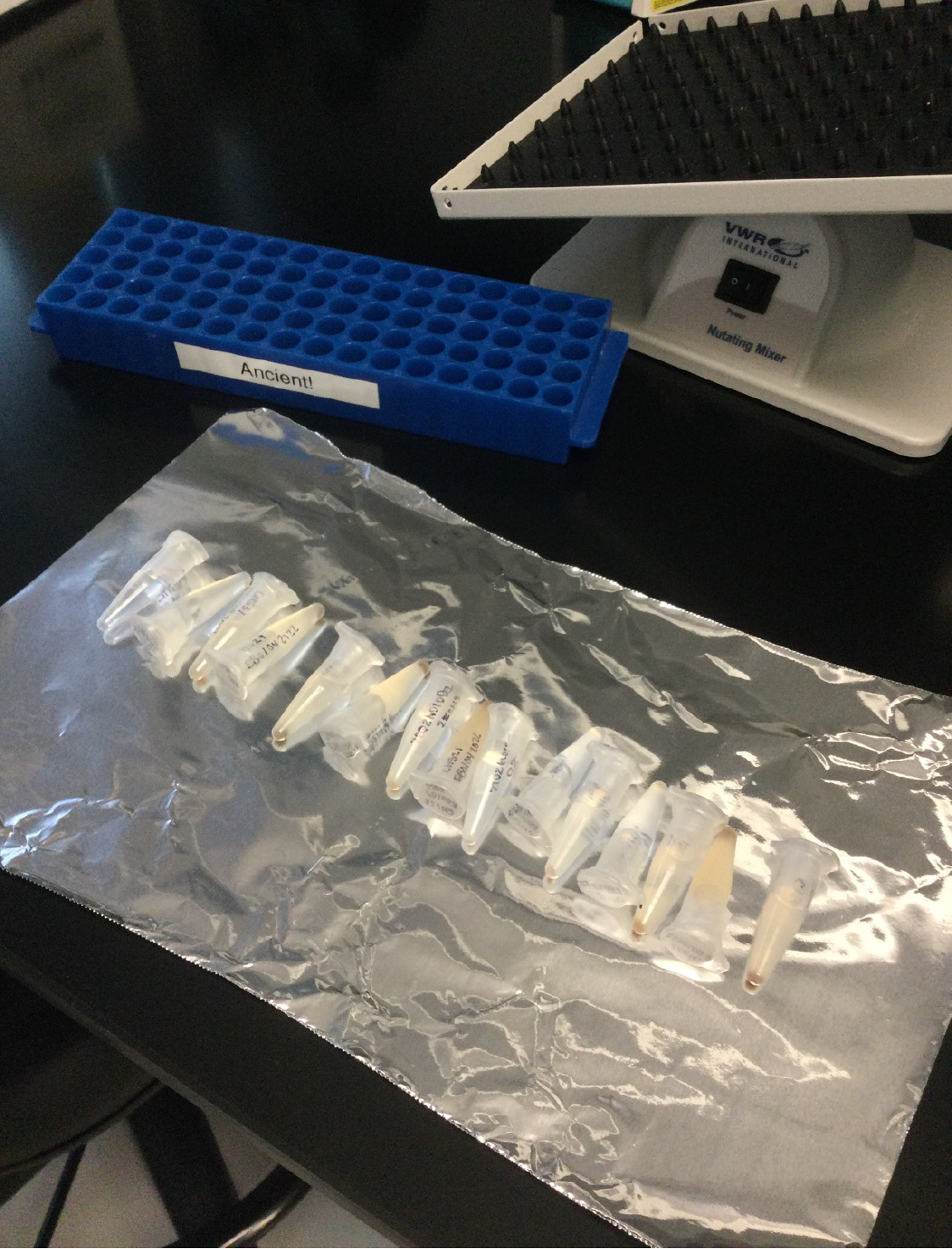
Dental Calculus Samples Being Extracted for DNA. Photo Credit: T.G. Schurr
For this study, we obtained dental calculus from the teeth of 14 of the 36 Anson Street Ancestors. The extraction method yielded viable ancient genomic DNA samples from 12 of these 14 individuals. The initial analysis of metagenomic (bacterial) sequences from 11 of 12 individuals were very good. After analyzing the microbiome data, we identified the bacterial species present in the dental calculus samples of the Ancestors. Through this taxonomic analysis, we have investigated their possible functional role in health and disease of these species (taxa) and relationship to dental and oral pathologies (peridontal disease) present in the Ancestors. The results of this work have been summarized in a manuscript currently under review at Communications Biology.
Honoring the Ancestors – 3rd Year Anniversary of Reinterment
After two years of hosting virtual-hybrid events to commemorate the reburial of the Anson Street Ancestors, due to the COVID pandemic, we held in-person events to celebrates their lives during 3-4 May 2022.
The main event took place on the evening of 4 May at the corner of Anson and King Streets where the Ancestors were reburied. The celebration involved the drumming and pouring of libations, prayers, short speeches and the recitation of the honorary names bestowed on the Ancestors.
Ervin McDaniel and Clifton Polite led the drumming and libations; prayers were given by Servant Emanu’el Branch and the Reverend Willie Hill of St. John’s Episcopal Church; speeches were given by Theodore Schurr (ASABG team), Lissa Frenkel (CEO, Gaillard Center), Tonya Matthews (CEO, IAAM), and Grant Gilmore III (Center for Study of Slavery in Charleston, College of Charleston); and the recitation of the Ancestors’ names was conducted by La’Sheia Oubré, Joanna Gilmore and Raquel Fleskes (ASABG team) and Sterling DeVries (Gaillard Center).
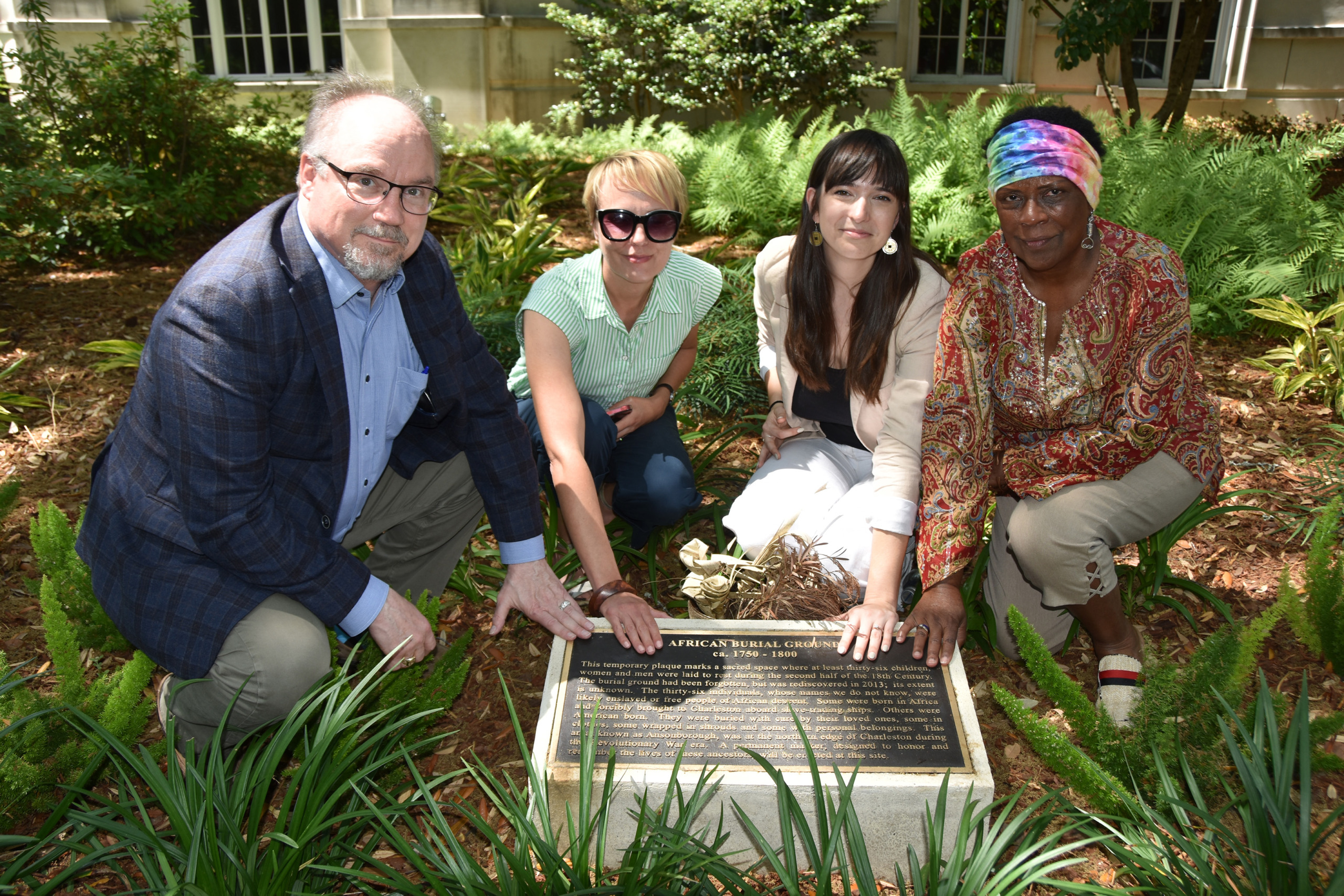
ASABG Team at the Anson Street Ancestors’ Burial Site – May 2022. From left-to-right: Theodore Schurr, Joanna Gilmore, Raquel Fleskes, La’Sheia Oubré. Photo Credit: Servant Emannu’el Branch.
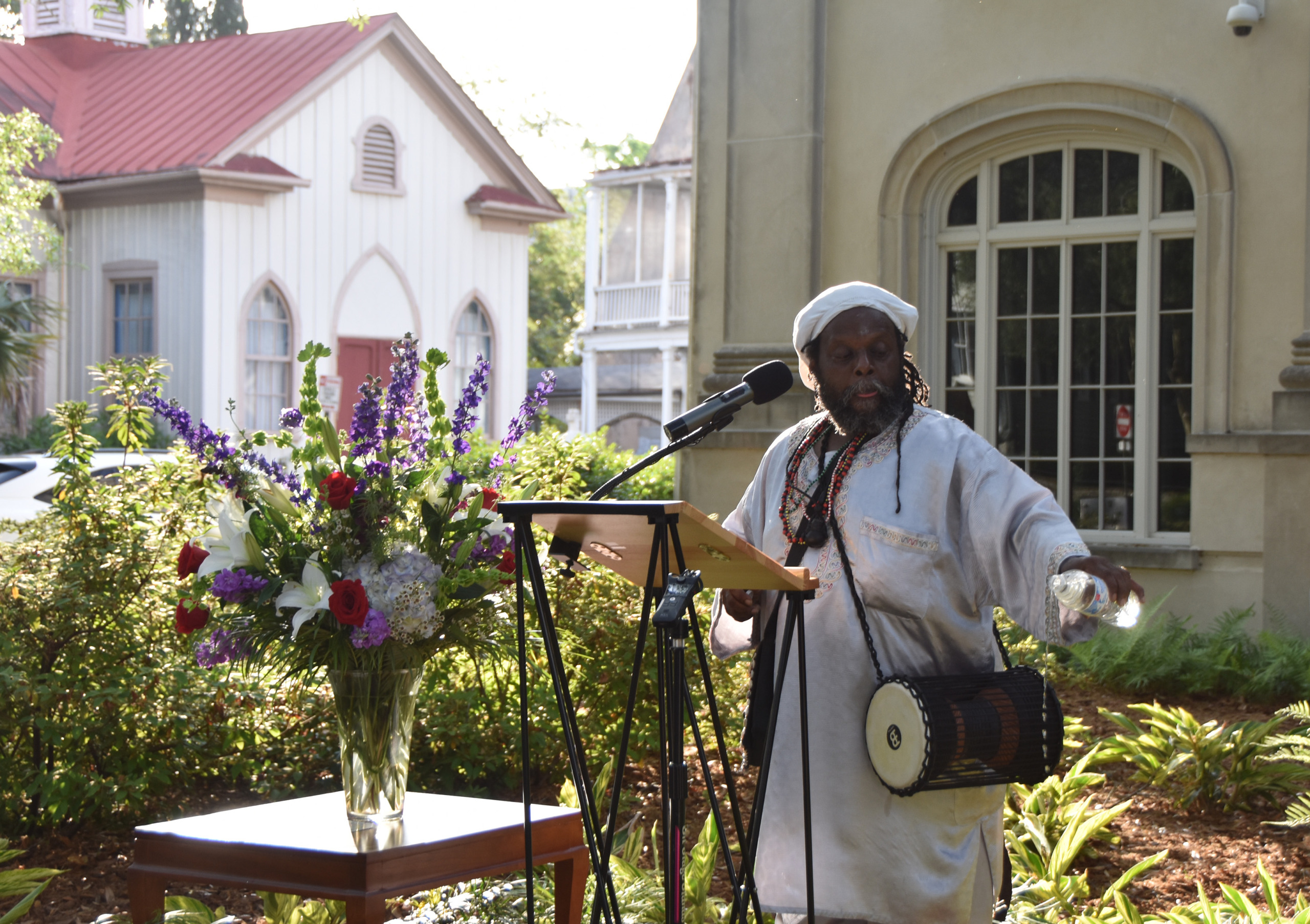
Drumming and Pouring of Libations by Clifton Polite. Ervin McDaniel not shown. Photo Credit: Servant Emannu’el Branch
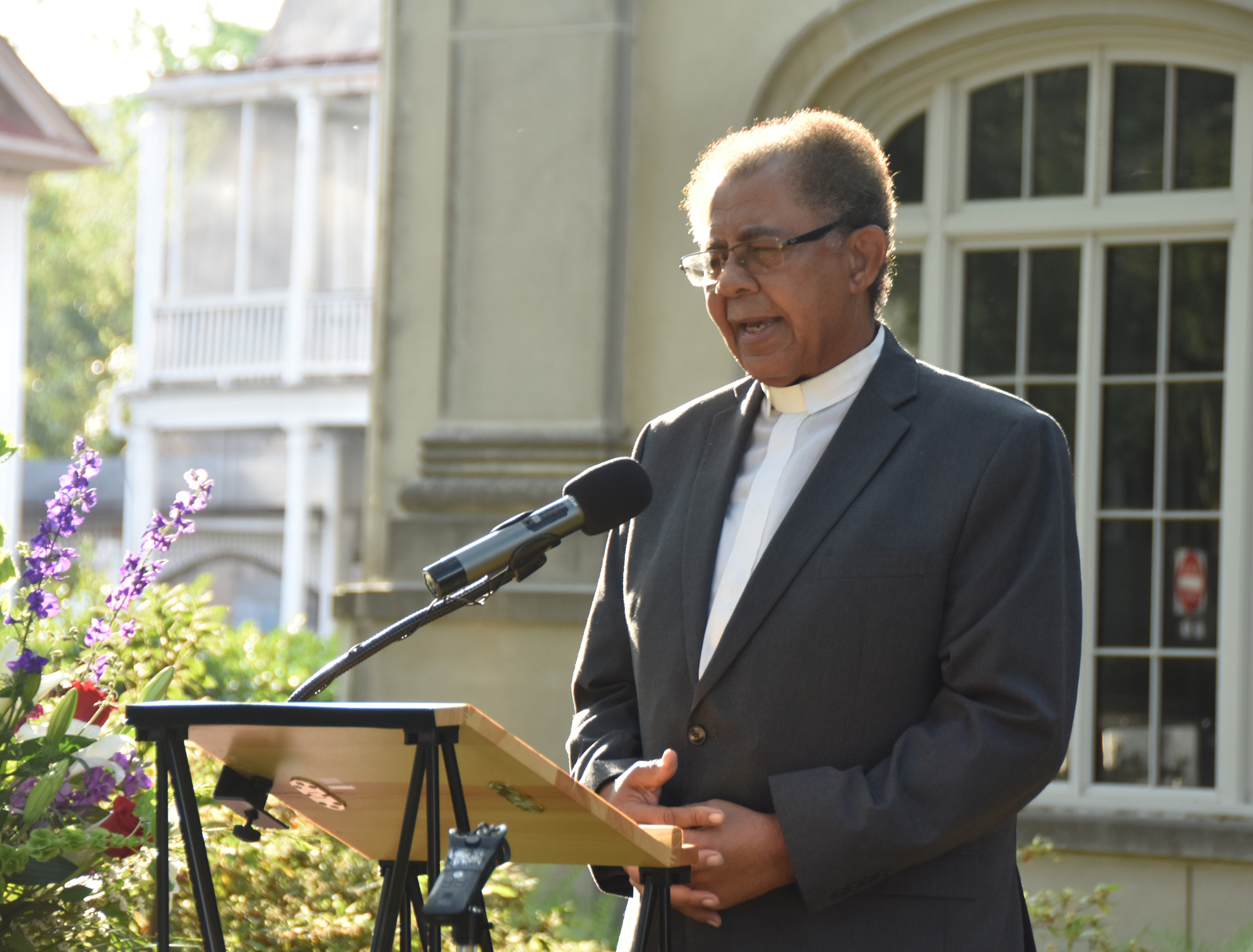
The Reverend Willie Hill Leading the Invocation. Photo Credit: Servant Emannu’el Branch
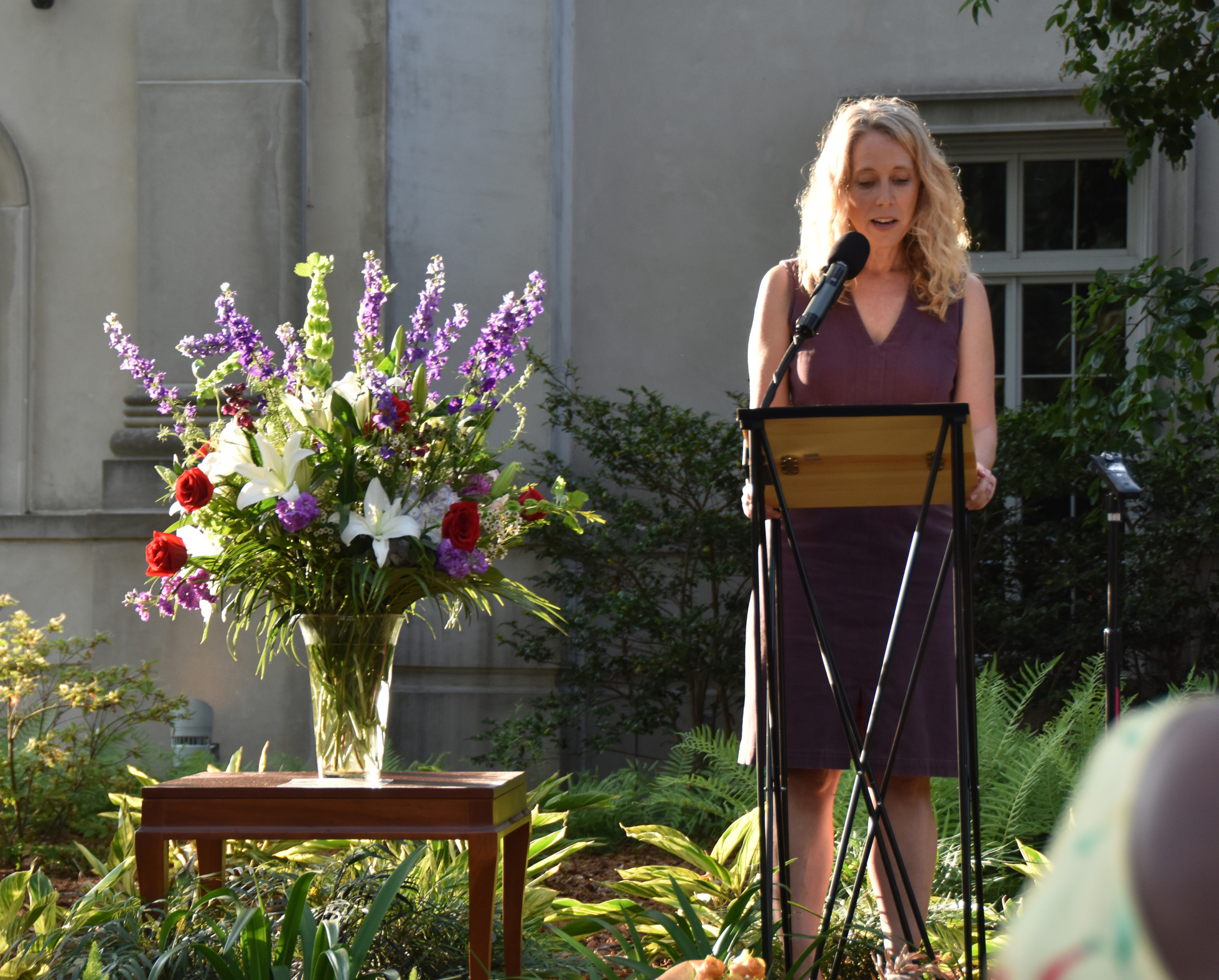
Lissa Frenkel, CEO of the Gaillard Center, Giving Remarks. Photo Credit: Servant Emannu’el Branch
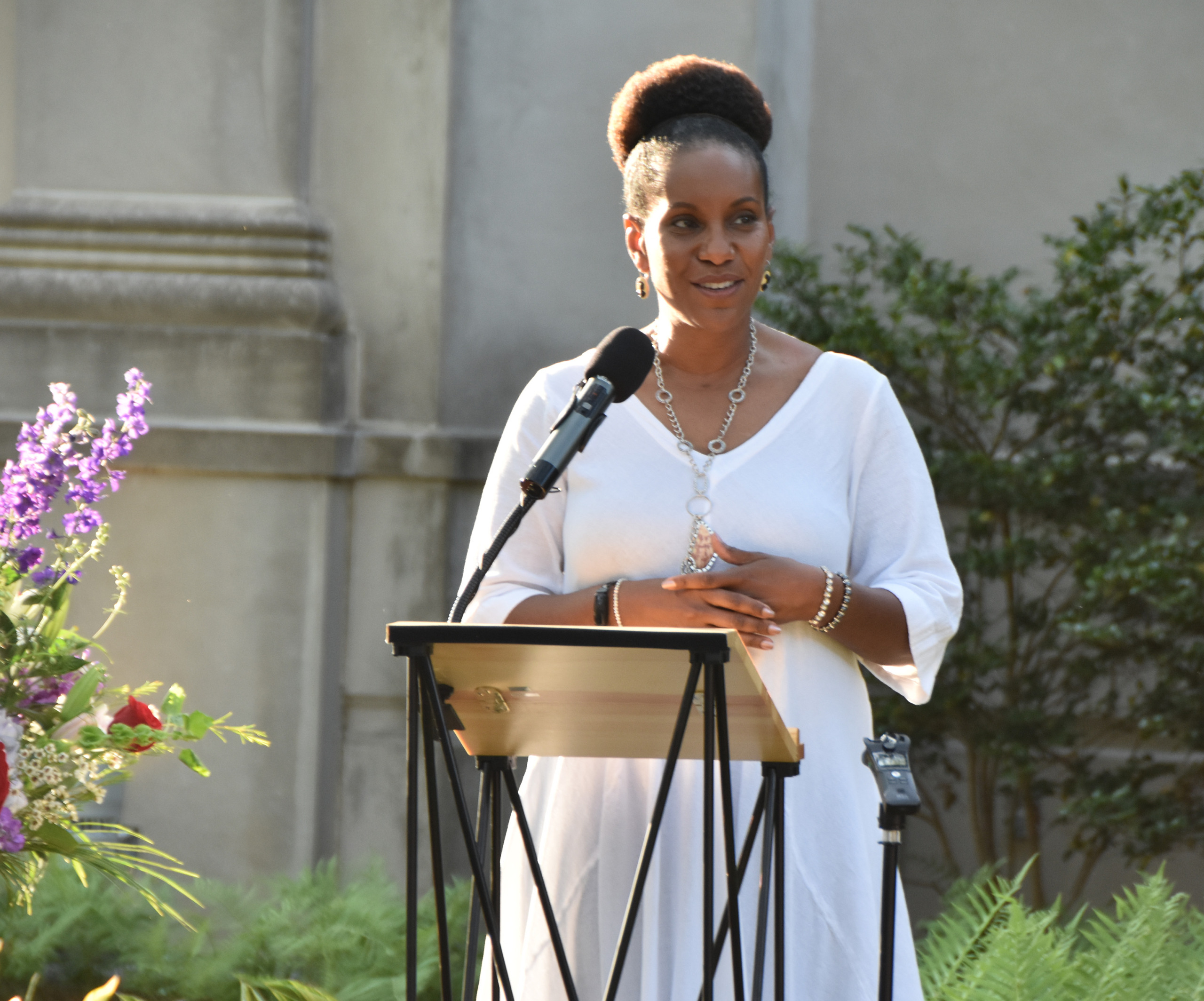
Dr. Tonya Matthews, CEO, International African American Museum, Giving Remarks. Photo Credit: Servant Emannu’el Branch
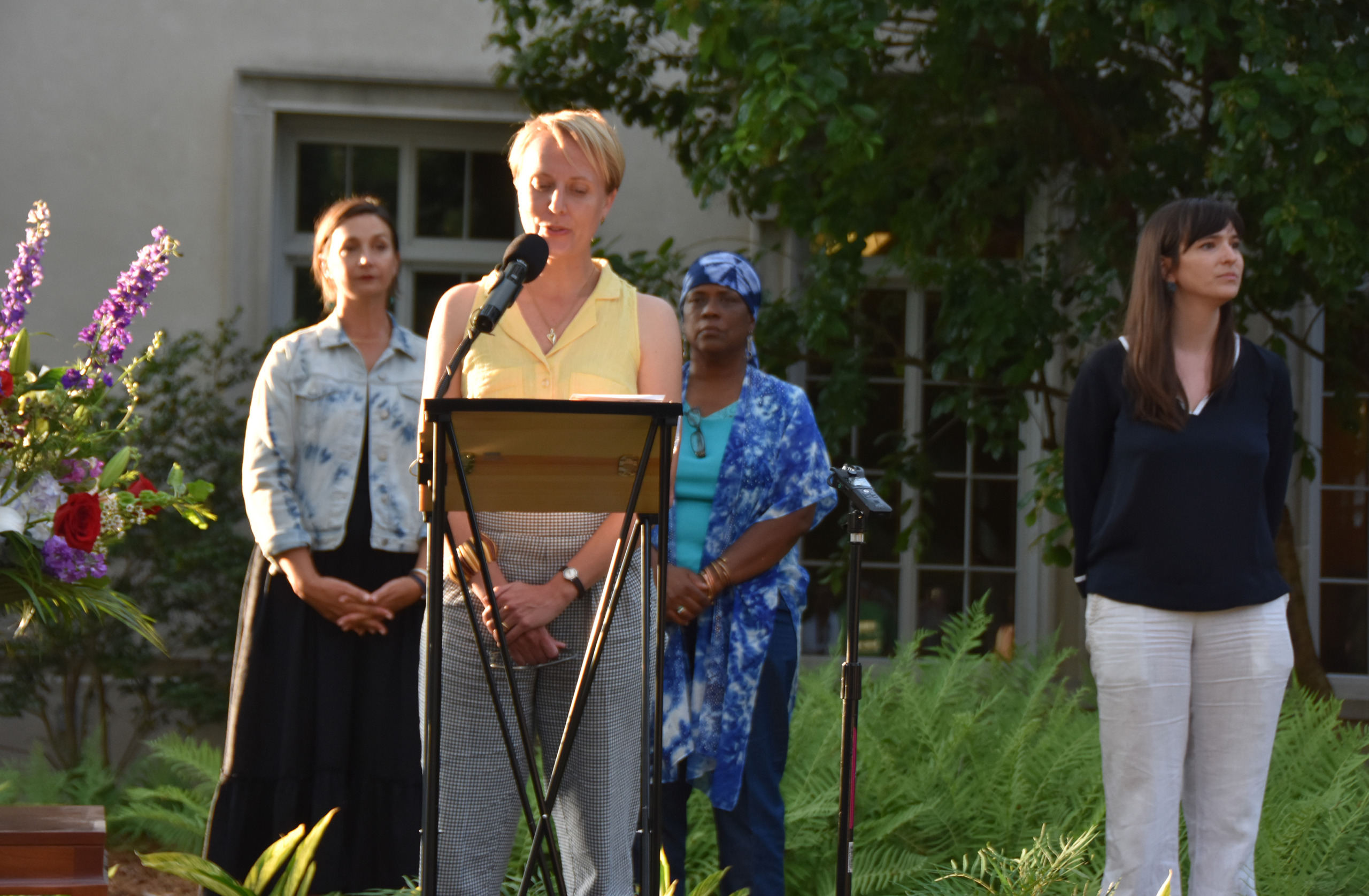
Reading of the Names of the Ancestors. From Left-to-Right: Sterling DeVries, Joanna Gilmore [front], La’Sheia Oubré, Raquel Fleskes [rear]. Photo Credit: Servant Emannu’el Branch
Truth Rising: Honoring African Presence in Charleston
As part of the 3rd anniversary commemoration of the reburial of the Anson Street Ancestors, we held dual events at the Cannon Street Arts Center on 3 May 2022. We first presented the current results of our scientific investigation of the lives of the Ancestors, and then convened a panel of community representatives to discuss the design plans for the Anson Street Ancestors memorial. Photo Credit: Servant Emannu’el Branch.
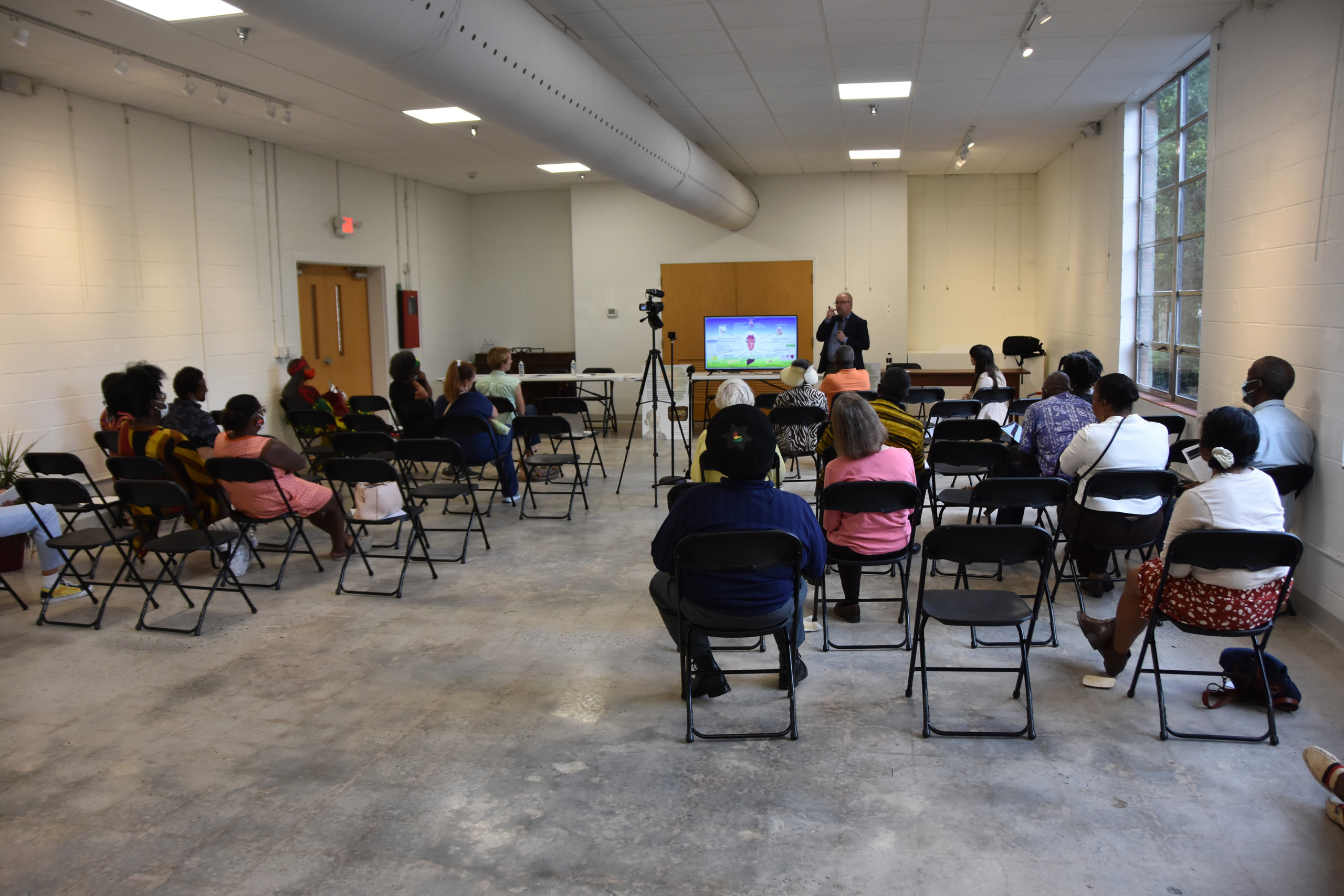
Presentation of Research Results for the Anson Street Ancestors. Dr. Raquel Fleskes presented an update on the whole genome analysis of the Ancestors, and Dr. Theodore Schurr discussed the initial findings of the dental calculus analysis. Photo Credit: Servant Emannu’el Branch
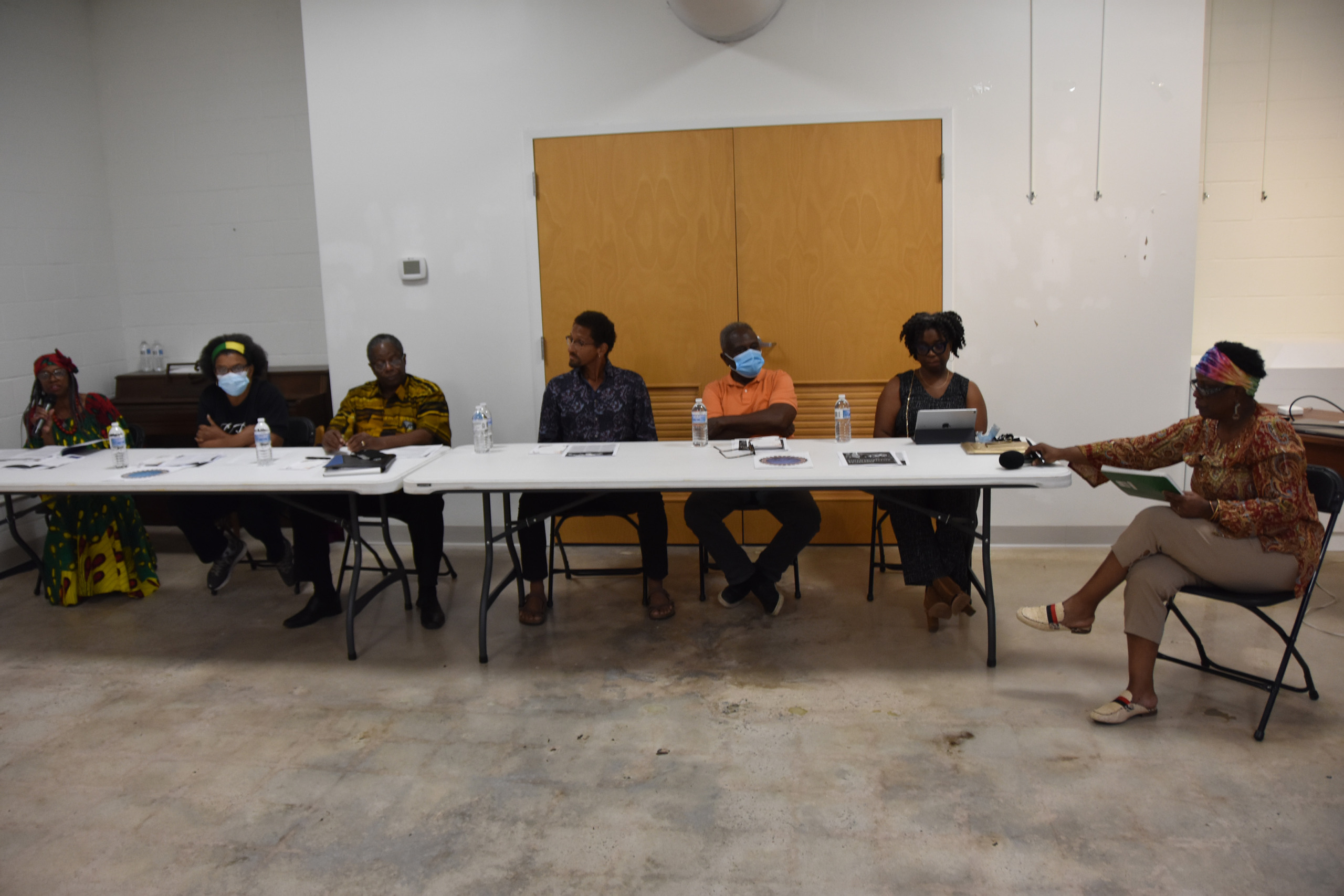
Panel Discussion of Memorial Design Plans. The discussion was moderated by La’Sheia Oubré (far right). Panel members included (from left to right) Lorna Beck, Organizer of Charleston CariFest; Karen Wright-Chisholm, CEO of the Jenkins Youth and Family Village; Jerome Harris, President of the Charleston Area Branch for the Association for the Study of African American Like and History; Raja-Léon Hamann, PhD student in Cultural and Social Anthropology at NYU; Dr. Wilmot Fraser, folklorist and historian; and Dr. Tamara Butler, Executive Director of the Avery Research Center for African American History and Culture. Photo Credit: Servant Emannu’el Branch
Visits to African American Burial Grounds
In addition to the May 2022 anniversary events in Charleston, we visited some of the African American burial grounds that have been the focus of Gullah Society and ASABG research and preservation efforts, including the Monrovia Cemeteries and the 88 Smith Street property.
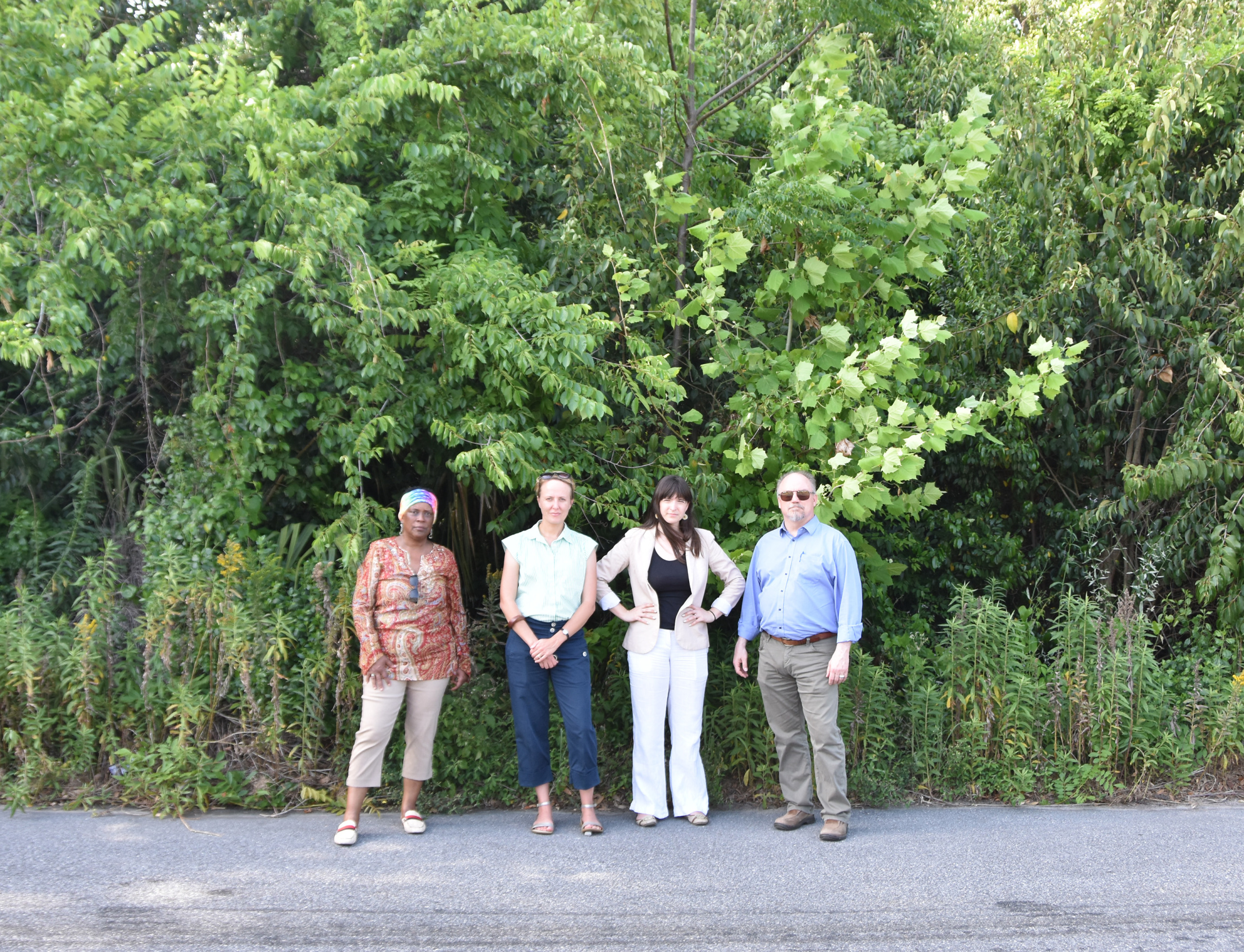
Visit to Monrovia Cemeteries. When visiting the Monrovia cemeteries in 2019, some of the brush and trees that had covered these burial grounds had been cut back, thereby allowing walking access to the burial plots and making some of the grave markers visible from the road. By May 2022, the lack of attention to maintaining these cemeteries had resulted in significant overgrowth of the burial grounds such that grave stones or markers could not be seen from the road. Photo Credit: Servant Emannu’el Branch
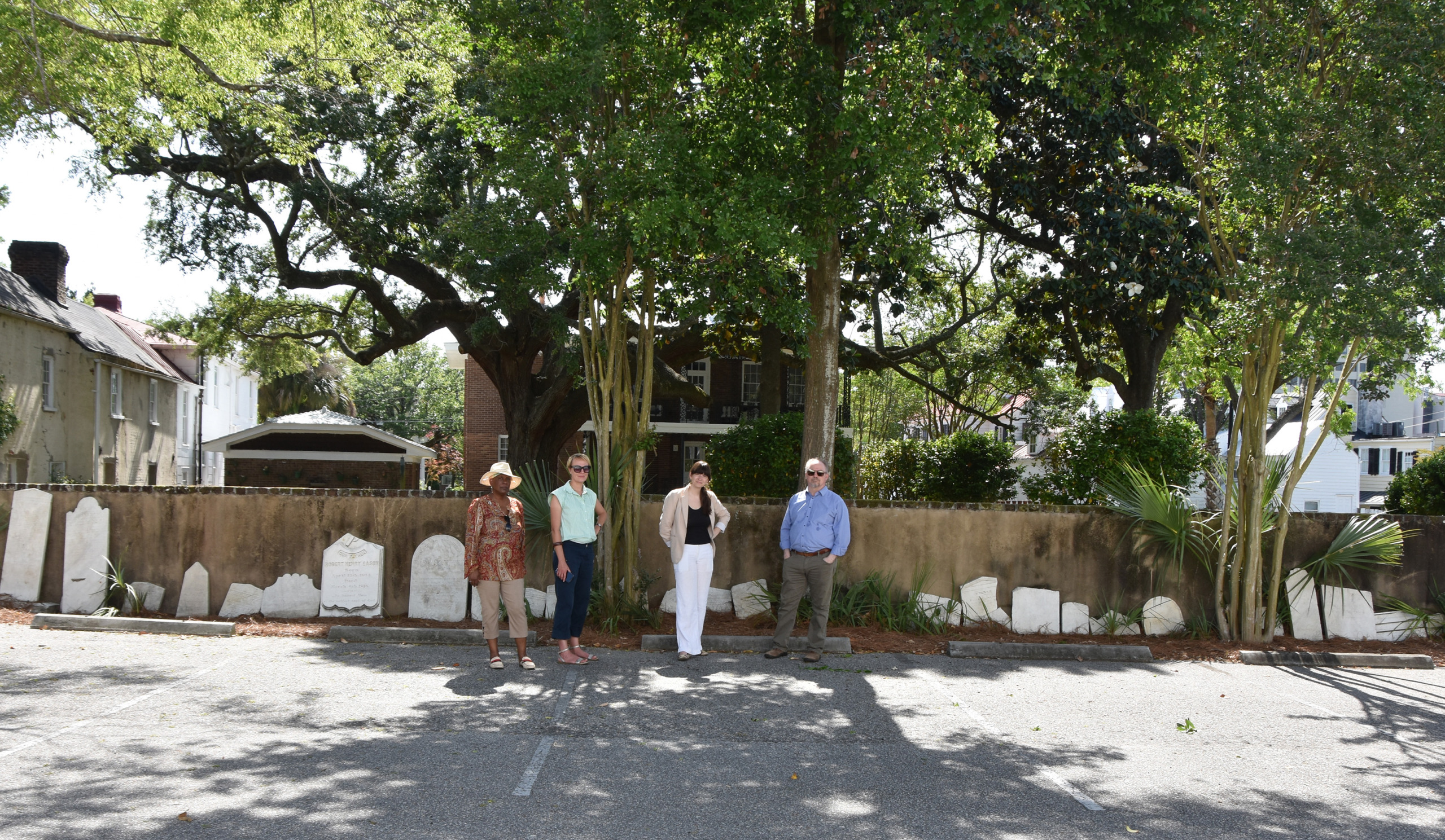
Visit to 88 Smith Street Property. The ASABG team also visited the 88 Smith Street property to see what had been done with it since the Gullah Society attempted to purchase it for its organizational headquarters in 2020. This property covers most of two cemeteries (Trinity Methodist Episcopal Colored and Ephrath Burial Grounds) which contain the burials of over 3500 individuals, with some extending under the parking lot for the Holy Trinity Reformed Episcopal Church, where the ASABG team is standing in the photo. See additional background information above. The headstones for a number of individuals are resting against the wall separating 88 Smith Street from the church property, and numerous others remain on the 88 Smith Street property, which remains privately owned. Photo Credit: Servant Emannu’el Branch
ASABG Team Activities
In addition to the reinterment events in May 2022, the ASABG team engaged in other activities designed to further its organizational and project goals.
On 3 May, Dr. Tonya Matthews, CEO, gave the ASABG team and its supporters a tour of the IAAM, which is currently under construction but slated to open to the public in October 2022. The Gullah Society/ASABG team are contributing to the exhibit for Gullah-Geechee cultural heritage in the IAAM.

Tour of International African American Museum (IAAM). Tour attendees included (from left to right) Grant Gilmore III, T.G. Schurr, Tonya Matthews (IAAM Director), Ervin McDaniel, Debra McDaniel, La’Sheia Oubré, Raja-Léon Hamann, Julia Campbell, and Raquel Fleskes. Photo Credit: Servant Emannu’el Branch
On 5 May, the ASABG team also presented an overview of its research, community outreach and burial ground mapping work to faculty at MUSC, and discussed possible avenues of collaboration with researchers there.
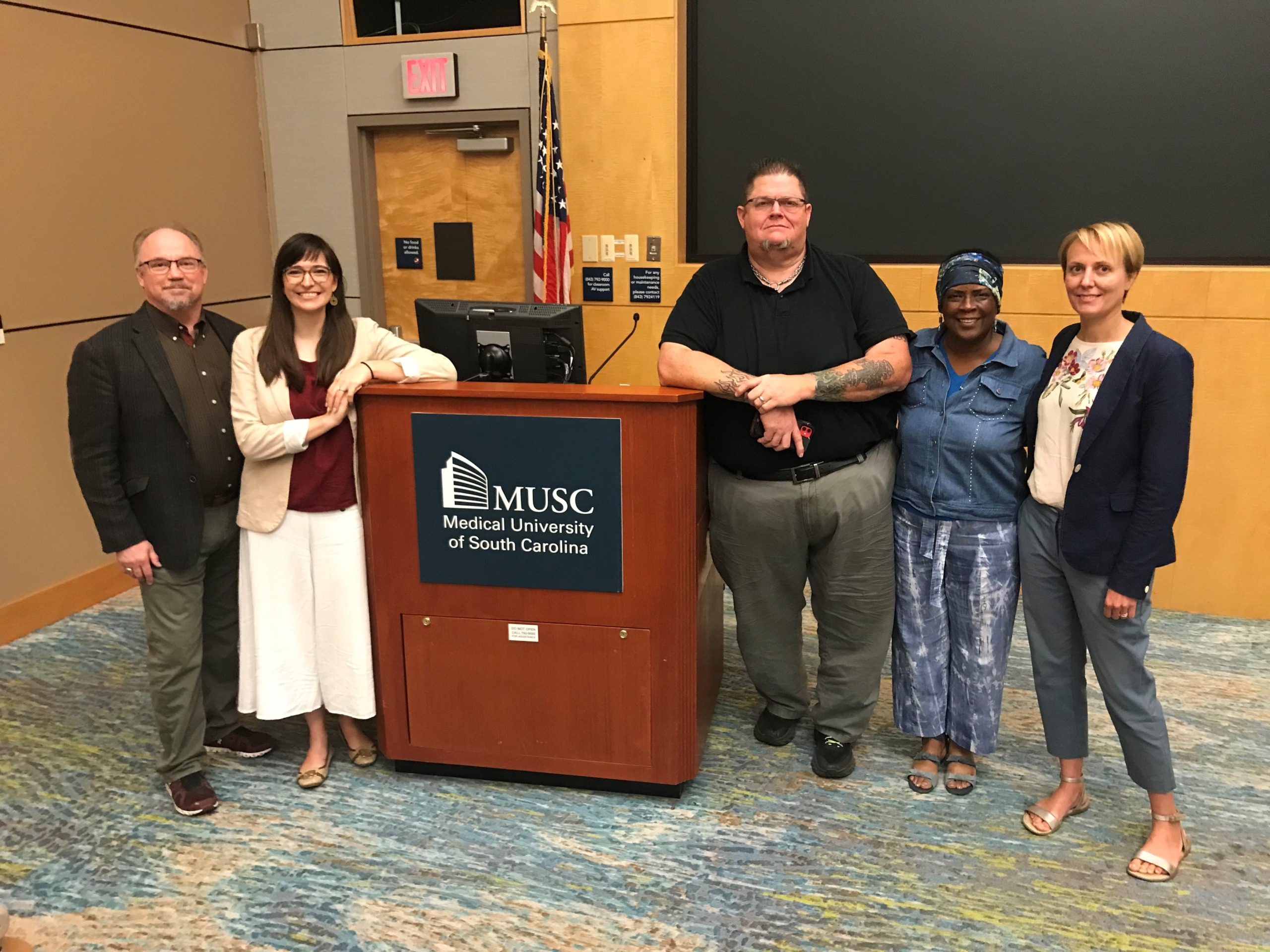
Presentation at the Medical University of South Carolina (MUSC). ASABG team members include (from left to right) T.G. Schurr, Raquel Fleskes, Grant Mishoe, La’Sheia Oubré, and Joanna Gilmore. Photo credit: Dr. Paula Ramos
2023 ASABG Activities
2024 ASABG Activities
Collaborators and Support
We would like to recognize a large number of people for their involvement in and support of this historically significant, multiyear project. Without the involvement in many people, this project would never have been started let alone been developed in the ways described above.
To begin, we would like to thank all of the members of the Charleston African American community who supported this study, and the members of the Gullah Society, for their tireless efforts to make this research successful. This project continues to benefit from its engagement with local community members and consultation with them about various aspects of our study results.
We are also grateful for the support of The City of Charleston, including Mayors Joseph Riley and John Tecklenburg; City Attorney, Susan Herdina; Senior Construction Project Manager, Peter Hedegor; Special Assistant for Quality of Life and Community Outreach, Mike Whack; Senior Advisor, Rick Jerue; Clerk of the Council, Vanessa Turner Maybank; and Director of Parks, Jason Kronsberg.
For their facilitation of this project, we further thank genealogist, Dr. Ramona LaRoche; archeologists, Taryn Ricciardelli and Jeremy Miller; the Rev. Willie Hill, Pastor at St. John’s Reformed Episcopal Church; and Mark Fielding, of Fielding’s Funeral Home. We also thank Dr. Eric Poplin (Brockington and Associates), Dr. Nic Butler (Charleston County Public Library), Megan Coller-Bansil (Redux Contemporary Arts Center), and Shawn Halifax (Charleston County Park and Recreation Commission) for their contributions to the public education and research components of this project.
For their assistance with the genetic analyses, we thank Dr. Veronica Brown from the University of Tennessee-Knoxville (UTK) Genomics Core Facility and Mr. Joe May from the UTK Division of Biology Sequencing Facility; Dr. Jonathan Schug from the University of Pennsylvania’s Next-Generation Sequencing Core; and Dr. Philip Johnson from the University of Maryland for his assistance with his ContamMix program. In addition, we thank Dr. Brenna Henn from the University of California-Davis and Dr. Iain Mathieson from the University of Pennsylvania for assistance with the genomic analyses.
We further thank Dr. Douglas Owsley from the Smithsonian Institution for his consultation on Amina’s (CHS10) dental modification, and Sara E. Platt for her archival research on tooth modifications in the Accessible Archives. We are especially grateful to Dr. Miguel Vilar from the National Geographic Society for facilitating project work through both logistical support and financial guidance.
Funding
Project research over past eight years has been supported by numerous different awards to project members and collaborators. These awards have come from the National Geographic Society (#NGS-52378R-18 to Ade A. Ofunniyin; #NGS-54324E-18 to Joanna Gilmore; and #EC-52936R-18 to Adeyemi Oduwole), the National Science Foundation (SPRF-FR 2105384 to Raquel Fleskes; BCS-2045308 to Cecil Lewis and Tanvi Honap), the Penn University Research Foundation (Theodore G. Schurr), the Penn Dissertation Completion Fellowship program (Raquel Fleskes), the University of Tennessee Department of Anthropology (Graciela S. Cabana), The City of Charleston (Ade A. Ofunniyin, Joanna Gilmore), The Gullah Society, Inc. (Ade A. Ofunniyin, Joanna Gilmore), the Coastal Community Foundation (Ade A. Ofunniyin, Joanna Gilmore), and the Donnelly Foundation (Ade A. Ofunniyin, Joanna Gilmore).
Acknowledgments
Most importantly, we are grateful for having had the opportunity to learn from the Ancestors: Banza, Ola, Lima, Kuto, Yawo, Babatunde, Leke, Mbangi, Anika, Nana, Ulume, Zimbu, Juba, Talata, Wuta, Daba, Omo, Fumu, Nina, Kwebena, Lisa, Ganda, Coosaw, Kiana, Risu, Amina, Kidzera, Pita, Ori, Tima, Rere, Jode, Ajana, Pele, Isi, and Welela. This work is conducted in their memory. Àse!*
* Àse is an African philosophical concept through which the Yoruba of Nigeria conceive the power to make things happen and produce change (Vega, 1999).
Publications
Fleskes RE, Gilmore JK, Oubré L, Ofunniyin AA, Cabana G, Schurr TG. 2025. Immersive videography of ancient DNA extraction methods for community engagement and educational initiatives by the Anson Street African Burial Ground Project. Am J Biol Anthropol 186(1):e25055. Link
Gilmore JA, Ofunniyin AA, Oubré OL, Fleskes RE, Schurr TG. 2024. “The dead have been awakened in the service of the living”: Activist community-engaged archaeology in Charleston, SC. Amer Antiq 89(2):165–184. Link
Fleskes RE, Johnson SJ, TP Honap, Abin CA, Gilmore JK, Oubré L, Bueschgen W, Abel S, Ofunniyin AA, Lewis CM, Schurr TG. 2024. Oral health and microbiome diversity in 18th-century African descended individuals from Charleston, South Carolina. Commun Biol 7:1213. Link
Fleskes RE, Cabana GS, Gilmore JK, Suarez C, Karcher E, Oubré L, Ofunniyin AA, Schurr TG. 2023. Community engaged ancient DNA project reveals diverse origins of 18th century African descendants in Charleston, South Carolina. Proc Natl Acad Sci USA 120(3):e2201620120. Link
Fleskes RE, Ofunniyin AA, Gilmore J, Poplin E, Abel S, Juarez C, Bueschgen W, Butler N, Mishoe G, Oubré L, Cabana G, Schurr TG. 2021. Bioarcheological and genetic analysis of Anson Street burials and the legacy of slavery in Charleston, SC. Am J Phys Anthropol 175(1):3-24. Link
Several more manuscripts are currently under review, in preparation for submission to a peer-reviewed journal, or being developed for publication as books.
ASABG Project Work
For more information about our project work, please visit the ASABG website: https://www.asabgproject.com/
Laboratory of Molecular Anthropology
University of Pennsylvania
421 University Museum
3260 South Street
Philadelphia, PA 19104-6398
Tel: 215-573-2656

FOLOW US:
